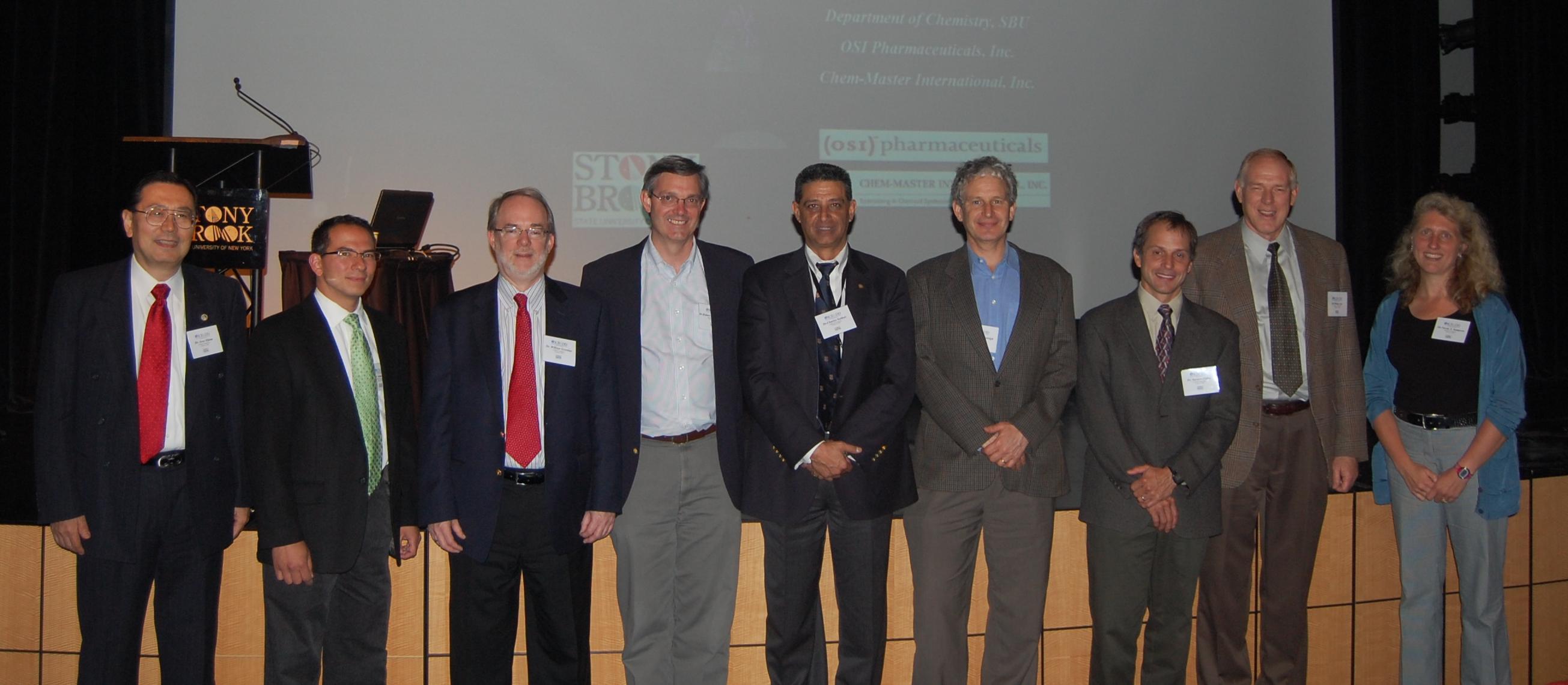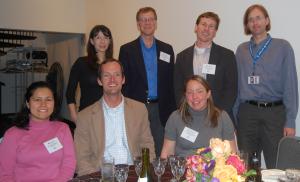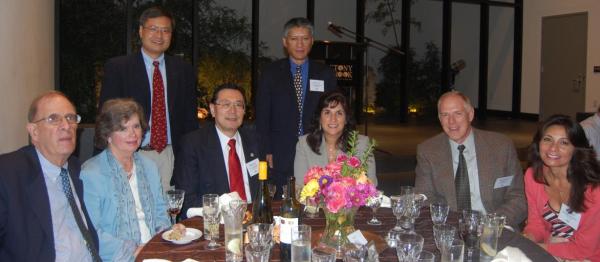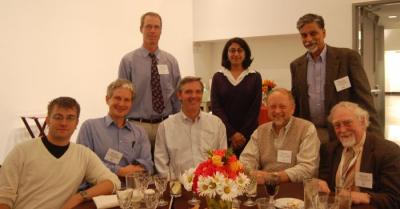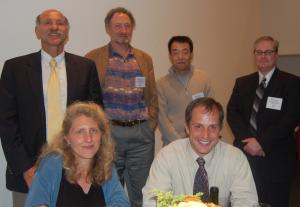ICB&DD SYMPOSIUM
ICB&DD Eighteenth Annual Symposium (2024)
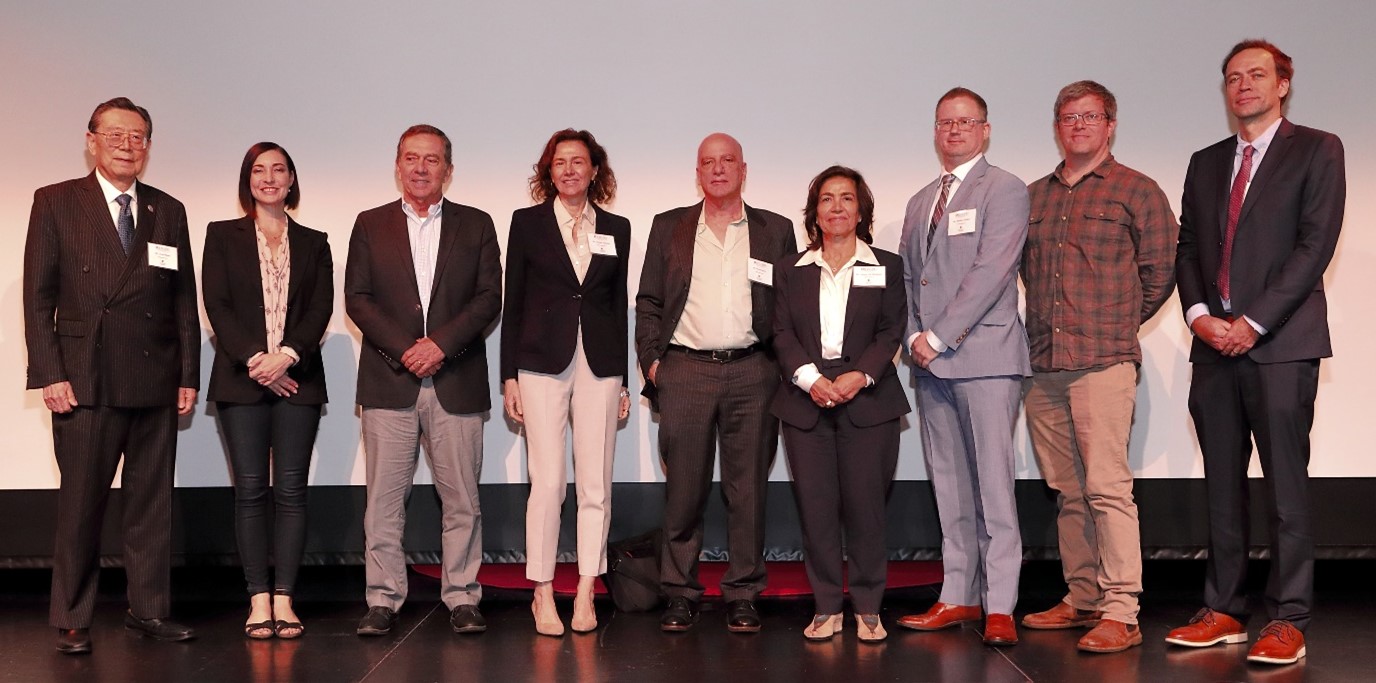
The ICB&DD hosted its eighteen annual symposium on “Frontiers of Neuroscience and Drug Discovery” on Thursday October 10, 2024 in the Charles B. Wang Center. The ICB&DD Symposium has a 17-year history since its inauguration dating back to October 12, 2007. The Symposium featured seven Plenary Lecturers. Four of them were highly regarded scientists from outside institutions and three of them representing the Stony Brook University Renaissance School of Medicine as well as The Laufer Center and Stony Brook University. The event was attended by a diverse audience composed of faculty, research staff and students on campus. The Poster Session equally attracted participation from students representing various departments on campus. There were 73 outstanding scientific posters presented at the Poster Session.
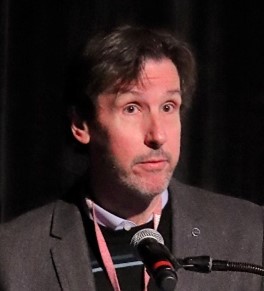 This year the symposium organizing committee was composed of two co-chairs: Drs. Alfredo
Fontanini, Professor and Chair of the Department of Neurobiology and Behavior and
Anissa Abi-Dargham, Distinguished Professor and Chair of the Department of Psychiatry.
Dr. Fontanini welcomed the attendees and presented the opening remarks. He emphasized
the importance of the annual ICB&DD symposium and commended the arduous work of Professor
Ojima to continue providing this valuable opportunity to bring prominent scholars
who can share their cutting-edge research endeavors and exchange creative ideas among
speakers, faculty and students on campus. He thanked the invited speakers for coming
to give a lecture at Stony Brook and the organizing committee for their efforts. He
then went on to explain the focus of this year’s symposium, emphasizing the importance
of drug development for neuropsychiatric and neurological disorders. Especially in
today’s emerging field of neuroscience, particular attention has been given to diseases
of the brain. The exceptional line-up of speakers in this year’s Symposium are world-renowned
scholars in neuroscience and experts in translating discoveries into medical advances.
They will share their research accomplishments and latest discoveries in cognition,
mood disorders, schizophrenia, autism and drug addiction as well as imaging of neurodegenerative
diseases. These are very important topics in science and medicine. The ICB&DD Annual
symposium in neuroscience and drug discovery will create an opportunity to exchange
knowledge and creative ideas among faculty from different departments as well as stimulate
campus-wide collaborative research in drug discovery.
This year the symposium organizing committee was composed of two co-chairs: Drs. Alfredo
Fontanini, Professor and Chair of the Department of Neurobiology and Behavior and
Anissa Abi-Dargham, Distinguished Professor and Chair of the Department of Psychiatry.
Dr. Fontanini welcomed the attendees and presented the opening remarks. He emphasized
the importance of the annual ICB&DD symposium and commended the arduous work of Professor
Ojima to continue providing this valuable opportunity to bring prominent scholars
who can share their cutting-edge research endeavors and exchange creative ideas among
speakers, faculty and students on campus. He thanked the invited speakers for coming
to give a lecture at Stony Brook and the organizing committee for their efforts. He
then went on to explain the focus of this year’s symposium, emphasizing the importance
of drug development for neuropsychiatric and neurological disorders. Especially in
today’s emerging field of neuroscience, particular attention has been given to diseases
of the brain. The exceptional line-up of speakers in this year’s Symposium are world-renowned
scholars in neuroscience and experts in translating discoveries into medical advances.
They will share their research accomplishments and latest discoveries in cognition,
mood disorders, schizophrenia, autism and drug addiction as well as imaging of neurodegenerative
diseases. These are very important topics in science and medicine. The ICB&DD Annual
symposium in neuroscience and drug discovery will create an opportunity to exchange
knowledge and creative ideas among faculty from different departments as well as stimulate
campus-wide collaborative research in drug discovery.
Dr. Fontanini then introduced Dr. Iwao Ojima, Distinguished Professor of Chemistry and Director of the ICB&DD who gave an overview of the Institute, its history and mission in his welcoming remarks.
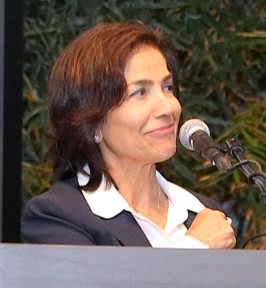 Dr. Markus Riessland, Associate Professor in the Department of Neurobiology and Behavior,
introduced the first Plenary Lecturer, Dr. Anissa Abi-Dargham, a Distinguished Professor of the Department of Psychiatry and Behavioral Health
in the Stony Brook Renaissance School of Medicine who gave a lecture titled “Molecular
Targets and Associated Functional Domains in Schizophrenia”. In her lecture Dr. Abi-Dargham
presented her long-time research in schizophrenia, a chronic debilitating illness
and a global brain disease that strikes people in adolescence and early adulthood.
Currently, there is no cure for schizophrenia but pharmacological treatment. Essentially,
every system in the brain is affected by this disease. Her research studies are mostly
interested in cortical basal ganglia, the domains of function that interact with every
system in the brain. She described the importance of molecular information with functional
MRI to measure clinical symptoms to identify targets and biomarkers as well as therapeutic
processes.
Dr. Markus Riessland, Associate Professor in the Department of Neurobiology and Behavior,
introduced the first Plenary Lecturer, Dr. Anissa Abi-Dargham, a Distinguished Professor of the Department of Psychiatry and Behavioral Health
in the Stony Brook Renaissance School of Medicine who gave a lecture titled “Molecular
Targets and Associated Functional Domains in Schizophrenia”. In her lecture Dr. Abi-Dargham
presented her long-time research in schizophrenia, a chronic debilitating illness
and a global brain disease that strikes people in adolescence and early adulthood.
Currently, there is no cure for schizophrenia but pharmacological treatment. Essentially,
every system in the brain is affected by this disease. Her research studies are mostly
interested in cortical basal ganglia, the domains of function that interact with every
system in the brain. She described the importance of molecular information with functional
MRI to measure clinical symptoms to identify targets and biomarkers as well as therapeutic
processes.
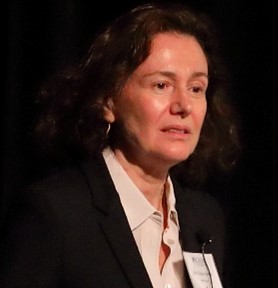 Dr. Markus Riessland also introduced the second Plenary Lecturer, Dr. Cristina Alberini,a Professor of Neural Science in the Center of Neural Science at New York University
who gave a lecture titled “From Bench to Bedside: Mechanisms of Long-Term Memory Inform
the Development of Novel Treatments for Neurodevelopmental Disorders and Neurodegenerative
Diseases”. Her lecture described her research studies and how it is focused on understanding
the molecular mechanisms underlying long term memory formation and the role of these
mechanisms in cognitive impairments, neurodevelopmental disorders and neurodegenerative
diseases. She discussed the efficacy of novel synthetic small molecules targeting
IGF2R that are effective memory enhancers in healthy rodents and reverse core deficits
of core deficits of Angelman syndrome in a mouse model.
Dr. Markus Riessland also introduced the second Plenary Lecturer, Dr. Cristina Alberini,a Professor of Neural Science in the Center of Neural Science at New York University
who gave a lecture titled “From Bench to Bedside: Mechanisms of Long-Term Memory Inform
the Development of Novel Treatments for Neurodevelopmental Disorders and Neurodegenerative
Diseases”. Her lecture described her research studies and how it is focused on understanding
the molecular mechanisms underlying long term memory formation and the role of these
mechanisms in cognitive impairments, neurodevelopmental disorders and neurodegenerative
diseases. She discussed the efficacy of novel synthetic small molecules targeting
IGF2R that are effective memory enhancers in healthy rodents and reverse core deficits
of core deficits of Angelman syndrome in a mouse model.
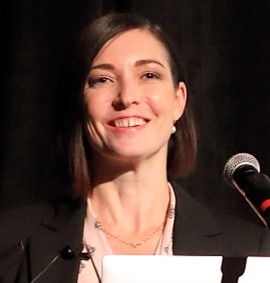 Dr. Markus Riessland also introduced the third Plenary Lecturer, Dr. Michelle James, Assistant Professor of Radiology, Neurology and Neurological Sciences, Stanford UniversitySchool of Medicine who gave a lecture titled: “Developing a PET Radiotracer Toolbox
for Advancing Understanding and Treatment of CNS Diseases”. She discussed the current
state-of-the-art for imaging immune responses in CNS diseases using positron emission
tomography (PET), and highlighted some key advances from her lab, including the development
of new radiotracers targeting the pro-inflammatory innate immune receptor GPR84. In
addition, she described the progress being made with other new and available tracers
for illuminating innate and adaptive immune responses in the preclinical and clinical research
settings.
Dr. Markus Riessland also introduced the third Plenary Lecturer, Dr. Michelle James, Assistant Professor of Radiology, Neurology and Neurological Sciences, Stanford UniversitySchool of Medicine who gave a lecture titled: “Developing a PET Radiotracer Toolbox
for Advancing Understanding and Treatment of CNS Diseases”. She discussed the current
state-of-the-art for imaging immune responses in CNS diseases using positron emission
tomography (PET), and highlighted some key advances from her lab, including the development
of new radiotracers targeting the pro-inflammatory innate immune receptor GPR84. In
addition, she described the progress being made with other new and available tracers
for illuminating innate and adaptive immune responses in the preclinical and clinical research
settings.
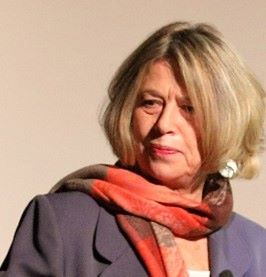 Dr. Matthew Parker, Assistant Professor in the Department of Psychiatry and Behavioral Health,
introduced the fourth Plenary Lecturer, Dr. Ivet Bahar, the Louis and Beatrice Laufer Endowed Chair and Director of the Laufer Center for
Physical and Quantitative Biology. Professor, Department of Biochemistry and Cell
Biology, Renaissance School of Medicine, Stony Brook University. Dr. Bahar gave a
lecture titled: “Signature Dynamics of Neurotransmitter Transporters and Modulation
of their Function: Insights from In Silico Studies”. Her research laboratory group
conducts integrative research across multiple disciplines, from basic modeling of
biomolecular dynamics and interactions, to identifying disease-causing mutations and
developing drug candidates and therapeutic strategies for complex diseases, including
cancer and neurological disorders. In her lecture she described her laboratory studies
have focused on two groups of transporters in particular, dopamine transporters, and
excitatory amino acid transporters, toward gaining their evolutionarily conserved
structural and dynamic features and developing specific and potent modulators of their activity.
She discussed her recent progress in this field, including the characterization of
the signature dynamics of these transporters, as well as the discovery of new allosteric
modulators.
Dr. Matthew Parker, Assistant Professor in the Department of Psychiatry and Behavioral Health,
introduced the fourth Plenary Lecturer, Dr. Ivet Bahar, the Louis and Beatrice Laufer Endowed Chair and Director of the Laufer Center for
Physical and Quantitative Biology. Professor, Department of Biochemistry and Cell
Biology, Renaissance School of Medicine, Stony Brook University. Dr. Bahar gave a
lecture titled: “Signature Dynamics of Neurotransmitter Transporters and Modulation
of their Function: Insights from In Silico Studies”. Her research laboratory group
conducts integrative research across multiple disciplines, from basic modeling of
biomolecular dynamics and interactions, to identifying disease-causing mutations and
developing drug candidates and therapeutic strategies for complex diseases, including
cancer and neurological disorders. In her lecture she described her laboratory studies
have focused on two groups of transporters in particular, dopamine transporters, and
excitatory amino acid transporters, toward gaining their evolutionarily conserved
structural and dynamic features and developing specific and potent modulators of their activity.
She discussed her recent progress in this field, including the characterization of
the signature dynamics of these transporters, as well as the discovery of new allosteric
modulators.
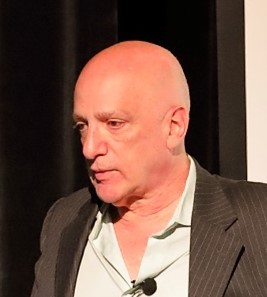 Dr. Matthew Parker also introduced the fifth Plenary Lecturer, Dr. David Sulzer, a Professor of Neurobiology in Psychiatry, Neurology and Pharmacology at Columbia University
Irving Medical Center who gave a lecture titled “Autoimmunity in Parkinson’s Disease
and Potential New Treatments”. He discussed that, even though Parkinson’s disease
is caused by cell death in the brain, which is still unknown, there is some evidence that
Parkinson’s disease may have autoimmune features that are initiated in the gut, with specific
T cells. These specific T cells are transported from the gut via the blood vessels
to the CNS in the brain. This also includes cells reactive to antigens derived from
the Parkinson’s-related genes, alpha-synuclein and PINK1. He also discussed evidence
supporting treatment by axonal reinnervation of surviving dopamine neurons into depleted
regions by pharmacological and other methods that may provide clinical approaches
even for later stage patients.
Dr. Matthew Parker also introduced the fifth Plenary Lecturer, Dr. David Sulzer, a Professor of Neurobiology in Psychiatry, Neurology and Pharmacology at Columbia University
Irving Medical Center who gave a lecture titled “Autoimmunity in Parkinson’s Disease
and Potential New Treatments”. He discussed that, even though Parkinson’s disease
is caused by cell death in the brain, which is still unknown, there is some evidence that
Parkinson’s disease may have autoimmune features that are initiated in the gut, with specific
T cells. These specific T cells are transported from the gut via the blood vessels
to the CNS in the brain. This also includes cells reactive to antigens derived from
the Parkinson’s-related genes, alpha-synuclein and PINK1. He also discussed evidence
supporting treatment by axonal reinnervation of surviving dopamine neurons into depleted
regions by pharmacological and other methods that may provide clinical approaches
even for later stage patients.
 Dr. Matthew Parker also introduced the sixth Plenary Lecturer, Dr. Iván Montoya, Director, Division of Therapeutics and Medical Consequences at the National Institute
on Drug Abuse (NIDA) who gave a lecture titled “Advances in the Development of Therapeutics
for Substance Use Disorders (SUD’s)”. He described the crisis in the drug overdose
abuse in the US with the number of deaths being around 107,543 annually throughout
the country. The Division of Therapeutics and Medical Consequences at the National
Institute on Drug Abuse was created in 1989 as a result of the worst cocaine and crack
crisis in the US. One of the missions of this division is to use science as a vehicle to
improve treatments for substance abuse disorders. This approach goes beyond pharmacotherapy
intervention and viral vaccines and monoclonal antibodies as well as neuromoduladory
devices and behavioral intervention for the prevention or treatment of SUDs and overdose.
He presented a general overview of what the institute is doing in all those areas.
Their goal is to provide thorough information about the potential therapeutics that
may be available in the future arsenal of treatments for SUDs.
Dr. Matthew Parker also introduced the sixth Plenary Lecturer, Dr. Iván Montoya, Director, Division of Therapeutics and Medical Consequences at the National Institute
on Drug Abuse (NIDA) who gave a lecture titled “Advances in the Development of Therapeutics
for Substance Use Disorders (SUD’s)”. He described the crisis in the drug overdose
abuse in the US with the number of deaths being around 107,543 annually throughout
the country. The Division of Therapeutics and Medical Consequences at the National
Institute on Drug Abuse was created in 1989 as a result of the worst cocaine and crack
crisis in the US. One of the missions of this division is to use science as a vehicle to
improve treatments for substance abuse disorders. This approach goes beyond pharmacotherapy
intervention and viral vaccines and monoclonal antibodies as well as neuromoduladory
devices and behavioral intervention for the prevention or treatment of SUDs and overdose.
He presented a general overview of what the institute is doing in all those areas.
Their goal is to provide thorough information about the potential therapeutics that
may be available in the future arsenal of treatments for SUDs.
 Dr. Matthew Parker also introduced the seventh and final Plenary Lecturer, Dr. Scott Laughlin,Associate Professor of Chemistry, Stony Brook University who presented a lecture titled
“Targeting Astrocytes Across the Blood Brain Barrier”. The research group of Dr.
Laughlin focuses on using chemistry to understand the architecture of the brain's
functional units called neural circuits. In one such project, his research laboratory
has identified a chemical scaffold that enables visualization of astrocytes and neuron-interacting
astrocytes in the brains of both mammals and zebrafish. Dr. Laughlin discussed this
new class of chemical astrocyte label and its ability to cross the blood brain barrier,
which enables new applications for these compounds in the fields of drug delivery
and human brain imaging.
Dr. Matthew Parker also introduced the seventh and final Plenary Lecturer, Dr. Scott Laughlin,Associate Professor of Chemistry, Stony Brook University who presented a lecture titled
“Targeting Astrocytes Across the Blood Brain Barrier”. The research group of Dr.
Laughlin focuses on using chemistry to understand the architecture of the brain's
functional units called neural circuits. In one such project, his research laboratory
has identified a chemical scaffold that enables visualization of astrocytes and neuron-interacting
astrocytes in the brains of both mammals and zebrafish. Dr. Laughlin discussed this
new class of chemical astrocyte label and its ability to cross the blood brain barrier,
which enables new applications for these compounds in the fields of drug delivery
and human brain imaging.
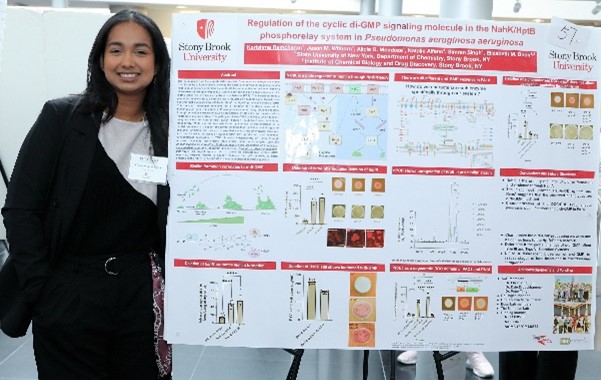
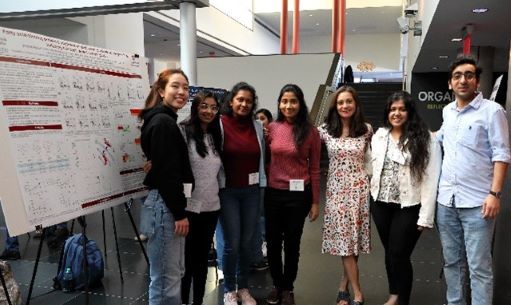
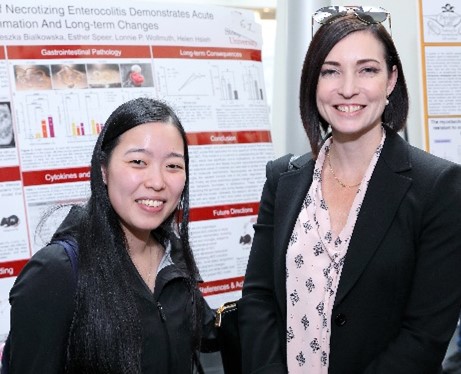
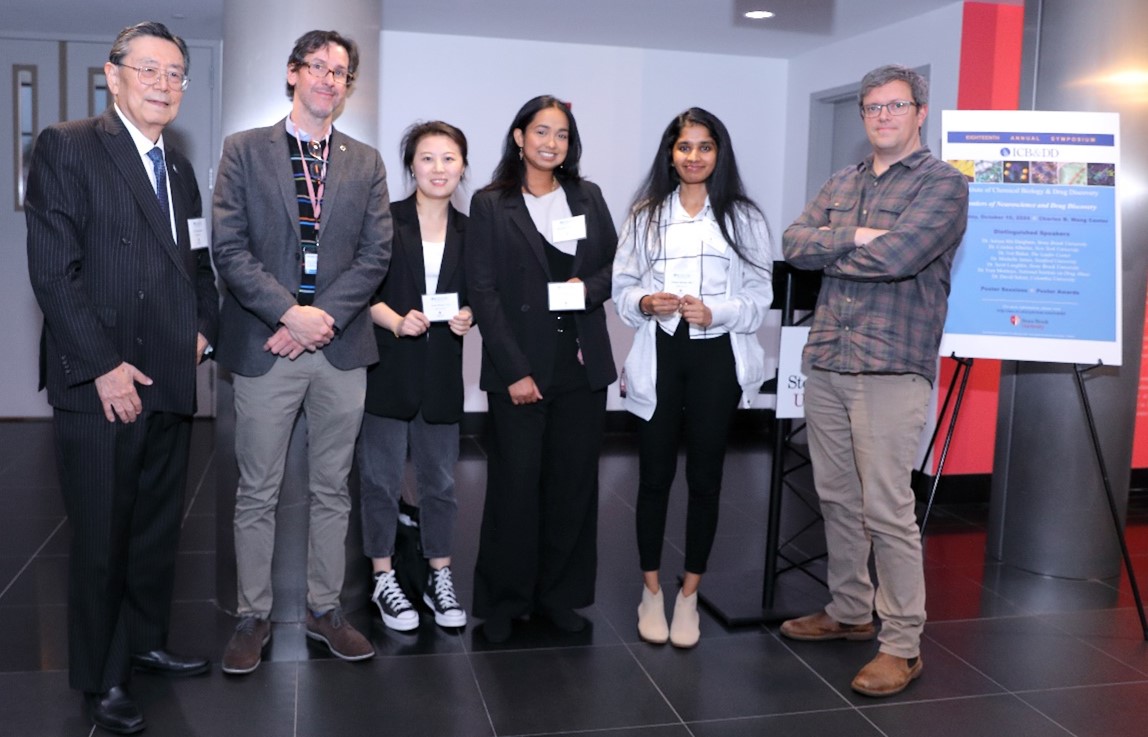 Seventy-three posters were presented in two poster sessions during the symposium and
three posters were selected for Outstanding Poster Awards and presentation in the
final session of the symposium. Dr. Scott Laughlin, Chair of the Poster Session, presented
the awards to Yanzuo Liu, a graduate student in the laboratory of Dr. Congwu Du in the Department of Biomedical
Engineering, for her poster titled “Astrocytic Excitation Blunts Hemodynamic Reactivity
but Has no Effects On Neuro-Reactivity to Cocaine in the Prefrontal Cortex ”, Karishma Ramcharan, a graduate student in the laboratory of Dr. Elizabeth Boon in the Department of
Chemistry for her poster titled “Regulation of the cyclic di-GMP signaling molecule
in the NahK/HptB phosphorelay system in Pseudomonas Aeruginosa ”, and Oshini P Haputhanthrige Don, Dr. Scott Laughlin’s laboratory in the Department of Chemistry for her poster titled
“Re-engineering Current Therapeutics with a Methyl Pyridinium in the Treatment of
Glioblastoma ”. Each of the winners was awarded a check in the amount of $250, an
award certificate and all of them were invited to attend the Symposium dinner with
the Plenary Lecturers and ICB&DD faculty.
Seventy-three posters were presented in two poster sessions during the symposium and
three posters were selected for Outstanding Poster Awards and presentation in the
final session of the symposium. Dr. Scott Laughlin, Chair of the Poster Session, presented
the awards to Yanzuo Liu, a graduate student in the laboratory of Dr. Congwu Du in the Department of Biomedical
Engineering, for her poster titled “Astrocytic Excitation Blunts Hemodynamic Reactivity
but Has no Effects On Neuro-Reactivity to Cocaine in the Prefrontal Cortex ”, Karishma Ramcharan, a graduate student in the laboratory of Dr. Elizabeth Boon in the Department of
Chemistry for her poster titled “Regulation of the cyclic di-GMP signaling molecule
in the NahK/HptB phosphorelay system in Pseudomonas Aeruginosa ”, and Oshini P Haputhanthrige Don, Dr. Scott Laughlin’s laboratory in the Department of Chemistry for her poster titled
“Re-engineering Current Therapeutics with a Methyl Pyridinium in the Treatment of
Glioblastoma ”. Each of the winners was awarded a check in the amount of $250, an
award certificate and all of them were invited to attend the Symposium dinner with
the Plenary Lecturers and ICB&DD faculty.
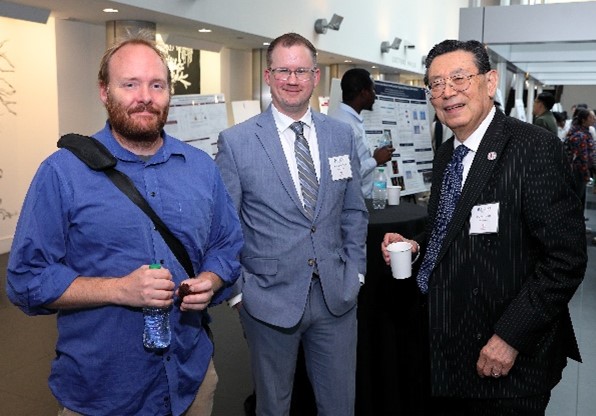

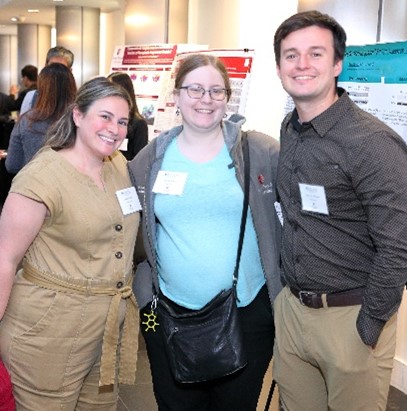
The Eighteenth ICB&DD Annual Symposium culminated with a wonderful dinner at the East Hall of the Charles B. Wang Center. Among the attendees were Drs. Stanislaus Wong, Chair of the Department of Chemistry and Kevin Gardner, Vice-President for Research. The co-chair of the symposium organizing committee, Dr. Anissa Abi-Dargham as well as Stanislaus Wong, and Kevin Gardner expressed their appreciation for the outstanding lectures presented at the symposium. They all acknowledged the significance of the ICB&DD and the collaborative efforts among academia and industry. They also commended Dr. Ojima for his successful leadership, the ICB&DD operation and eighteen year-long cutting-edge symposia. The ICB&DD symposium is widely recognized for being the leading event on campus. It has been historically providing an opportunity to exchange knowledge and creative ideas among faculty from different departments as well as to stimulate campus-wide collaborative research in drug discovery. Dr. Ojima presented Appreciation Plaques to this year’s Symposium co-chairs, Alfredo Fontanini and Anissa Abi-Dargham.
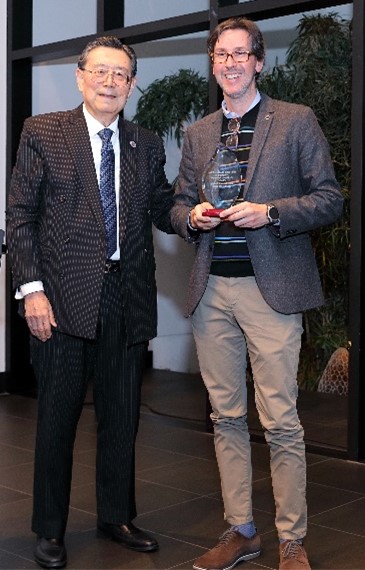
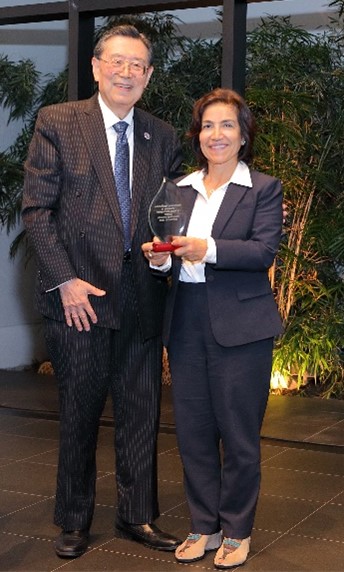 Drs., Alfredo Fontanini and Anissa Abi-Dargham
Drs., Alfredo Fontanini and Anissa Abi-Dargham
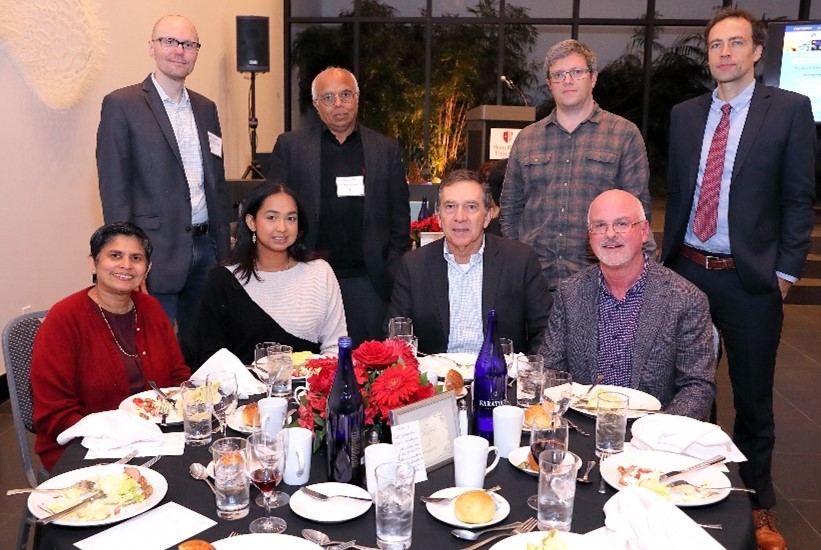
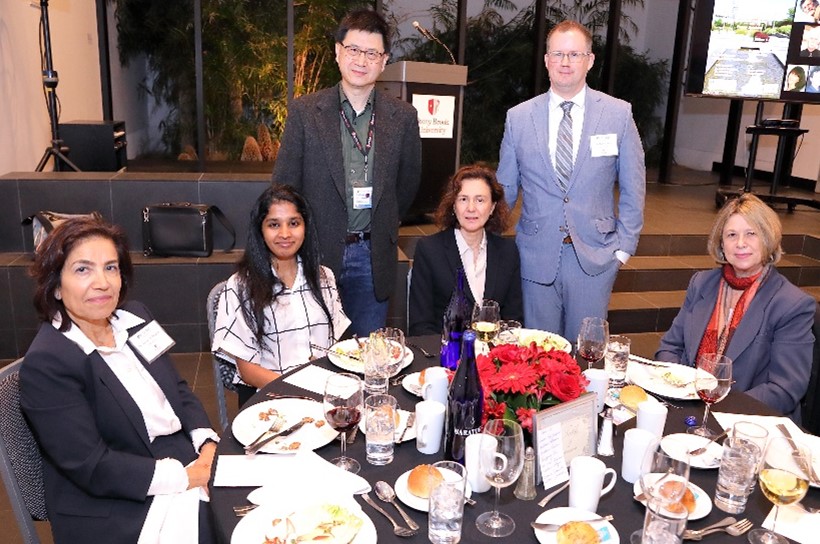
Drs., Stanislaus Wong Chair, Department of Chemistry and Kevin Gardner, University Vice-President for Research gave the remarks at the ICB&DD Annual Symposium dinner
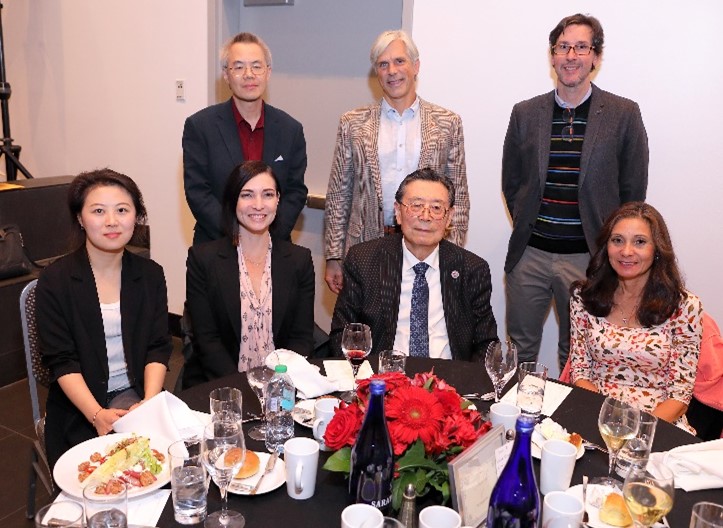
The 18th Annual Symposium of the ICB&DD was sponsored by the Office of the Vice President for Research, the Renaissance School of Medicine, the Department of Neurobiology and Behavior, Department of Psychiatry and Behavioral Health, Department of Chemistry, Targagenix Inc., Hoffman and Baron LLP., and Chembio Diagnostics Systems Inc.
ICB&DD Seventeenth Annual Symposium (2023)
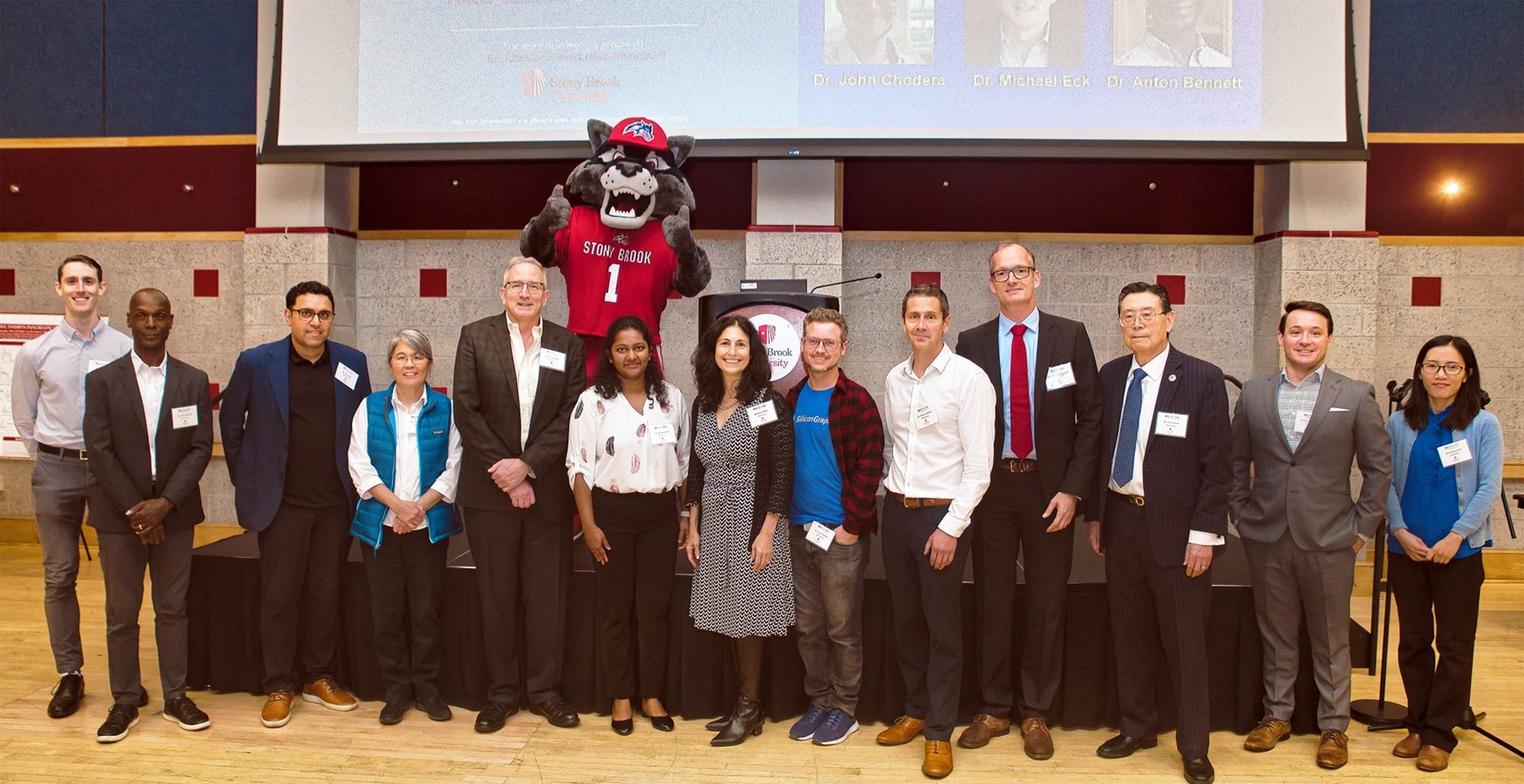
The ICB&DD hosted its seventeenth annual symposium on “Frontiers in Chemical Biology and Drug Discovery” on Thursday October 5, 2023 in the Students Activities Center. The Symposium featured seven renowned plenary lecturers to present and share their expertise in their field of chemical biology and drug development. The event was attended by a wide audience composed of faculty, research staff and students on campus. The poster session equally attracted participation from students representing several departments on campus. There were 58 scientific posters presented at the poster session. The ICB&DD Symposium has a 16-year history since its inauguration dating back to October 12, 2007.
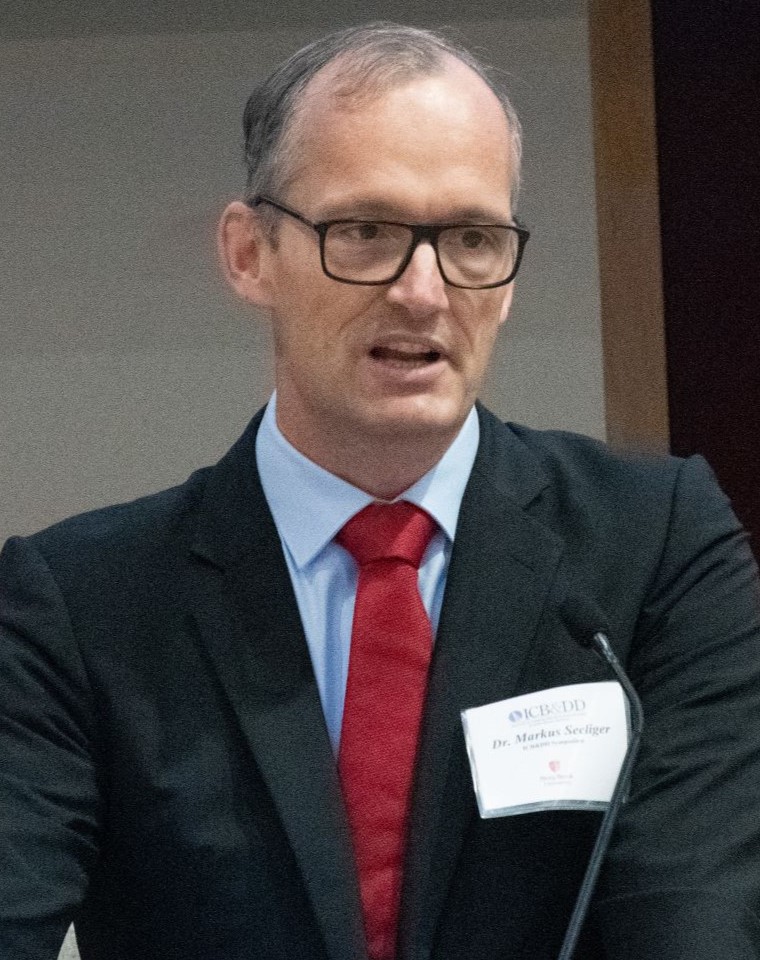 Dr. Markus Seeliger, Professor of Pharmacological Sciences and Chair of the Symposium
Organizing Committee welcomed the attendees and introduced Executive Vice President
and Provost Carl Lejuez to give the opening
Dr. Markus Seeliger, Professor of Pharmacological Sciences and Chair of the Symposium
Organizing Committee welcomed the attendees and introduced Executive Vice President
and Provost Carl Lejuez to give the opening remarks. Dr. Lejuez’s greetings remarks highlighted the importance of a multi-interdisciplinary
entity on campus such as ICB&DD, which has a long lasting record of attracting some
of the best faculty to the Stony Brook University scientific community. Furthermore,
he commended Professor Iwao Ojima as director of ICB&DD, for his success in building
bridges in the campus research community. This has been a very important aspect of the mission of ICB&DD since its19 years of inception. This prestigious
symposium has been the venue to discuss cutting-edge scientific discoveries among
faculty and for students to share their research with the scientific community. Dr.
Seeliger then introduced Dr. Iwao Ojima, Distinguished Professor of
Chemistry and Director of the ICB&DD who gave an overview of the Institute, its history
and mission in his welcoming remarks.
Dr. Dongyan Tan, Assistant Professor of Pharmacological Sciences, introduced the
first Plenary Lecturer, Dr. Arvin Dar, a Professor in the Chemical Biology Program at Memorial Sloan Kettering Cancer Center
who gave a lecture titled “Targeting Cancer Pathways with Chemical Switches and Molecular Glues”. In his lecture Dr. Dar described the importance of understanding the structure and
mechanism of protein complexes in the RAS pathway through the development of tool
compounds and therapeutic leads for RASMAPK and WNT altered cancers.
The second Plenary Lecturer, Dr. Karen Allen, was introduced by Jason Withorn graduate student in the laboratory of Dr. Elizabeth
Boon and the chemical biology training program. Dr. Allen, a Professor and Chair of
the Department of Chemistry at Boston University gave a lecture titled “Leveraging Sequence and Structure to Unravel Specificity in Glycoconjugate Biosynthesis”. Dr. Allen explained how bioinformatic analyses reveal sequence signatures in pathway
glycosyl transferases (GTs) which allow the assignment of enzyme specificity and ultimately,
the identity of the glycans in bacteria. Dr. Allen’s research has focused on the elucidation
of enzyme mechanisms and the understanding of how nature has evolved new chemistries
from existing protein scaffolds.
The third Plenary Lecturer, Dr. Matthew Robers, was introduced by Dr. Peter Tonge, Distinguished Professor of Chemistry. Dr. Robers,
a Senior Research Scientist and Group Leader, Promega Corporation gave a lecture titled
“Exposing Novel Vulnerabilities and Drug Escape Mechanisms at Kinase Complexes in Cells. ” Dr. Robers described his research, focusing on the discovery of a few vulnerabilities
at the RAS/RAF signalosome and exploring novel mechanisms of engagement cooperativity
at biomolecular complexes in cells.
The fourth Plenary Lecturer, Dr. John Chodera, was introduced by Dr. Kenneth Dill , the Laufer Family Endowed Chair of Physical
and Quantitative Biology, and Distinguished Professor of the Departments of Physics,
Chemistry and Applied Mathematics. Dr. Chodera, an Associate Professor, Weill Cornell
School of Medical Sciences and Associate Member, Memorial Sloan Kettering Cancer Center
gave a lecture titled “The COVID Moonshot and Beyond: Accelerating Structure-Based Antiviral Discovery with
Open Science ”. Dr. Chodera’s research laboratory creates open science communities---such as (1)
the Open Force Field Initiative and Open Free Energy Consortium, (2) the COVID Moonshot
(which delivered a patent free COVID antiviral preclinical candidate into an IND-enabling
preclinical program funded by the Wellcome Trust). In his lecture he described how
these open sciences collaboration came to be with the aim of developing a low-cost,
patent-free, globally accessible safe drug with broad antiviral activity.
The fifth Plenary Lecturer, Dr. Natalie Ahn, was introduced by Dr. Lisa Marie Nisbett, Postdoctoral Research Associate in Pharmacological
Sciences. Dr. Ahn, Distinguished Professor in the Department of Biochemistry, University
of Colorado at Boulder gave a lecture titled “Allosteric Communication and Conformational Selection in the MAP kinase, ERK2 ”. In her lecture, Dr. Ahn described how ERK2 serves as a useful prototype to investigate
the importance of protein dynamics for kinase regulation and inhibitor action.
The sixth Plenary Lecturer, Dr. Michael Eck, was introduced by Ian Outhwaite, a PhD MD student in Dr. Markus Seeliger’s research group. Dr. Eck, a Professor at Harvard Medical School, Dana-Farber Cancer Institute gave a lecture titled “Mutant-Selective Allosteric Inhibitors for EGFR-Mutant Lung Cancer”. Dr. Eck described his research focused on the development of mutant-selective therapeutics targeting oncogenic kinases, include EGFR mutations in lung cancer, JAK2 mutations in myeloproliferative disorders, and BRAF alterations in diverse human cancers.
The seventh and final Plenary Lecturer, Dr. Anton Bennet, was introduced byDr. Julie Rageul, Research Assistant Professor of Pharmacological Sciences. Dr. Bennet,
the Dorys McConnell Dulberg Professor of Pharmacology at Yale University Medical School
gave a lecture entitled “Signaling by Protein Tyrosine Phosphatases in Disease – Pathways to Therapeutics”. In his lecture, Dr. Bennett described how his laboratory investigates the signaling
mechanisms of protein tyrosine phosphatases and how these enzymes are involved in
various human diseases and whether these enzymes can be targeted for therapeutic purposes.
His research is currently focusing on the links between protein tyrosine phosphatases
in metabolic diseases, chemical biology strategies to targeting these enzymes for
therapeutics and how phosphatases are involved in rare genetic disorders.
This year two students were selected to give a talk at the symposium and present their
research studies based on the abstract submitted on their posters as part of the poster
session. These students were Ian Outwaite from the laboratory of Dr. Markus Seeliger who talked about how their research team
developed a method to identify mixtures of chemical inhibitors that inhibited the
proteins they were trying to target but did not inhibit the proteins that they weren't
trying to target. This method may be helpful for other biomedical researchers who
want to understand what happens when a particular target or set of targets is inhibited.
Ian Outwaite also was a poster award winner.
Kalani Jayanetti from Dr. Iwao Ojima’s laboratory presented her research about brain-expressed FABPs,
which play a significant role in controlling endocannabinoid levels and synaptic signaling.
The study investigates the interactions between FABPs and various lipids, including
Epoxyeicosatrienoic acids (EETs) and the peroxisome proliferator-activated receptor
gamma agonist 15-deoxy-Δ12,14-Prostaglandin J2, revealing unique binding interactions
and highlighting FABPs as novel modulators of synaptic epoxyeicosatrienoic acid signaling
in the brain.
Fifty-eight posters were presented in two poster sessions during the symposium and
the best three posters were selected for Poster Awards. The award-winning posters
this year were presented by Dr. Jacob Houghton, Chair of the Posters Session, to Sweta Anantharaman a graduate studentfrom the research group of Dr. Elizabeth Boon for her poster titled: “The Role of the NosP associated Histidine Kinase NahK in Nitric Oxide-Stress Resistance
in Pseudomonas
aeruginosa” and Nipuni Gunawardhana from the research group of Dr. Scott Laughlinfor her poster titled: “Cell Specific Delivery of Small Molecule Cargo for Manipulating Astrocytes”. Also, Ian Outhwaite, a graduate student in the laboratory of Dr.
Markus Seeliger, for his poster titled “Death by a Thousand Cuts – Combining Kinase Inhibitors for Selective Target Inhibition
and Rational Multitargeting”. Each of the winners was awarded a check in the amount of $250, an award certificate
and all of them were invited to attend the Symposium dinner with the Plenary Lecturers and ICB&DD faculty.
The Seventeenth ICB&DD Annual Symposium culminated with a wonderful dinner in the
University Student Activities Center. Among the attendees were Miguel Garcia Diaz,
Interim Vice-President for Research and Dr. Stanislaus Wong, Chair of the Department
of Chemistry, They both acknowledged the significance of the ICB&DD as it has been
a good model to unite collaborative efforts among academia and industry. They also commended Dr. Ojima for his successful leadership,
the ICB&DD operation and a seventeen year-long cutting-edge symposia. The ICB&DD symposium
is very prestigious and widely recognized for being a leading event on campus. It
gives the opportunity to the scientific community from East, West and South campus
to come together and promote the exchange of innovative ideas among speakers, faculty,
staff, and students. Dr. Ojima presented an appreciation plaque to this year’s Symposium
Chair, Dr. Markus Seeliger.
The 17th Annual Symposium of the ICB&DD was sponsored by the Office of the Vice President for Research, the Renaissance School of Medicine, the Department of Chemistry, the Chemical Biology Training Program, Chembio Diagnostics Systems Inc., TargaGenix Inc and Hoffman and Baron LLP.
ICB&DD Sixteenth Annual Symposium (2022)
The ICB&DD hosted its sixteenth annual symposium on “Metabolism in Health and Disease”
on Thursday October 6, 2022. It was enjoyable to have this event back to an “in-person”
symposium this year after a two-year hiatus via Zoom due to the Covid-19 Pandemic.
The ICB&DD Symposium has a 15-year history since its inauguration dating back to October
12, 2007. The Symposium featured seven Plenary Lecturers. Five of them were highly
regarded scientists from outside institutions and two of them representing the Stony
Brook University Renaissance School of Medicine. The event was attended by a diverse
audience composed of faculty, research staff and students on campus. The Poster Session
equally attracted participation from students representing various departments on
campus. There were 57 scientific posters presented at the Poster Session.
Dr. Elizabeth Boon, Professor of Chemistry and Co-Director of the Chemical Biology
Training Program, and Chair of the Symposium Organizing Committee welcomed the attendees
and introduced Dr. Peter Igarashi, recently appointed Dean of the Stony Brook University Renaissance School of Medicine. Dr. Igarashi’s
greetings remarks highlighted the importance of a multi-interdisciplinary entity on
campus such as ICB&DD, which attracts the best faculty and physicians to the Stony
Brook University community. Furthermore, he reiterated the importance of building
bridges in the campus scientific community, which has been a very important aspect
of the mission of ICB&DD over the years since its inception. Dr. Boon then introduced
Dr. Iwao Ojima, Distinguished Professor of Chemistry and Director of the ICB&DD who
gave an overview of the Institute, its history and mission in his welcoming remarks.
Dr. John Haley, Associate Professor of Pathology, introduced the first Plenary Lecturer,
Dr. Fei Chen, a Professor of the Department of Pathology in the Renaissance School of Medicine at Stony Brook University who gave
a lecture titled “Metabolic and Epigenetic Reprogram in Malignant Transformation and
Metastasis of the Cancer Cells”. In his lecture Dr. Chen described the importance
of understanding the molecular basis of metastasis as a major cause of breast cancer
mortality in order to improve therapeutic efficacy.
The second Plenary Lecturer, Dr. James Versalovic, was introduced by Dr. Jessica Seeliger, Associate Professor of Pharmacological Sciences.
Dr. Versalovic, a Professor in the Department of Pathology and Immunology, at Baylor
College of Medicine and Pathologist-in-Chief as well as Chair of the Texas Children’s
Department of Pathology, Texas Children’s Hospital gave a lecture titled “Amino Acid
Metabolism and the Microbiome: Histamine Signaling as a Bridge between Microbes and
Mammals”. Dr. Versalovic explained the focus of his research and how it relates to
the search for microbial immunomodulatory agents uncovering microbial metabolites
of amino acids that suppressed cytokine production and mucosal inflammation. In particular
the importance of microbial/mammalian communication through shared metabolic pathways
in the gastrointestinal tract was emphasized.
The third Plenary Lecturer, Dr. Jason Locasale, was introduced by Dr. Luis Martinez, Associate Professor of Pathology. Dr. Locasale,
an Associate Professor of the Department of Pharmacology and Cancer Biology at Duke
University gave a lecture titled “Methionine Metabolism in Health and Cancer”. Dr.
Locasale discussed the concepts he developed about dietary protein and amino acid
intake, also introducing methionine metabolism and dietary methionine. He presented
data on efforts to understand diet and metabolism and to target metabolism in human
cancer.
The fourth Plenary Lecturer, Dr. Kayvan R. Keshari, was introduced by Dr. Agnieszka Bialkowska, Associate Professor of Medicine. Dr. Keshari, a Professor and Laboratory Head at
Memorial Sloan Kettering Cancer Center gave a lecture titled “Harnessing Biochemistry
and Engineering to Visualize Metabolism”. Dr. Keshari described his research, focusing
on the interrogation of cancer metabolic processes and development of advance multi-modality
imaging. His lecture also exemplified the combination of several approaches, demonstrating
the synergy of new probes and platforms to reveal metabolic mechanisms as well as
their translation to humans.
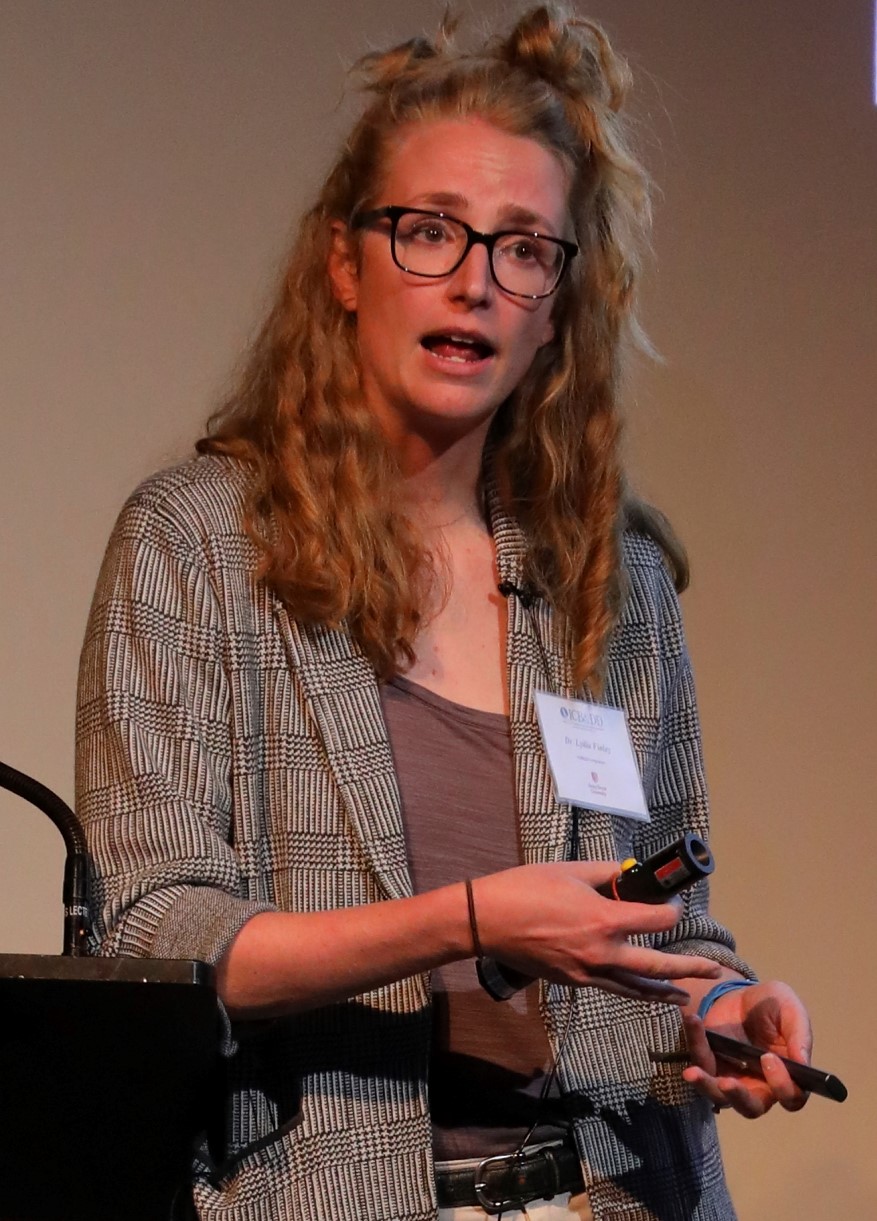 The fifth Plenary Lecturer, Dr. Lydia Finley, was introduced by Dr. Dongyan Tan, Assistant Professor of Pharmacological Sciences.
Dr. Finley, an Associate Professor of Weill Cornell Medical College and Associate
Member of the Cell Biology Program at the Memorial Sloan Kettering Cancer Center gave
a lecture titled “Metabolic Regulation of Cell Fate Decisions”. Dr. Finley’s research
laboratory has discovered genetic and environmental factors that drive metabolic regulation
of chromatin modifications and gene expression programs that control cell fate. In
her presentation, she discussed her latest work on how cell-type specific metabolic
profiles are established and the functional consequences of changes in metabolic wiring
upon cell fate transitions.
The fifth Plenary Lecturer, Dr. Lydia Finley, was introduced by Dr. Dongyan Tan, Assistant Professor of Pharmacological Sciences.
Dr. Finley, an Associate Professor of Weill Cornell Medical College and Associate
Member of the Cell Biology Program at the Memorial Sloan Kettering Cancer Center gave
a lecture titled “Metabolic Regulation of Cell Fate Decisions”. Dr. Finley’s research
laboratory has discovered genetic and environmental factors that drive metabolic regulation
of chromatin modifications and gene expression programs that control cell fate. In
her presentation, she discussed her latest work on how cell-type specific metabolic
profiles are established and the functional consequences of changes in metabolic wiring
upon cell fate transitions.
The sixth Plenary Lecturer, Dr. Adrianus van der Velden, was introduced by Dr. David Thanassi, Professor and Chair of Microbiology and Immunology. Dr. van der Velden, an Associate Professor
in the Department of Microbiology and Immunology in the Renaissance School of Medicine
at Stony Brook University gave a lecture titled “On the Competition for Resources
at the Host-Pathogen Interface”. Dr. van der Velden described his research focused
on hos-pathogen interactions, with an emphasis on the immunology of infection. He
talked about much of his recent work on the role of inflammatory monocytes in immunity
and host defense against the bacterial trigger, Salmonella.
The seventh and final Plenary Lecturer, Dr. Paul Cohen, was introduced byDr. Miguel García-Díaz, Professor of Pharmacological Sciences. Dr. Cohen, the Albert Resnick, MD Associate Professor and
Head of the Laboratory of Molecular Metabolism at The Rockefeller University who gave
a lecture entitled “The Role of Adipose Tissue in the Pathogenesis and Treatment of
Obesity-Associated Diseases”. Dr. Cohen’s research focuses on understanding the molecular
links between obesity and associated diseases with a particular emphasis on diabetes,
cardiovascular disease and cancer. In his presentation he discussed about his studies
on the cell biology of white, brown and beige fat and included translational studies
in humans. By employing novel imaging and biochemical methods as part of a systems-based
approach to investigate three interconnected areas of fat tissue, he is aiming at
providing new therapeutic opportunities to address a crucial and unmet need threatening
human health.
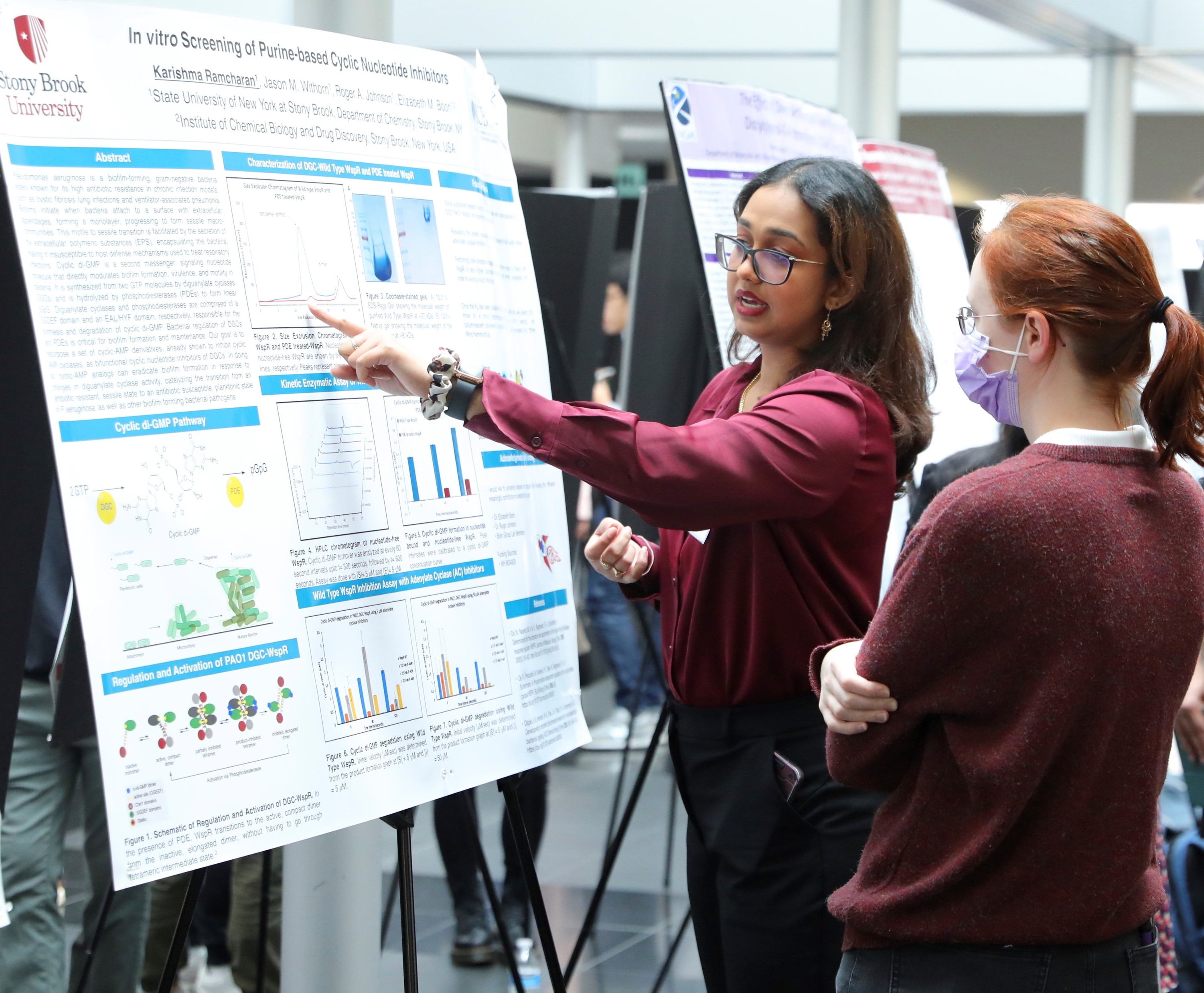
Fifty seven posters were presented in two poster sessions during the symposium and
three posters were selected for Outstanding Poster Awards and presentation in the
final session of the symposium. Dr. David Montrose, Chair of the Poster Session, presented
the awards to Yu-Ching Chen, a graduate student in the laboratory of Dr. Nicole Sampson, for his poster titled
“Deletion of Mycobacterium Tuberculosis melH Epoxide Hydrolase b Interrupts the Electron
Transport Chain and Causes Triacylglycerol Accumulation”, Jinal A. Patel, a graduate student in the laboratory of Dr. Hyungjin Kim for his poster titled “Loss
of Replisome Integrity by Inducible TIMELESS Degradation Synergizes with ATR Inhibition
to Trigger Replication Catastrophe”, and Nivea Pereira de Sa, a postdoctoral research associate in Dr. Maurizio del Poeta’s laboratory, for her
poster titled “Structural Basis for Pharmacological Inhibition of Aspergillus Fumigatus
Sterylglucosidase A”. Each of the winners was awarded a check in the amount of $250,
an award certificate and all of them were invited to attend the Symposium dinner with
the Plenary Lecturers and ICB&DD faculty.
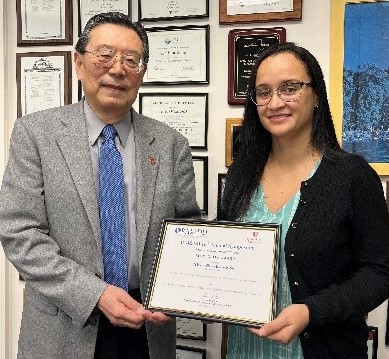
The Sixteenth ICB&DD Annual Symposium culminated with a wonderful dinner at the Zodiac Gallery of the Charles B. Wang Center. Among the attendees were Dr. Peter Tonge, Chair of the Department of Chemistry, Nicole Sampson, Dean of the College of Arts and Sciences. The chair of the symposium organizing committee, Dr. Elizabeth Boon as well as Peter Tonge, and Nicole Sampson expressed their appreciation for the outstanding lectures presented at the symposium. They all acknowledged the significance of the ICB&DD and the collaborative efforts among academia and industry. They also commended Dr. Ojima for his successful leadership, the ICB&DD operation and a sixteen year-long cutting-edge Symposiums. The ICB&DD symposium is widely recognized for being the leading event on campus that gives the opportunity to the scientific community from East, West and South campus to come together and promote the exchange of innovative ideas among speakers, faculty, staff, and students. Dr. Ojima presented Appreciation Plaques to Symposium Chairs, John Haley (2017), Jingfang Ju (2020), Carlos Simmerling (2021) and Elizabeth Boon (2022), as well as to Ms. Roxanne Brockner for her 15 years of Excellence in Service.
The 16th Annual Symposium of the ICB&DD was sponsored by the Office of the Vice President for Research, the Renaissance School of Medicine, the Department of Chemistry, Chembio Diagnostics Systems Inc., and Hoffman and Baron LLP.
ICB&DD Fifteenth Annual Symposium (2021)

The ICB&DD hosted its fifteenth annual symposium, “Drug Discovery for COVID-19 and Other Emergent Coronaviruses”, on Thursday October 7, 2021. As for the 2020 symposium, it was held via Zoom due to the ongoing SARS-CoV-2 pandemic. There were seven outstanding plenary lectures and a poster session featuring 35 posters from students and postdoctoral fellows representing eleven doctoral training programs, institutes, and centers at Stony Brook University.
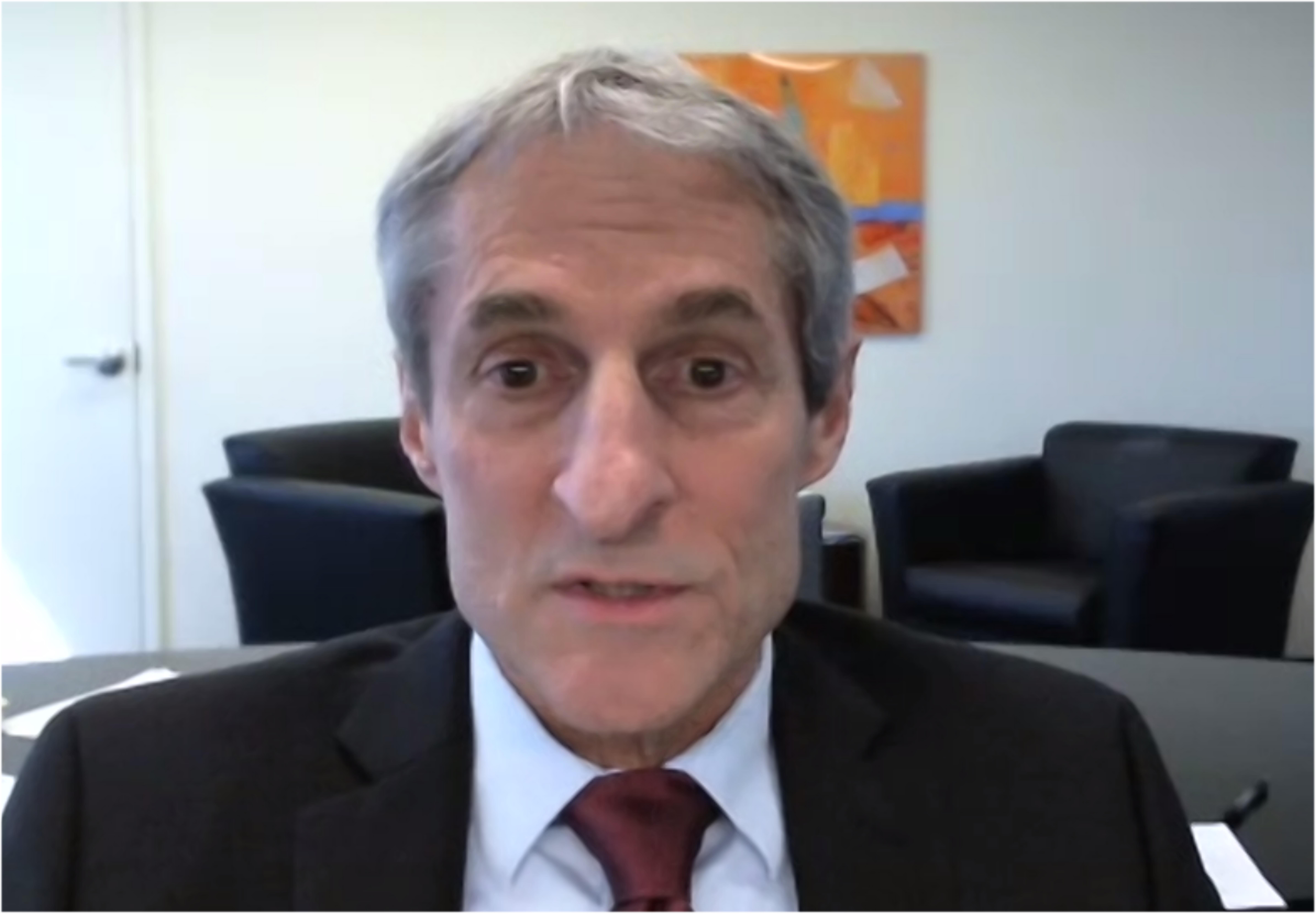
 Dr. Carlos Simmerling, Professor of Chemistry, Associate Director of the Laufer Center
for Physical and Quantitative Biology at SBU, and Chair of the Symposium Organizing
Committee welcomed the attendees and introduced Dr. Richard Reeder, Vice President
for Research who spoke about the size, breadth, and strength of the research enterprise
at SBU. Dr. Iwao Ojima, Distinguished Professor of Chemistry and Director of the ICB&DD
gave an overview of the history and mission of the Institute in his welcoming remarks.
Dr. Carlos Simmerling, Professor of Chemistry, Associate Director of the Laufer Center
for Physical and Quantitative Biology at SBU, and Chair of the Symposium Organizing
Committee welcomed the attendees and introduced Dr. Richard Reeder, Vice President
for Research who spoke about the size, breadth, and strength of the research enterprise
at SBU. Dr. Iwao Ojima, Distinguished Professor of Chemistry and Director of the ICB&DD
gave an overview of the history and mission of the Institute in his welcoming remarks.
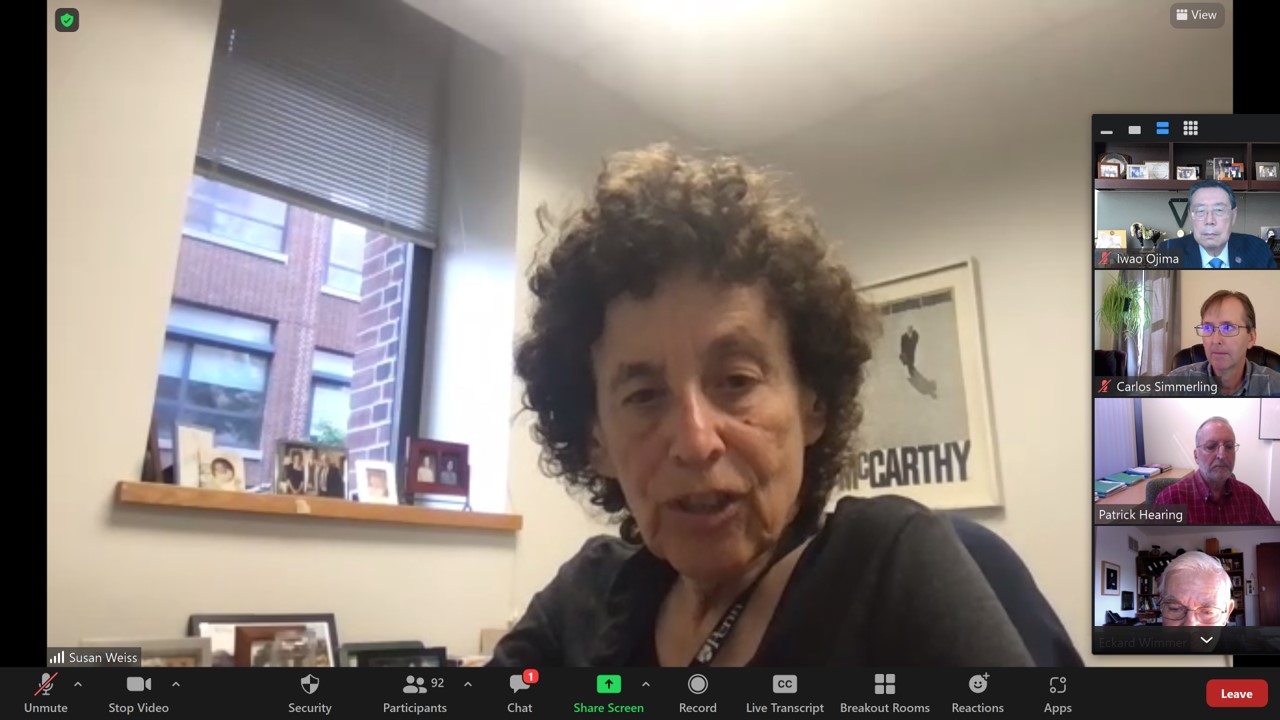 Dr. Patrick Hearing, Professor of Microbiology and Immunology, introduced the first
plenary speaker, Dr. Susan Weiss. Dr. Weiss, a Professor of Microbiology at the University of Pennsylvania Perelman
School of Medicine, reviewed the coronavirus replication cycle with an emphasis on
candidate targets for direct-acting antiviral drugs, and the likely origins of emergent
coronaviruses from the late 18th century to the present time in her talk titled “History and Biology of Coronaviruses:
What this Teaches Us About Targets for Therapeutics”. Dr. Weiss also reviewed the
mutations present in SARS-CoV-2 variants of concern and related these mutations to
changes in biological properties of these viruses including immune escape, increased
receptor binding, and virus entry.
Dr. Patrick Hearing, Professor of Microbiology and Immunology, introduced the first
plenary speaker, Dr. Susan Weiss. Dr. Weiss, a Professor of Microbiology at the University of Pennsylvania Perelman
School of Medicine, reviewed the coronavirus replication cycle with an emphasis on
candidate targets for direct-acting antiviral drugs, and the likely origins of emergent
coronaviruses from the late 18th century to the present time in her talk titled “History and Biology of Coronaviruses:
What this Teaches Us About Targets for Therapeutics”. Dr. Weiss also reviewed the
mutations present in SARS-CoV-2 variants of concern and related these mutations to
changes in biological properties of these viruses including immune escape, increased
receptor binding, and virus entry.
The second speaker, Dr. Rolf Hilgenfeld, was introduced by Dr. Peter Tonge, Distinguished Professor and Chair of the Department
of Chemistry. Dr. Hilgenfeld, a Professor at the Institute of Molecular Medicine at
the University of Lübeck, Germany, related his group’s 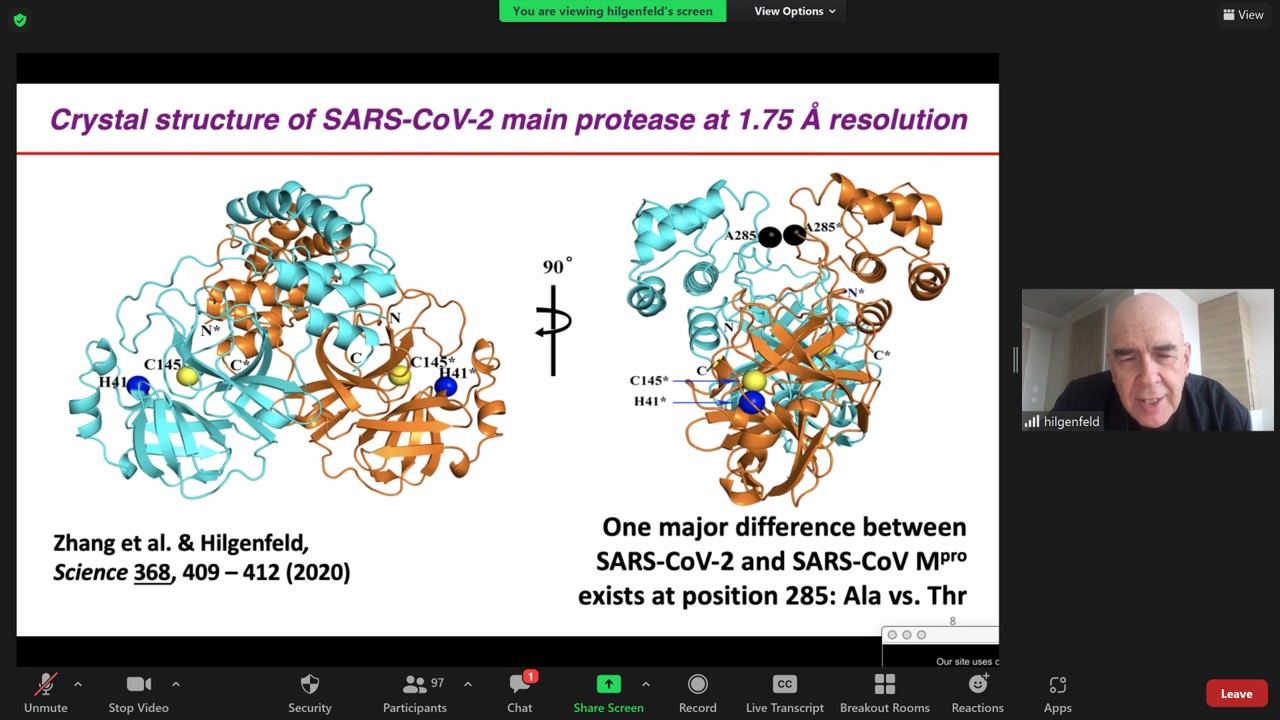 efforts to develop small molecule inhibitors of the SARS-CoV-2 main protease, Mpro/3CLpro, a viral enzyme that plays an essential role in processing of the viral polyproteins
in his talk “The Main Protease of SARS-CoV-2: Structures, Inhibitors, and Mutations”.
He reminded the audience of the narrow window between the onset of symptoms and the
cytokine storm phase of COVID-19 during which time direct-acting antiviral drugs are
most likely to impact the course of the disease and then explained how they are using
the crystal structure of Mpro and locations of mutations that have arisen in Mpro since the start of the pandemic
to modify a parent alpha-ketoamide and boceprevir and create derivatives with increased
inhibitory activity.
efforts to develop small molecule inhibitors of the SARS-CoV-2 main protease, Mpro/3CLpro, a viral enzyme that plays an essential role in processing of the viral polyproteins
in his talk “The Main Protease of SARS-CoV-2: Structures, Inhibitors, and Mutations”.
He reminded the audience of the narrow window between the onset of symptoms and the
cytokine storm phase of COVID-19 during which time direct-acting antiviral drugs are
most likely to impact the course of the disease and then explained how they are using
the crystal structure of Mpro and locations of mutations that have arisen in Mpro since the start of the pandemic
to modify a parent alpha-ketoamide and boceprevir and create derivatives with increased
inhibitory activity.
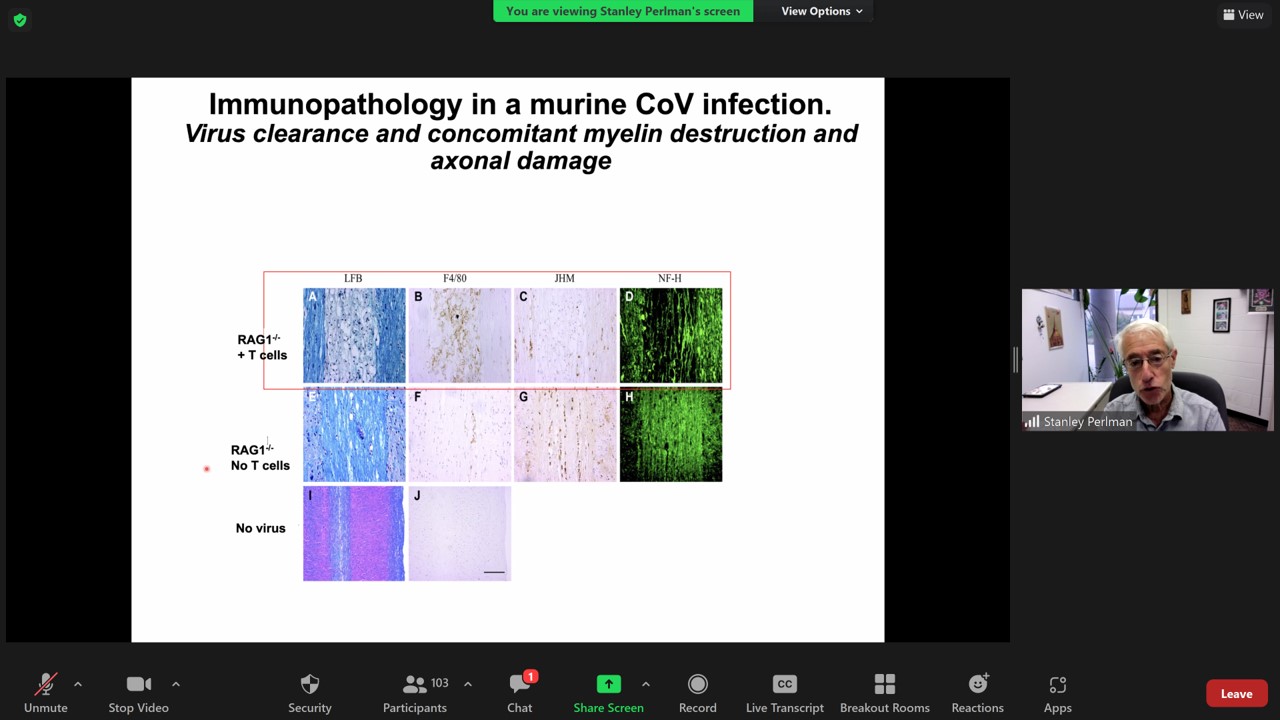 Dr. Stanley Perlman, Professor of Microbiology and Immunology at the University of Iowa Carver College
of Medicine, was introduced by Dr. Hwan Kim, Assistant Professor of Microbiology and
Immunology. Dr. Perlman spoke about “Animal Models for COVID-19” and how they are
being used to study SARS-CoV-2 pathogenesis, and the effects of advanced age and male
sex on the outcome of infection. His talk focused on his recent work using animal
models to investigate anosmia, the loss of the sense of smell, that occurs in 40-60%
of COVID-19 patients.
Dr. Stanley Perlman, Professor of Microbiology and Immunology at the University of Iowa Carver College
of Medicine, was introduced by Dr. Hwan Kim, Assistant Professor of Microbiology and
Immunology. Dr. Perlman spoke about “Animal Models for COVID-19” and how they are
being used to study SARS-CoV-2 pathogenesis, and the effects of advanced age and male
sex on the outcome of infection. His talk focused on his recent work using animal
models to investigate anosmia, the loss of the sense of smell, that occurs in 40-60%
of COVID-19 patients.
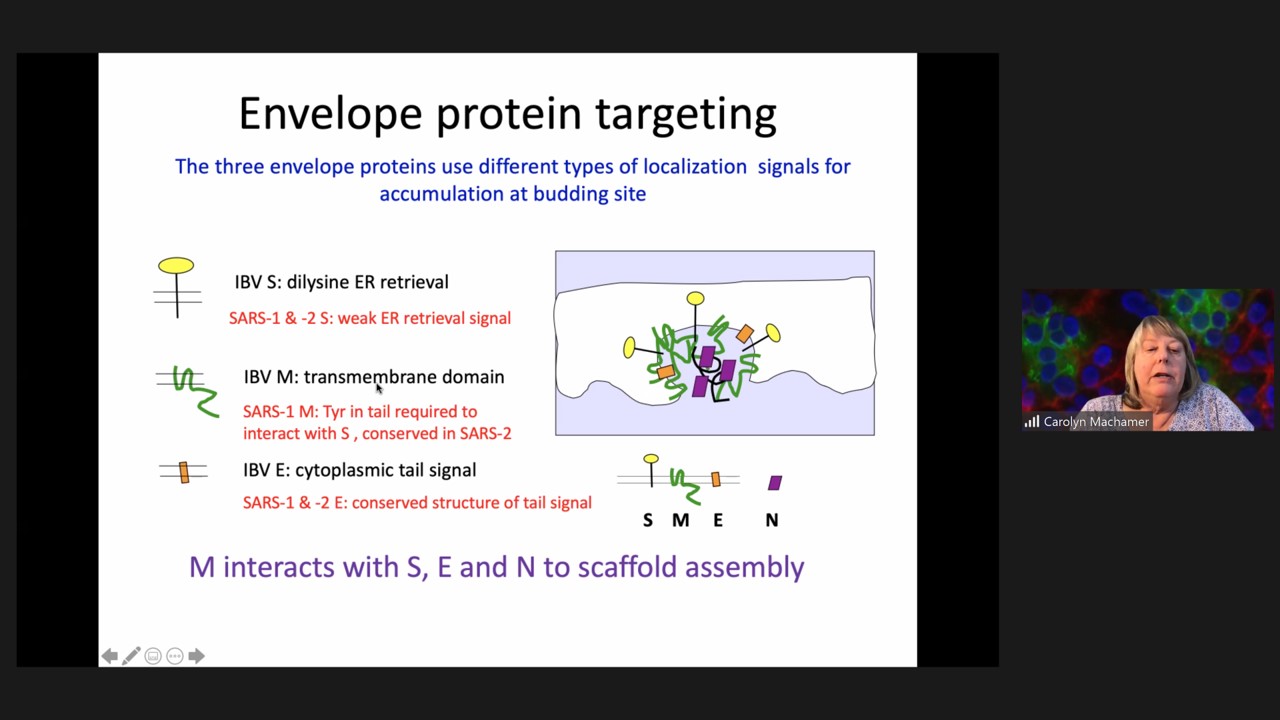 Dr. Carol Carter, Professor of Microbiology and Immunology, introduced Dr. Carolyn Machamer, a Professor in the Department of Cell Biology at Johns Hopkins University School
of Medicine who gave a talk titled “Assembly and Egress of Coronaviruses”. Coronavirus
assembly begins when the nucleocapsid buds into the ER-Golgi intermediate compartment
and nascent virions must travel through the secretory pathway to be released from
the cell. Dr. Machamer described her studies using infectious bronchitis virus as
the model system to study the assembly and egress of virions and to identify novel
targets for the development of antiviral drugs. Her work has suggested that all coronaviruses
neutralize the pH of the Golgi and this activity is required to prevent cleavage of
the viral envelope protein prior to release of the virus.
Dr. Carol Carter, Professor of Microbiology and Immunology, introduced Dr. Carolyn Machamer, a Professor in the Department of Cell Biology at Johns Hopkins University School
of Medicine who gave a talk titled “Assembly and Egress of Coronaviruses”. Coronavirus
assembly begins when the nucleocapsid buds into the ER-Golgi intermediate compartment
and nascent virions must travel through the secretory pathway to be released from
the cell. Dr. Machamer described her studies using infectious bronchitis virus as
the model system to study the assembly and egress of virions and to identify novel
targets for the development of antiviral drugs. Her work has suggested that all coronaviruses
neutralize the pH of the Golgi and this activity is required to prevent cleavage of
the viral envelope protein prior to release of the virus.
The fifth talk of the symposium was given by Dr. Sara Cherry, Professor of Pathology and Laboratory Medicine at the University of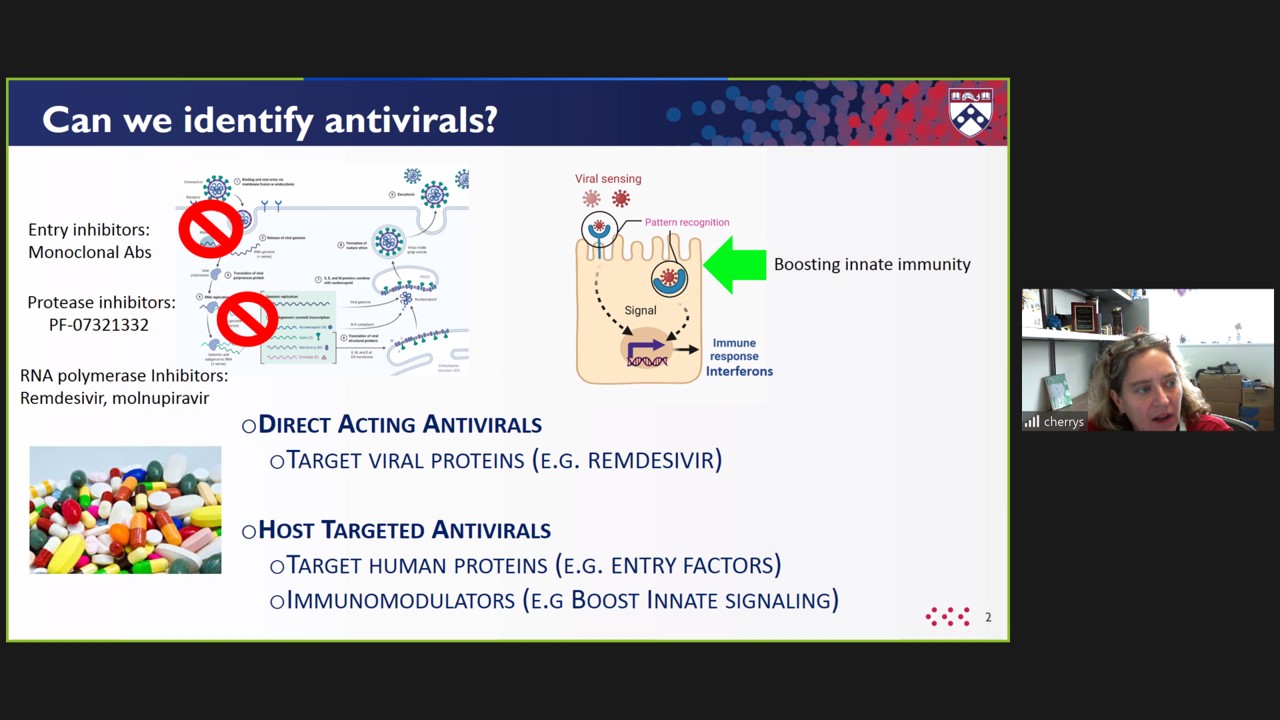 Pennsylvania. Dr. Cherry was introduced by Dr. Erich Mackow, Professor of Microbiology
and Immunology. Dr. Cherry, Scientific Director of the High-throughput Screening Core
and Director of the Chemogenomic Discovery Program at the University of Pennsylvania,
presented the results of screening approved drugs for anti-SARS-CoV-2 activity. One
hit was an agonist for the innate immune modulator STING and subsequent experiments
have demonstrated antiviral activity in an animal model of infection. A number of
inhibitors of host cell nucleoside biosynthesis enzymes were identified in the screens,
some of which were found to synergize with antiviral nucleoside analogues.
Pennsylvania. Dr. Cherry was introduced by Dr. Erich Mackow, Professor of Microbiology
and Immunology. Dr. Cherry, Scientific Director of the High-throughput Screening Core
and Director of the Chemogenomic Discovery Program at the University of Pennsylvania,
presented the results of screening approved drugs for anti-SARS-CoV-2 activity. One
hit was an agonist for the innate immune modulator STING and subsequent experiments
have demonstrated antiviral activity in an animal model of infection. A number of
inhibitors of host cell nucleoside biosynthesis enzymes were identified in the screens,
some of which were found to synergize with antiviral nucleoside analogues.
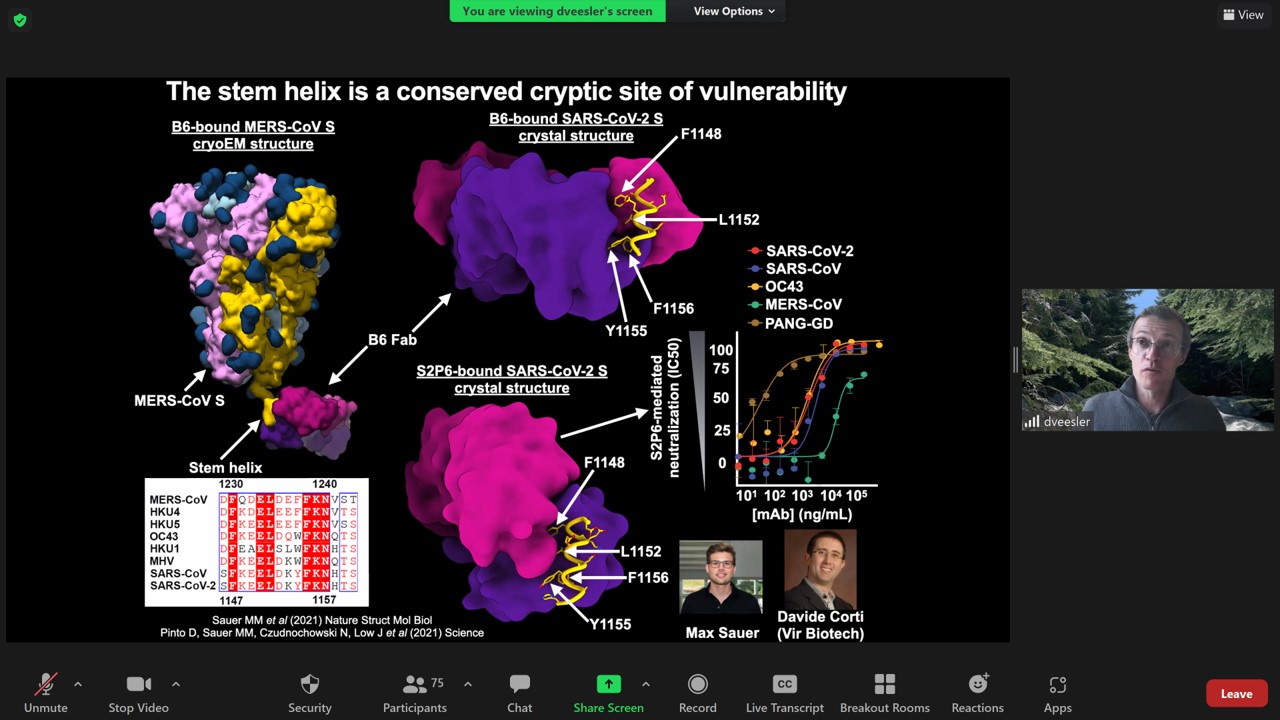 Dr. David Veesler, Associate Professor of Biochemistry at the University of Washington and 2021 Howard
Hughes Medical Institute Investigator was introduced by Dr. Janet Hearing, Associate
Professor of Microbiology and Immunology. Dr. Veesler’s group was the first to publish
the structure of a coronavirus spike protein using cryo-EM. He discussed the ways
in which his research group is using this structural information to understand in
detail the interaction of the spike protein with the viral receptor, conformational
changes the spike protein undergoes as it facilitates virus entry, the location of
neutralizing antibody epitopes, and immune evasion by SARS-CoV-2 variants. He described
a novel, temperature-stable candidate COVID-19 vaccine containing the receptor-binding
domain of the spike protein that assembles into a protein nanoparticle and elicits
neutralizing antibodies.
Dr. David Veesler, Associate Professor of Biochemistry at the University of Washington and 2021 Howard
Hughes Medical Institute Investigator was introduced by Dr. Janet Hearing, Associate
Professor of Microbiology and Immunology. Dr. Veesler’s group was the first to publish
the structure of a coronavirus spike protein using cryo-EM. He discussed the ways
in which his research group is using this structural information to understand in
detail the interaction of the spike protein with the viral receptor, conformational
changes the spike protein undergoes as it facilitates virus entry, the location of
neutralizing antibody epitopes, and immune evasion by SARS-CoV-2 variants. He described
a novel, temperature-stable candidate COVID-19 vaccine containing the receptor-binding
domain of the spike protein that assembles into a protein nanoparticle and elicits
neutralizing antibodies.
The final speaker, Dr. Carlos Simmerling, was introduced by Dr. Robert Rizzo, Professor of Applied Mathematics and Statistics. 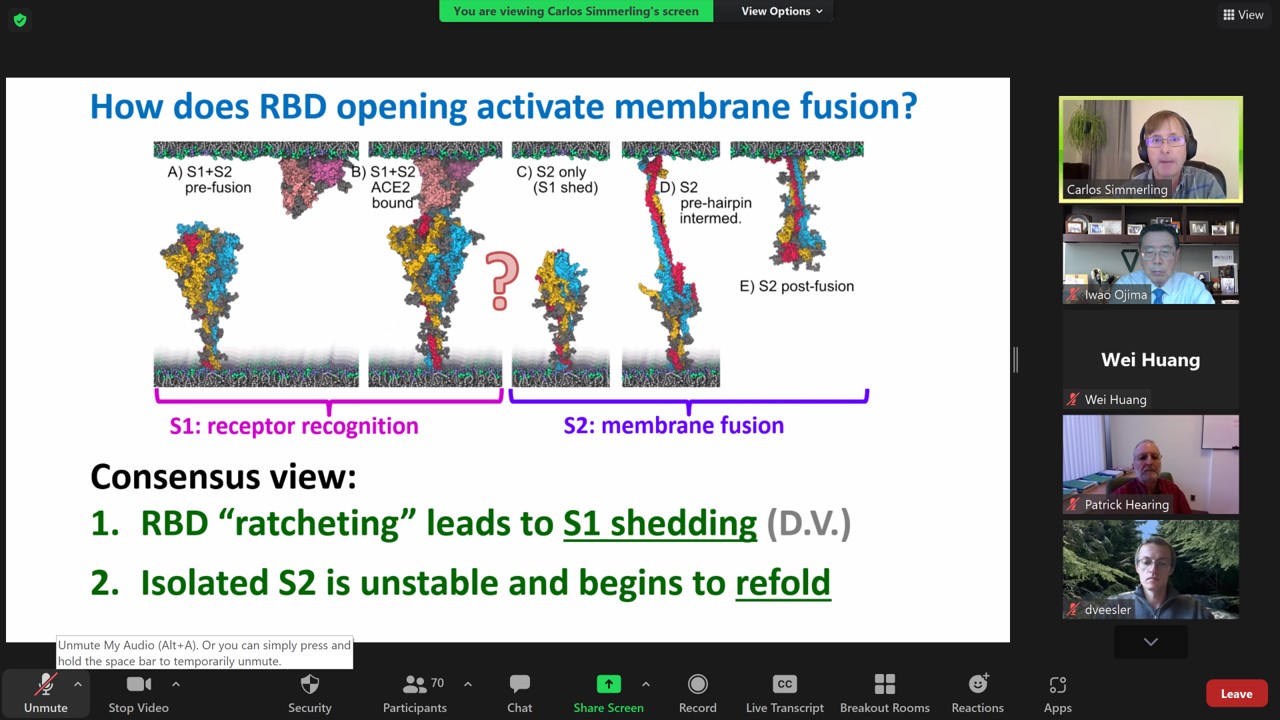 Dr. Simmerling, Professor of Chemistry, Associate Director of the Laufer Center for
Physical and Quantitative Biology, described his work using molecular dynamics simulations
to investigate changes in the coronavirus spike protein that are triggered by the
binding of spike to the receptor, ACE2, and the events between receptor binding and
viral envelope-cell membrane fusion. He also discussed the way in which an amino acid
change in spike increases exposure of the receptor binding domain to neutralizing
antibodies and proposed that the binding of small molecules to an allosteric pocket
beneath the receptor binding domain might be exploited to increase exposure of neutralizing
epitopes.
Dr. Simmerling, Professor of Chemistry, Associate Director of the Laufer Center for
Physical and Quantitative Biology, described his work using molecular dynamics simulations
to investigate changes in the coronavirus spike protein that are triggered by the
binding of spike to the receptor, ACE2, and the events between receptor binding and
viral envelope-cell membrane fusion. He also discussed the way in which an amino acid
change in spike increases exposure of the receptor binding domain to neutralizing
antibodies and proposed that the binding of small molecules to an allosteric pocket
beneath the receptor binding domain might be exploited to increase exposure of neutralizing
epitopes.

Thirty five posters were presented in two poster sessions during the symposium and three posters were selected for outstanding poster awards and presentation in the final session of the symposium. Dr. Janet Hearing, Chair of the Poster Session, presented the awards to Hehe Wang, a graduate student in the laboratory of Dr. Iwao Ojima, for his poster titled “Truxillic Acid Monoesters as Novel Fatty Acid Binding Protein 5 Inhibitors Treating Metastatic Castration-Resistant Prostate Cancer”, John Bickel, a graduate student in the laboratory of Dr. Robert Rizzo, for his poster titled “Automated De novo Molecular Refinement and Applications to Clinically Relevant Drug Targets”, and Nuri Kim, a graduate student in Dr. Jessica Seeliger’s laboratory, for her poster titled “Synonymous mutations and non-canonical gene expression in Mycobacteria”. The awardees each received a check in the amount of $150 and an award certificate.
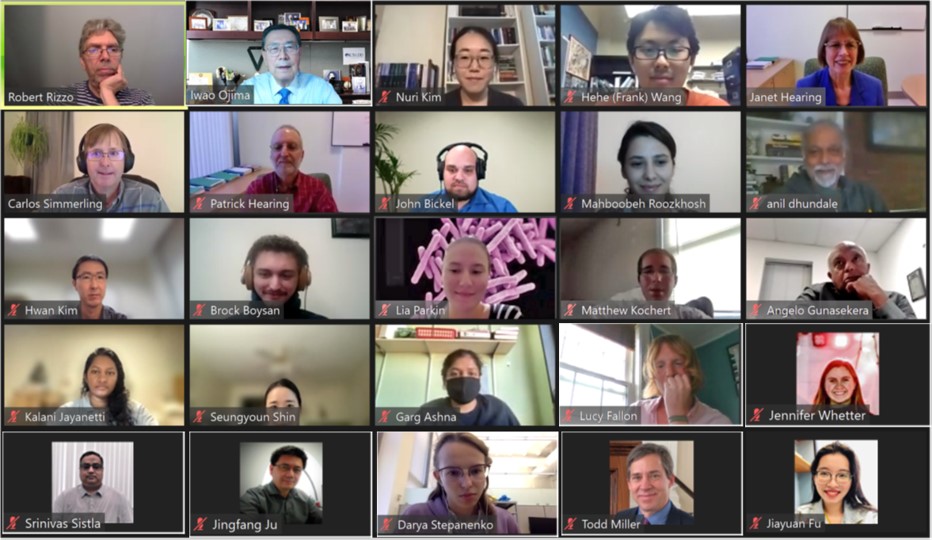
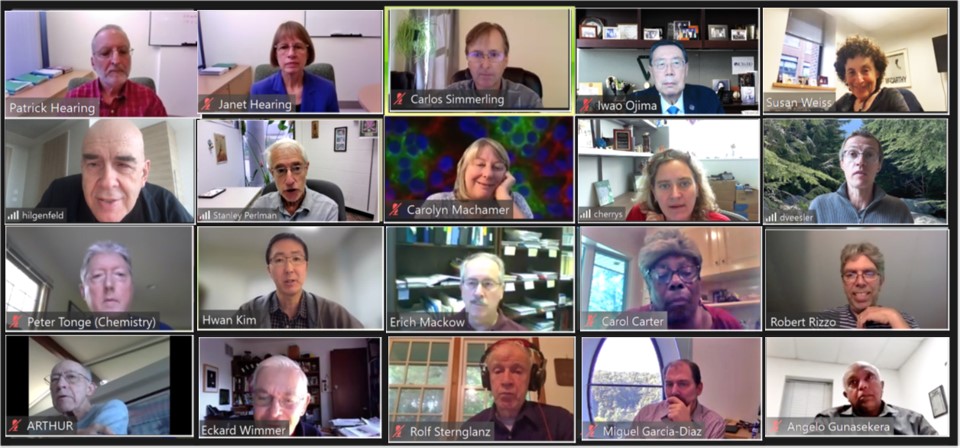
The 15th Annual Symposium of the ICB&DD was sponsored by the Office of the Vice President for Research at SBU, the Renaissance School of Medicine, the Department of Chemistry, Chembio Diagnostics Systems Inc., and Hoffman and Baron LLP.
ICB&DD Fourteenth Annual Symposium (2020)

On Thursday, October 9, 2020, the ICB&DD hosted its Thirteenth Annual Symposium entitled, “Frontiers
of Chemical Biology and Drug Discovery: Nucleic Acid-Based Medicine”. This year, because
of the COVID-19 pandemic, it took place via Zoom. The Symposium featured seven Plenary
Lecturers. Dr. Jingfang Ju represented the Department of Pathology of Stony Brook
University. The event was attended by a diversified audience composed of faculty,
research staff and students on campus. The Poster Session equally attracted participation
from Stony Brook University students. There were 42 scientific posters presented via
Zoom at the Poster Session. 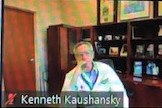
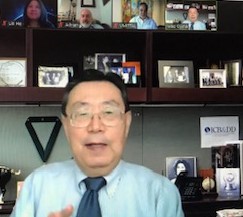 Dr. Jingfang Ju, Professor of Pathology, Chair, Symposium Organizing Committee opened
the Symposium and introduced Dr. Kenneth Kaushansky, Dean, Stony Brook University
Renaissance School of Medicine who gave the welcoming remarks for the Symposium. Dr.
Kaushansky conveyed his gratitude for the outstanding science and collaboration that
the ICB&DD has done over the years. He mentioned that ICB&DD sets a great example
to the scientific community on campus. Then, Dr. Ju introduced Dr. Iwao Ojima, Distinguished
Professor and Director of ICB&DD. Dr. Ojima concisely summarized the history of accomplishments
and the current and future goals of ICB&DD.
Dr. Jingfang Ju, Professor of Pathology, Chair, Symposium Organizing Committee opened
the Symposium and introduced Dr. Kenneth Kaushansky, Dean, Stony Brook University
Renaissance School of Medicine who gave the welcoming remarks for the Symposium. Dr.
Kaushansky conveyed his gratitude for the outstanding science and collaboration that
the ICB&DD has done over the years. He mentioned that ICB&DD sets a great example
to the scientific community on campus. Then, Dr. Ju introduced Dr. Iwao Ojima, Distinguished
Professor and Director of ICB&DD. Dr. Ojima concisely summarized the history of accomplishments
and the current and future goals of ICB&DD.
Dr. Chia-Hsin (Lori) Chan, Associate Professor of Pharmacological Sciences, introduced
the first Plenary Lecturer, Dr. George A. Calin, 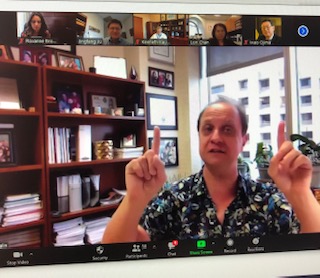 Professor, Department of Experimental Therapeutics, Division of Cancer Medicine, The
University of Texas MD Anderson Center who gave a lecture entitled: “About Chomsky, Non-codingRNAs and Cancer Therapy”. In his presentation, Dr. Calin explained the roles of microRNAs and other non-coding
RNAs in cancer initiation and progression and in immune disorders, as well as the
mechanisms of cancer predisposition linked to non-codingRNAs. Furthermore, his research
laboratory group has explored the roles of body fluids miRNAs as potential hormones
and biomarkers, as well as new RNA therapeutic options for cancer patients.
Professor, Department of Experimental Therapeutics, Division of Cancer Medicine, The
University of Texas MD Anderson Center who gave a lecture entitled: “About Chomsky, Non-codingRNAs and Cancer Therapy”. In his presentation, Dr. Calin explained the roles of microRNAs and other non-coding
RNAs in cancer initiation and progression and in immune disorders, as well as the
mechanisms of cancer predisposition linked to non-codingRNAs. Furthermore, his research
laboratory group has explored the roles of body fluids miRNAs as potential hormones
and biomarkers, as well as new RNA therapeutic options for cancer patients.
 Dr. Jingfang Ju, Professor of Pathology, introduced the second Plenary Lecturer, Dr. Richard I. Gregory, Professor and Chairman, Department of Pediatrics Stem Cell Biology, Harvard Medical
School, who gave a lecture entitled “Role of the Epitranscriptome in Gene Regulation and Cancer”. Dr. Gregory talked about the emerging field of ‘epitranscriptomics’ and its importance
in cancer biology. ‘Epitranscriptomics’ is offering new insights into the biological
and pathological roles of different RNA modifications. Methylation of transfer RNAs
(tRNAs), ribosomal RNAs (rRNAs), and messenger RNAs (mRNAs) can play important roles
in cancer and the relevance of certain methyltransferases as possible therapeutic
targets is just beginning to be appreciated.
Dr. Jingfang Ju, Professor of Pathology, introduced the second Plenary Lecturer, Dr. Richard I. Gregory, Professor and Chairman, Department of Pediatrics Stem Cell Biology, Harvard Medical
School, who gave a lecture entitled “Role of the Epitranscriptome in Gene Regulation and Cancer”. Dr. Gregory talked about the emerging field of ‘epitranscriptomics’ and its importance
in cancer biology. ‘Epitranscriptomics’ is offering new insights into the biological
and pathological roles of different RNA modifications. Methylation of transfer RNAs
(tRNAs), ribosomal RNAs (rRNAs), and messenger RNAs (mRNAs) can play important roles
in cancer and the relevance of certain methyltransferases as possible therapeutic
targets is just beginning to be appreciated.
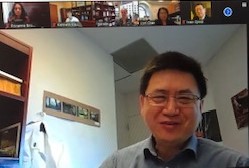 Dr. Martin Kaczocha, Associate Professor of Anesthesiology, introduced the third Plenary
Lecturer, Jingfang Ju, Professor, Department of Pathology, Stony Brook University Renaissance School of Medicine
who gave a lecture entitled: “Development of miRNA Based Platform Technology for Cancer Therapeutics”. In his presentation, Dr. Ju talked about the importance of understanding the mechanisms
of cancer chemoresistance mediated by non-coding RNA. He explained how resistance
to chemo and radiation therapy is a major issue for a successful outcome of cancer
treatment due to tumor heterogeneity and highly plastic nature.
Dr. Martin Kaczocha, Associate Professor of Anesthesiology, introduced the third Plenary
Lecturer, Jingfang Ju, Professor, Department of Pathology, Stony Brook University Renaissance School of Medicine
who gave a lecture entitled: “Development of miRNA Based Platform Technology for Cancer Therapeutics”. In his presentation, Dr. Ju talked about the importance of understanding the mechanisms
of cancer chemoresistance mediated by non-coding RNA. He explained how resistance
to chemo and radiation therapy is a major issue for a successful outcome of cancer
treatment due to tumor heterogeneity and highly plastic nature.
Dr. Adam Rosebrock, Assistant Professor of Pathology, introduced the fourth Plenary
Lecturer, Dr. Lin He, Professor, Department of 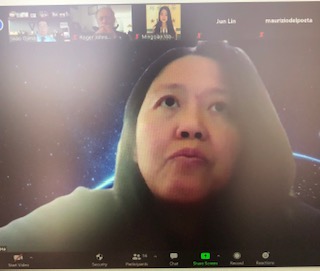 Molecular & Cell Biology, University of California, Berkeley, who gave a lecture entitled:
Friends or Foes, Retrotransposons in Mammalian Preimplantation Development” In her presentation, Dr. Hen stated that her research is interested in functional
characterization of non-coding elements, including miRNAs, lncRNAs and retrotransposons,
in mammalian genomes. She talked about her aims to understand the distinct biological
functions and molecular regulation conferred by miRNAs, long ncRNAs and retrotransposons in
development and disease using an interdisciplinary approach combining mouse genetics,
genomics, imaging studies, cell biology, and molecular biology.
Molecular & Cell Biology, University of California, Berkeley, who gave a lecture entitled:
Friends or Foes, Retrotransposons in Mammalian Preimplantation Development” In her presentation, Dr. Hen stated that her research is interested in functional
characterization of non-coding elements, including miRNAs, lncRNAs and retrotransposons,
in mammalian genomes. She talked about her aims to understand the distinct biological
functions and molecular regulation conferred by miRNAs, long ncRNAs and retrotransposons in
development and disease using an interdisciplinary approach combining mouse genetics,
genomics, imaging studies, cell biology, and molecular biology.
 Dr. Elizabeth Boon, Professor of Chemistry, introduced the fifth Plenary Lecturer,
Dr. Adrian Krainer, St. Giles Foundation Professor, Cold Spring Harbor Laboratory (CSHL) and Deputy
Director of Research at CSHL Cancer Center, who gave a lecture entitled: “From Base
Pairs to Bedside: Antisense Modulation of RNA Splicing”. Dr. Krainer stated that his research laboratory is developing mechanism-based therapeutics,
combining knowledge about RNA-splicing regulation and antisense technology. He explained
that his research laboratory group previously developed nusinersen (Spinraza), an
antisense oligonucleotide (ASO) that modulates alternative splicing of SMN2 exon 7, restoring normal levels of functional SMN protein in the context of spinal
muscular atrophy (SMA). Nusinersen was approved in 2016 as the first drug for SMA;
it modifies the disease course and prevents its onset if treatment is initiated pre-symptomatically.
Dr. Elizabeth Boon, Professor of Chemistry, introduced the fifth Plenary Lecturer,
Dr. Adrian Krainer, St. Giles Foundation Professor, Cold Spring Harbor Laboratory (CSHL) and Deputy
Director of Research at CSHL Cancer Center, who gave a lecture entitled: “From Base
Pairs to Bedside: Antisense Modulation of RNA Splicing”. Dr. Krainer stated that his research laboratory is developing mechanism-based therapeutics,
combining knowledge about RNA-splicing regulation and antisense technology. He explained
that his research laboratory group previously developed nusinersen (Spinraza), an
antisense oligonucleotide (ASO) that modulates alternative splicing of SMN2 exon 7, restoring normal levels of functional SMN protein in the context of spinal
muscular atrophy (SMA). Nusinersen was approved in 2016 as the first drug for SMA;
it modifies the disease course and prevents its onset if treatment is initiated pre-symptomatically.
Dr. John Haley, Associate Professor of Research, Department of Pathology, introduced
the sixth Plenary Lecturer, Dr. Vivek Mittal, 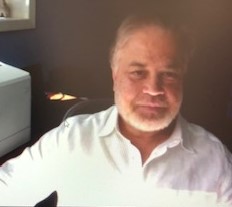 Professor of Cardiothoracic Surgery and Director, Neuberger Berman Foundation Lung
Cancer Laboratory, Weill Cornell Medicine, who gave a lecture entitled: “Metastasis Suppressor miRNAs in Triple Negative Breast Cancer”. Dr. Mittal stated that his research laboratory is focused around the lung as a central
organ to study de novo lung carcinogenesis, as well as the initiation and progression of metastatic lesions
derived from extra pulmonary neoplasms including breast cancer. In his presentation,
Dr. Mittal explained how his laboratory is studying Triple-negative breast cancer
(TNBC). Using an integrated preclinical and clinical approach, they have demonstrated
epigenetic regulation of the miRs, and have identified the mechanisms by which these
miRs contribute to metastasis suppression. The have conducted a number of studies
that support the potential of oligonucleotide-based targeted therapy for TNBC.
Professor of Cardiothoracic Surgery and Director, Neuberger Berman Foundation Lung
Cancer Laboratory, Weill Cornell Medicine, who gave a lecture entitled: “Metastasis Suppressor miRNAs in Triple Negative Breast Cancer”. Dr. Mittal stated that his research laboratory is focused around the lung as a central
organ to study de novo lung carcinogenesis, as well as the initiation and progression of metastatic lesions
derived from extra pulmonary neoplasms including breast cancer. In his presentation,
Dr. Mittal explained how his laboratory is studying Triple-negative breast cancer
(TNBC). Using an integrated preclinical and clinical approach, they have demonstrated
epigenetic regulation of the miRs, and have identified the mechanisms by which these
miRs contribute to metastasis suppression. The have conducted a number of studies
that support the potential of oligonucleotide-based targeted therapy for TNBC.
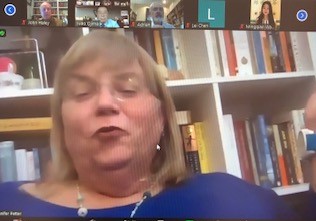 Dr. Peter Tonge, Distinguished Professor and Chair of Department of Chemistry, introduced
the seventh Plenary Lecturer, Dr. Jennifer C. Petter, Founder and CSO, Arrakis Therapeutics, who gave a lecture entitled: “Drugging RNA with Small Molecules”. In her presentation, Dr. Petter stated that RNA is upstream of all biology and thus
presents a vast array of therapeutically attractive targets. She explained that at
Arrakis, they have identified druggable RNA sub-structures in mRNA with complex tertiary
folds and drug-like small molecules that bind to those structures selectively. In
addition to highlighting some of the unique challenges of drugging RNA, in her presentation,
she highlighted the central role played by chemical biology in advancing ligands toward
therapeutic value against this novel class of targets.
Dr. Peter Tonge, Distinguished Professor and Chair of Department of Chemistry, introduced
the seventh Plenary Lecturer, Dr. Jennifer C. Petter, Founder and CSO, Arrakis Therapeutics, who gave a lecture entitled: “Drugging RNA with Small Molecules”. In her presentation, Dr. Petter stated that RNA is upstream of all biology and thus
presents a vast array of therapeutically attractive targets. She explained that at
Arrakis, they have identified druggable RNA sub-structures in mRNA with complex tertiary
folds and drug-like small molecules that bind to those structures selectively. In
addition to highlighting some of the unique challenges of drugging RNA, in her presentation,
she highlighted the central role played by chemical biology in advancing ligands toward
therapeutic value against this novel class of targets.
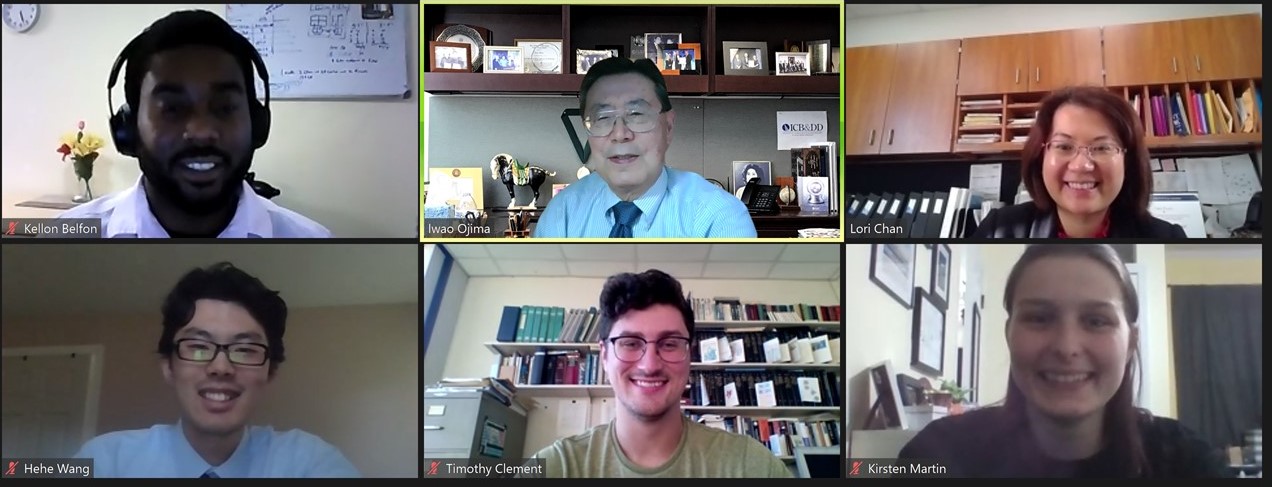
There were 42 posters presented in the Poster Session via Zoom. The best three posters were selected for the Poster Awards. The award-winning posters this year were presented by Dr. Chia-Hsin (Lori) Chan, Chair of the Posters Session, to Kellon A. Belfon, a student from the laboratory of Dr. Carlos Simmerling for his poster entitled: “Development of Parameters for Modified Amino Acids to Study Protein Dynamics”; He-he Wang and Timothy Clement, students from the laboratory of Dr. Iwao Ojima for their poster entitled: “Truxillic Acid Monoesters as Novel Fatty Acid Binding Protein 5 Inhibitors Treating Chronic Pain and Metastatic Castration-Resistant Prostate Cancer” and Kirsten E. Martin, a student from the laboratory of Dr. Eszter Boros for her poster entitled: “In Situ Excitation of Luminescent Lanthanide Complexes: Towards Enabling In Vivo Bioimaging”. The poster winners presented a four-minute presentation of their winning posters via Zoom. Their presentations were very well appreciated by the audience. Each awardee received a $150.00 check, and an award certificate.
The Symposium was sponsored by Office of Vice-President of Research, Stony Brook University Renaissance School of Medicine, Department of Chemistry, Chembio Diagnostics Systems Inc and Avanti Biosciences Inc.
ICB&DD Thirteenth Annual Symposium (2019)
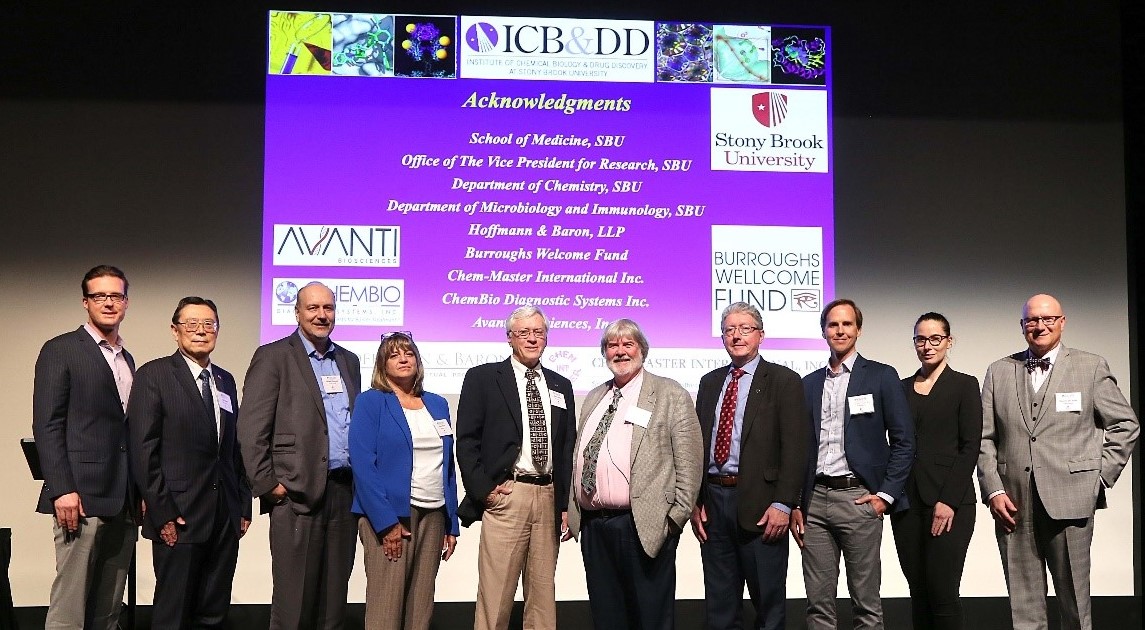
(from left to right Drs: Adam Rosebrock, Iwao Ojima, Michal Olszewski, Alita Miller, Marvin Miller, John Perfect, Peter Tonge, Peter Smith, Eszter Boros and Maurizio Del Poeta).
On Thursday, October 10, 2019, the ICB&DD hosted its Thirteenth Annual Symposium entitled, “Frontiers
of Infectious Disease Control” at the Charles B. Wang Center, Stony Brook University.
The Symposium featured seven Plenary Lecturers. Dr. Peter Tonge represented the Department
of Chemistry of Stony Brook University. The event was attended by a diversified audience
composed of faculty, research staff and students on campus. The Poster Session equally
attracted participation from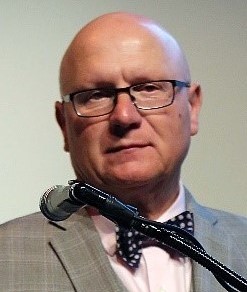 students from Stony Brook University. There were 76 scientific posters presented
at the Poster Session. Dr. Maurizio Del Poeta, Professor of Microbiology and Immunology,
Chair, Symposium Organizing Committee opened the Symposium and introduced Dr. Nicole
Sampson,
students from Stony Brook University. There were 76 scientific posters presented
at the Poster Session. Dr. Maurizio Del Poeta, Professor of Microbiology and Immunology,
Chair, Symposium Organizing Committee opened the Symposium and introduced Dr. Nicole
Sampson, 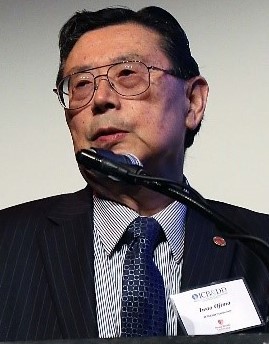 Distinguished Professor and Interim Dean, College of Arts and Sciences who gave the
welcoming remarks for the Symposium. Then Dr. Poeta introduced Dr. Iwao Ojima, Distinguished
Professor and Director of ICB&DD. Dr. Ojima concisely summarized the history of accomplishments
and the current and future goals of ICB&DD. Dr. Jessica Seeliger, Assistant Professor
of Pharmacological Sciences, introduced the first Plenary Lecturer, Dr. Gerry Wright, Professor, Biochemistry and Biomedical Sciences,
Distinguished Professor and Interim Dean, College of Arts and Sciences who gave the
welcoming remarks for the Symposium. Then Dr. Poeta introduced Dr. Iwao Ojima, Distinguished
Professor and Director of ICB&DD. Dr. Ojima concisely summarized the history of accomplishments
and the current and future goals of ICB&DD. Dr. Jessica Seeliger, Assistant Professor
of Pharmacological Sciences, introduced the first Plenary Lecturer, Dr. Gerry Wright, Professor, Biochemistry and Biomedical Sciences,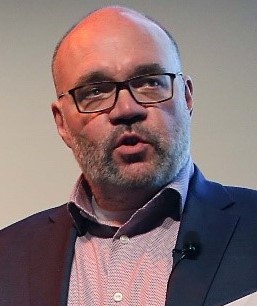 McMaster University who gave a lecture entitled: Back to the Future: Revisiting Natural Products in Antibiotic Discovery. In his presentation, Dr. Wright asserted that “the selection for multidrug resistant
infectious pathogens and their global distribution is fueling the need for new antibiotics
and their alternatives.” He stated that over the past three decades, the attempt of
the antibiotic discovery and development sector to replace the traditional source
antibiotics used for human and animal health which are natural products from bacteria
and fungi with synthetic compounds has produced poor results. Dr. Wright then discussed
the
McMaster University who gave a lecture entitled: Back to the Future: Revisiting Natural Products in Antibiotic Discovery. In his presentation, Dr. Wright asserted that “the selection for multidrug resistant
infectious pathogens and their global distribution is fueling the need for new antibiotics
and their alternatives.” He stated that over the past three decades, the attempt of
the antibiotic discovery and development sector to replace the traditional source
antibiotics used for human and animal health which are natural products from bacteria
and fungi with synthetic compounds has produced poor results. Dr. Wright then discussed
the 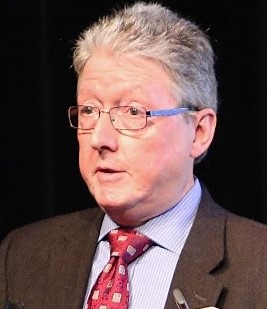 efforts of his research team to address the challenge of identifying new biological
sources of compounds and “focus on single agent broad spectrum candidates” in order
to “build a library of producers of natural products.” Dr. Isaac Carrico, Associate
Professor of Chemistry, introduced the second Plenary Lecturer, Dr. Peter Tonge, Professor and Chairman, Department of Chemistry, Stony Brook University who gave
a lecture entitled: Translating Slow-Binding Enzyme Inhibition into Prolonged Antibacterial Activity. In his presentation, Dr. Tonge discussed his interest in studying time-dependent
enzyme inhibitors in drug discovery programs. He stated that “the translation of sustained
occupancy to prolonged drug activity depends on factors such as target vulnerability
and the rate of target turnover which in turn impact the potential benefits of kinetic
selectivity.” He indicated that in order “to provide direct insight into target vulnerability”
his research group is “developing time-dependent inhibitors of antibacterial targets
and determining the factors that
efforts of his research team to address the challenge of identifying new biological
sources of compounds and “focus on single agent broad spectrum candidates” in order
to “build a library of producers of natural products.” Dr. Isaac Carrico, Associate
Professor of Chemistry, introduced the second Plenary Lecturer, Dr. Peter Tonge, Professor and Chairman, Department of Chemistry, Stony Brook University who gave
a lecture entitled: Translating Slow-Binding Enzyme Inhibition into Prolonged Antibacterial Activity. In his presentation, Dr. Tonge discussed his interest in studying time-dependent
enzyme inhibitors in drug discovery programs. He stated that “the translation of sustained
occupancy to prolonged drug activity depends on factors such as target vulnerability
and the rate of target turnover which in turn impact the potential benefits of kinetic
selectivity.” He indicated that in order “to provide direct insight into target vulnerability”
his research group is “developing time-dependent inhibitors of antibacterial targets
and determining the factors that 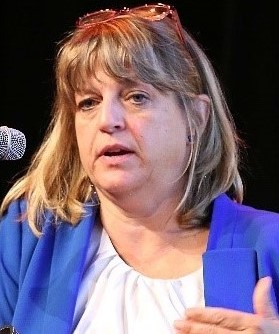 modulate the translation of slow, tight-binding enzyme inhibition to antibacterial
activity at the whole cell and whole organism level.” Dr. Elizabeth Boon, Professor
of Chemistry, introduced the third Plenary Lecturer, Dr. Alita Miller, Head of Bioscience, Entasis Therapeutics who gave a lecture entitled: A Novel Class of Gram-Negative PBP Inhibitors Discovered Using Rational Design of
Both Biochemical Potency and Bacterial Permeation. In her presentation, Dr. Miller indicated that as a result of her research team’s
study, she was able provide a “new path towards a promising IV monotherapy to treat
multi-drug resistant Gram-negative bacterial infections” which are “an urgent threat
to public health.” She stated that she believes that the discovery of novel antibacterial
agents against these pathogens had been impeded by a fundamental lack of understanding
of the molecular drivers governing cellular permeation. As a result of their research,
Dr. Miller and her group discovered a class of non-β-lactam PBP inhibitors with Gram-negative
antibacterial activity. Dr. Eszter Boros, Assistant
modulate the translation of slow, tight-binding enzyme inhibition to antibacterial
activity at the whole cell and whole organism level.” Dr. Elizabeth Boon, Professor
of Chemistry, introduced the third Plenary Lecturer, Dr. Alita Miller, Head of Bioscience, Entasis Therapeutics who gave a lecture entitled: A Novel Class of Gram-Negative PBP Inhibitors Discovered Using Rational Design of
Both Biochemical Potency and Bacterial Permeation. In her presentation, Dr. Miller indicated that as a result of her research team’s
study, she was able provide a “new path towards a promising IV monotherapy to treat
multi-drug resistant Gram-negative bacterial infections” which are “an urgent threat
to public health.” She stated that she believes that the discovery of novel antibacterial
agents against these pathogens had been impeded by a fundamental lack of understanding
of the molecular drivers governing cellular permeation. As a result of their research,
Dr. Miller and her group discovered a class of non-β-lactam PBP inhibitors with Gram-negative
antibacterial activity. Dr. Eszter Boros, Assistant 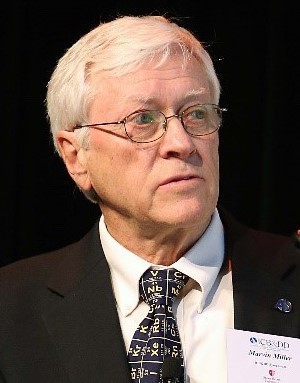 Professor of Chemistry, introduced the fourth Plenary Lecturer, Dr. Marvin Miller, Professor Emeritus, Department of Chemistry and Biochemistry, University of Notre
Dame who gave a lecture entitled: Design, Syntheses and Studies of Antibiotics to Circumvent Bacterial Resistance. In his presentation, Dr. Miller stated that since only a few new or repurposed antibiotics
have been developed over the last several decades to overcome bacterial resistance,
new antibiotics are desperately needed. He indicated that “a primary cause of drug
resistance is the overuse of antibiotics that can result in alteration of microbial
permeability, alteration of drug target binding sites, induction of enzymes that destroy
antibiotics (ie., beta-lactamases) and even induction of efflux mechanisms.” His stated
team has demonstrated “that the known critical dependence of iron assimilation by
microbes for growth and virulence can be exploited for the development of new approaches
to antibiotic therapy” and described how his group used microbe-selective iron chelating
compounds called siderophores in
Professor of Chemistry, introduced the fourth Plenary Lecturer, Dr. Marvin Miller, Professor Emeritus, Department of Chemistry and Biochemistry, University of Notre
Dame who gave a lecture entitled: Design, Syntheses and Studies of Antibiotics to Circumvent Bacterial Resistance. In his presentation, Dr. Miller stated that since only a few new or repurposed antibiotics
have been developed over the last several decades to overcome bacterial resistance,
new antibiotics are desperately needed. He indicated that “a primary cause of drug
resistance is the overuse of antibiotics that can result in alteration of microbial
permeability, alteration of drug target binding sites, induction of enzymes that destroy
antibiotics (ie., beta-lactamases) and even induction of efflux mechanisms.” His stated
team has demonstrated “that the known critical dependence of iron assimilation by
microbes for growth and virulence can be exploited for the development of new approaches
to antibiotic therapy” and described how his group used microbe-selective iron chelating
compounds called siderophores in 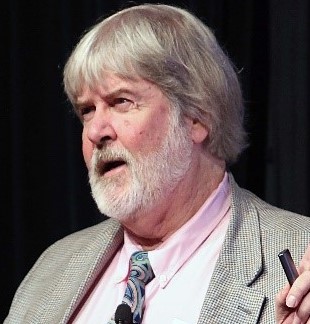 their research. Dr. Maurizio Del Poeta, Professor of Microbiology and Immunology,
introduced the fifth Plenary Lecturer, Dr. John Perfect, James B. Duke Professor of Medicine, Chief, Division of Infectious Diseases, Duke
University School of Medicine who gave a lecture entitled: New Antifungal Agents and Strategies. Dr. Perfect stated that “invasive Fungal Infection (IFIs) continues to be major
complications for the enlarging immunocompromised host populations” resulting in substantial
morbidity and mortality. He emphasized that since clinicians have only three classes
of antifungal agents to manage these IFIs, better diagnostic strategies and new effective
fungicidal drugs need to be developed. In his presentation, Dr. Perfect reviewed the
new antifungal agents and molecules currently in development and said that he is encouraged
regarding the “rich portfolio of potential drugs or inhibitor discoverers with new
targets and impressive potential fungicidal activity.” Dr. Michael Airola, Assistant
Professor of Biochemistry & Cell Biology, introduced the sixth Plenary
their research. Dr. Maurizio Del Poeta, Professor of Microbiology and Immunology,
introduced the fifth Plenary Lecturer, Dr. John Perfect, James B. Duke Professor of Medicine, Chief, Division of Infectious Diseases, Duke
University School of Medicine who gave a lecture entitled: New Antifungal Agents and Strategies. Dr. Perfect stated that “invasive Fungal Infection (IFIs) continues to be major
complications for the enlarging immunocompromised host populations” resulting in substantial
morbidity and mortality. He emphasized that since clinicians have only three classes
of antifungal agents to manage these IFIs, better diagnostic strategies and new effective
fungicidal drugs need to be developed. In his presentation, Dr. Perfect reviewed the
new antifungal agents and molecules currently in development and said that he is encouraged
regarding the “rich portfolio of potential drugs or inhibitor discoverers with new
targets and impressive potential fungicidal activity.” Dr. Michael Airola, Assistant
Professor of Biochemistry & Cell Biology, introduced the sixth Plenary 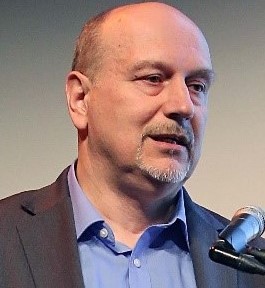 Lecturer, Dr. Michael Olszewski, Associate Professor, Division of Pulmonary and Critical Care Medicine, Department
of Internal Medicine University of Michigan Medical School, who gave a lecture entitled:
Cryptococcal Interactions with Pulmonary and CNS Host-Defenses: Implications for Immunotherapy. In his presentation, Dr. Olszewski addressed several studies focused on immunomodulation
and commented on the transitional values of these findings in reference to immunotherapy.
He stated that “as a result of immunotherapy, patients become highly susceptible to
fungal infections” and that “immune reconstitution or immune boost therapies may lead
to exuberant responses which become more lethal to the host than the infecting microbe.”
The first part of his talk, Dr. Olszewski focused on the mechanisms of immune disruption
post anti-tumor necrosis factor-alpha (TNF-α) therapy with consequences on anti-fungal
immunity and the second part on the development of ultra-Th1 response in the Cryptococcus-infected
CNS and the mechanisms of resultant immunopathology. He concluded his presentation
with a discussion of the translational implications of his team’s studies for immunosuppressive
and immune-boosting immunotherapies. Dr. Adam Rosebrock, Assistant Professor of Pathology,
introduced the
Lecturer, Dr. Michael Olszewski, Associate Professor, Division of Pulmonary and Critical Care Medicine, Department
of Internal Medicine University of Michigan Medical School, who gave a lecture entitled:
Cryptococcal Interactions with Pulmonary and CNS Host-Defenses: Implications for Immunotherapy. In his presentation, Dr. Olszewski addressed several studies focused on immunomodulation
and commented on the transitional values of these findings in reference to immunotherapy.
He stated that “as a result of immunotherapy, patients become highly susceptible to
fungal infections” and that “immune reconstitution or immune boost therapies may lead
to exuberant responses which become more lethal to the host than the infecting microbe.”
The first part of his talk, Dr. Olszewski focused on the mechanisms of immune disruption
post anti-tumor necrosis factor-alpha (TNF-α) therapy with consequences on anti-fungal
immunity and the second part on the development of ultra-Th1 response in the Cryptococcus-infected
CNS and the mechanisms of resultant immunopathology. He concluded his presentation
with a discussion of the translational implications of his team’s studies for immunosuppressive
and immune-boosting immunotherapies. Dr. Adam Rosebrock, Assistant Professor of Pathology,
introduced the 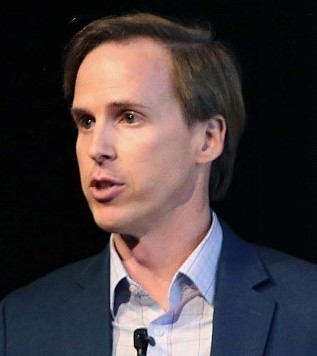 seventh Plenary Lecturer, Dr. Peter Smith, Scientist, Department of Infectious Diseases, Genentech, who gave a lecture entitled:
Optimized Arylomycins are a New Class of Gram-Negative Antibiotic. In his presentation, Dr. Smith stated that “multidrug-resistant bacteria are spreading
at alarming rates, and despite extensive efforts, no new class of antibiotic with
activity against Gram-negative bacteria has been approved in over fifty years.” He
stressed that natural products and their derivatives have played a significant role
in combating Gram-negative pathogens. He then described the optimization of the arylomycins,
a class of natural products with weak activity and limited spectrum to obtain G0775,
a molecule with potent, broad-spectrum activity against Gram-negative bacteria. He
then discussed the molecular mechanism by which G0775 inhibits the essential bacterial
type I signal peptidase, a new antibiotic target. Dr. Smith concluded his remarks
by addressing several mechanisms by which spontaneous resistance to G0775 can emerge
and strategies to minimize such resistance in vivo.
seventh Plenary Lecturer, Dr. Peter Smith, Scientist, Department of Infectious Diseases, Genentech, who gave a lecture entitled:
Optimized Arylomycins are a New Class of Gram-Negative Antibiotic. In his presentation, Dr. Smith stated that “multidrug-resistant bacteria are spreading
at alarming rates, and despite extensive efforts, no new class of antibiotic with
activity against Gram-negative bacteria has been approved in over fifty years.” He
stressed that natural products and their derivatives have played a significant role
in combating Gram-negative pathogens. He then described the optimization of the arylomycins,
a class of natural products with weak activity and limited spectrum to obtain G0775,
a molecule with potent, broad-spectrum activity against Gram-negative bacteria. He
then discussed the molecular mechanism by which G0775 inhibits the essential bacterial
type I signal peptidase, a new antibiotic target. Dr. Smith concluded his remarks
by addressing several mechanisms by which spontaneous resistance to G0775 can emerge
and strategies to minimize such resistance in vivo.
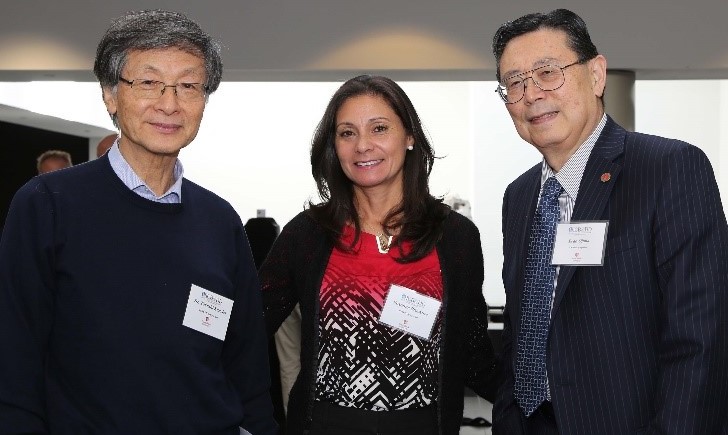

There were 76 posters presented in the Poster Session. The best three posters were selected for the Poster Awards. The award-winning posters this year were presented by Dr. Eszter Boros, Chair of the Posters Session, to Lisa MarieNisbett, a Postdoctoral Research Associate from the laboratory of Dr. Jessica Seeliger for her poster entitled: Exploring the Mechanism of Lipid Transport to the Outer Membrane of Mycobacteria in the LprG-Rv1410c Pathway; Michael Li, a student from the laboratory of Dr. Jessica Seeliger and the Chemical Biology Training Program, for his poster entitled: Towards Structure-Activity Relationships and Mechanism of Action in the Inhibition of Serine Hydrolase Enzymes in M. tuberculosisand Sneha Basak, a student from the laboratory of Dr. Peter Tonge for her poster entitled: Time Dependent Inhibition of LpxC. Each awardee received a $250.00 check, an award certificate and a pass to attend the symposium dinner with the invited lecturers.

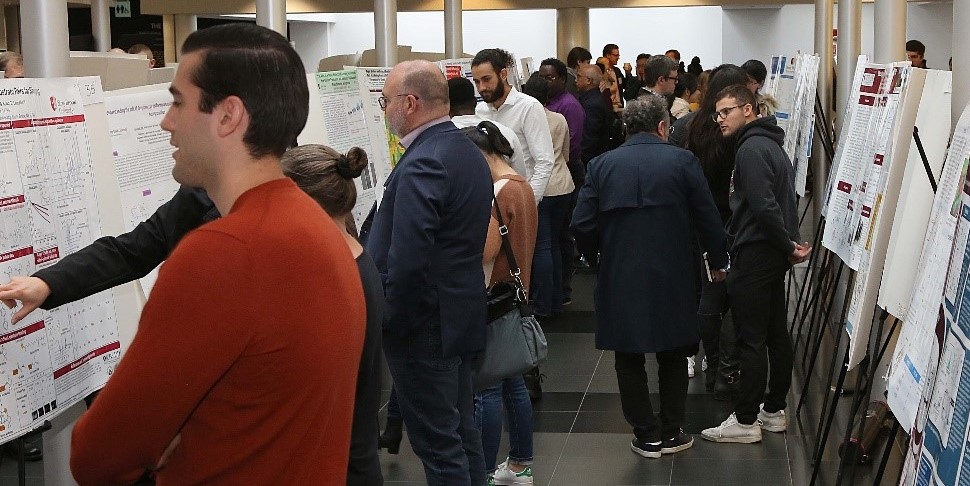
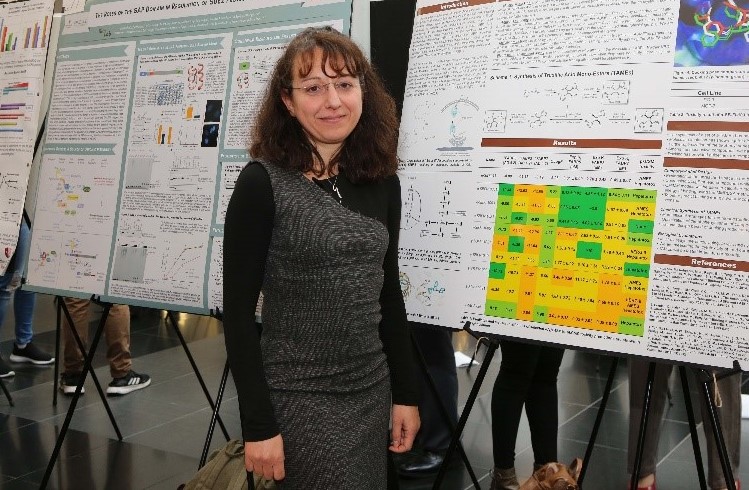

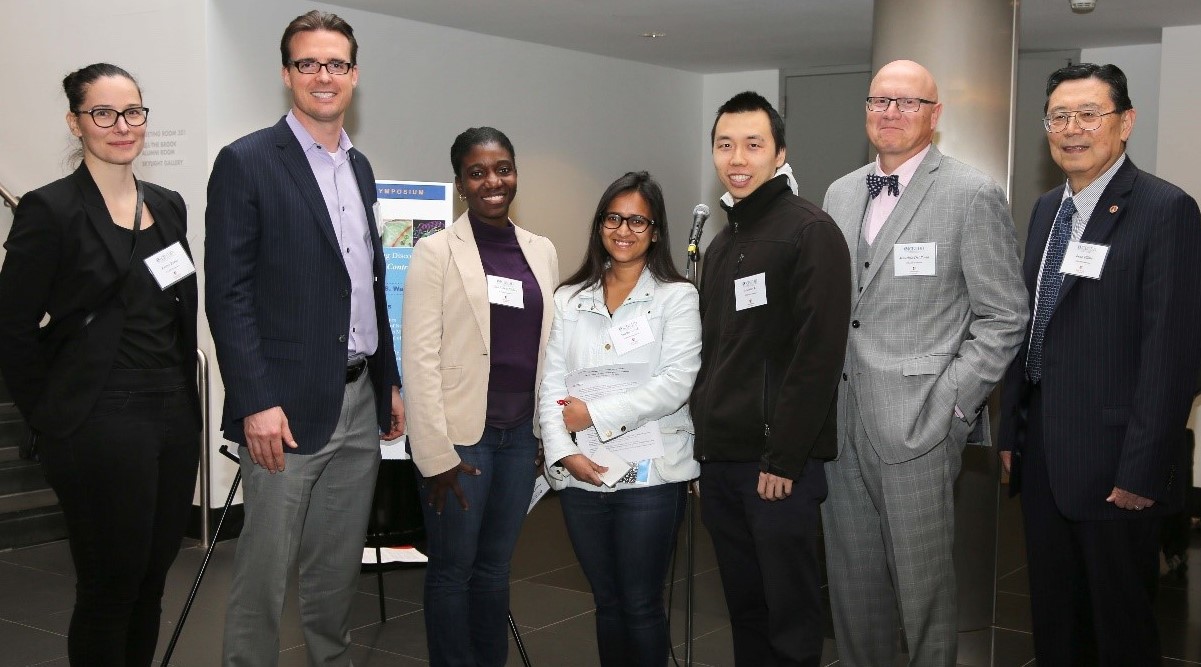
The Thirteenth ICB&DD Symposium culminated with a wonderful dinner at the Chapel of the Charles B. Wang Center. Among the attendees were: Dr. David Thanassi, Chairman of the Department of Microbiology and Immunology, Nicole Sampson, Distinguished Professor and Interim Dean of the College of Arts and Sciences. The Symposium Organizing Committee: Maurizio Del Poeta, Eszter Boros and Adam Rosebrock as well as Peter Tonge, Stony Brook University invited lecturer, expressed their appreciation for the outstanding lectures presented at the symposium. They all acknowledged the significance of the ICB&DD and the collaborative efforts among academia and industry. They also commended Dr. Ojima for his successful leadership, the ICB&DD operation and more than a decade-long cutting-edge Symposium. The ICB&DD symposium is widely recognized for being the only event on campus that gives the opportunity to the scientific community from East and West campus to come together and stimulate as well as promote the exchange of innovative ideas among speakers, faculty, staff, and students.
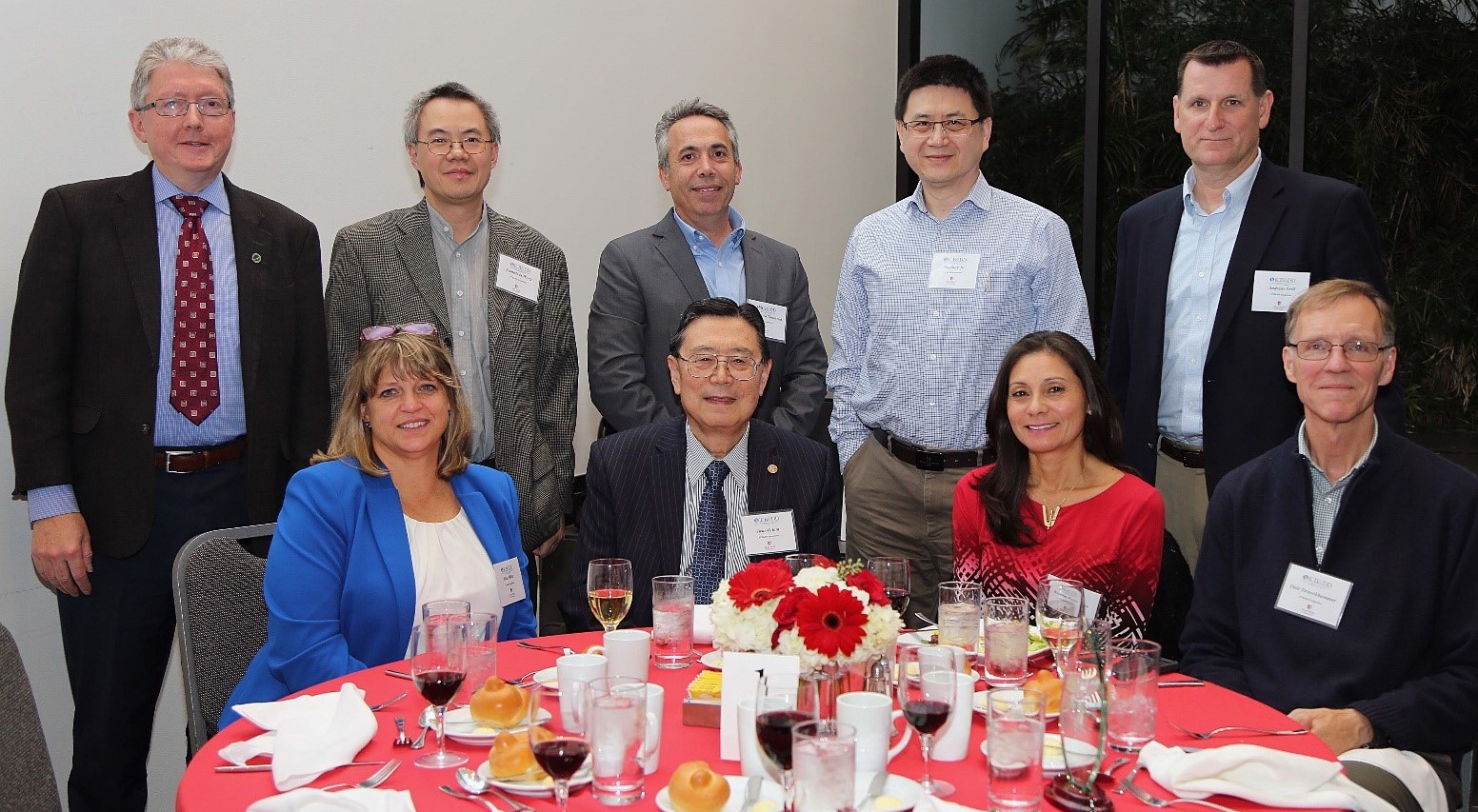
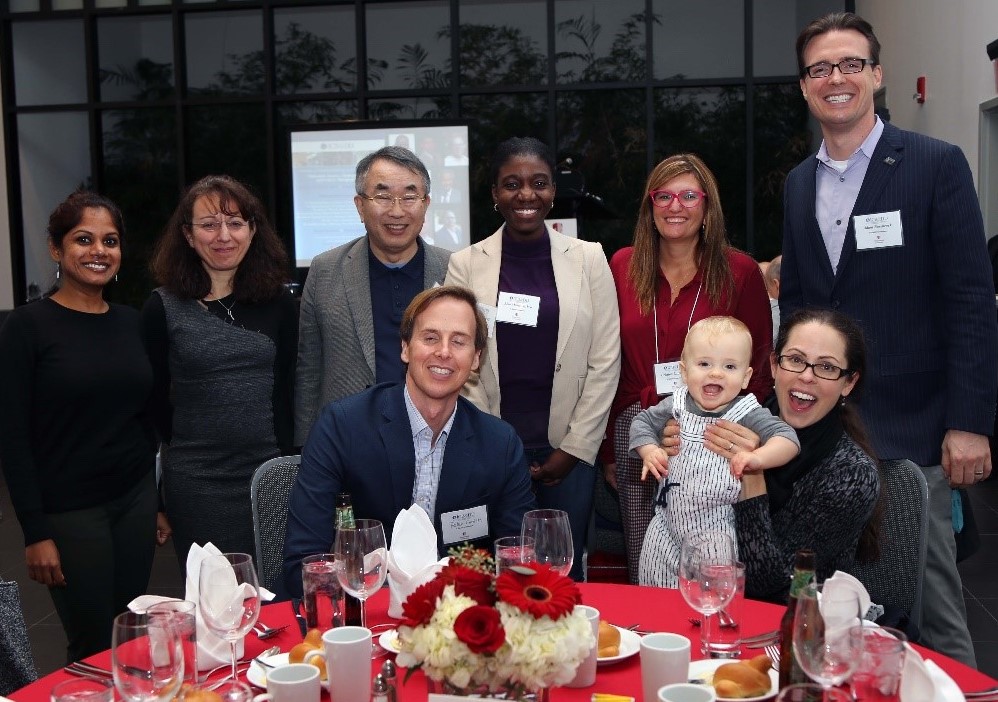
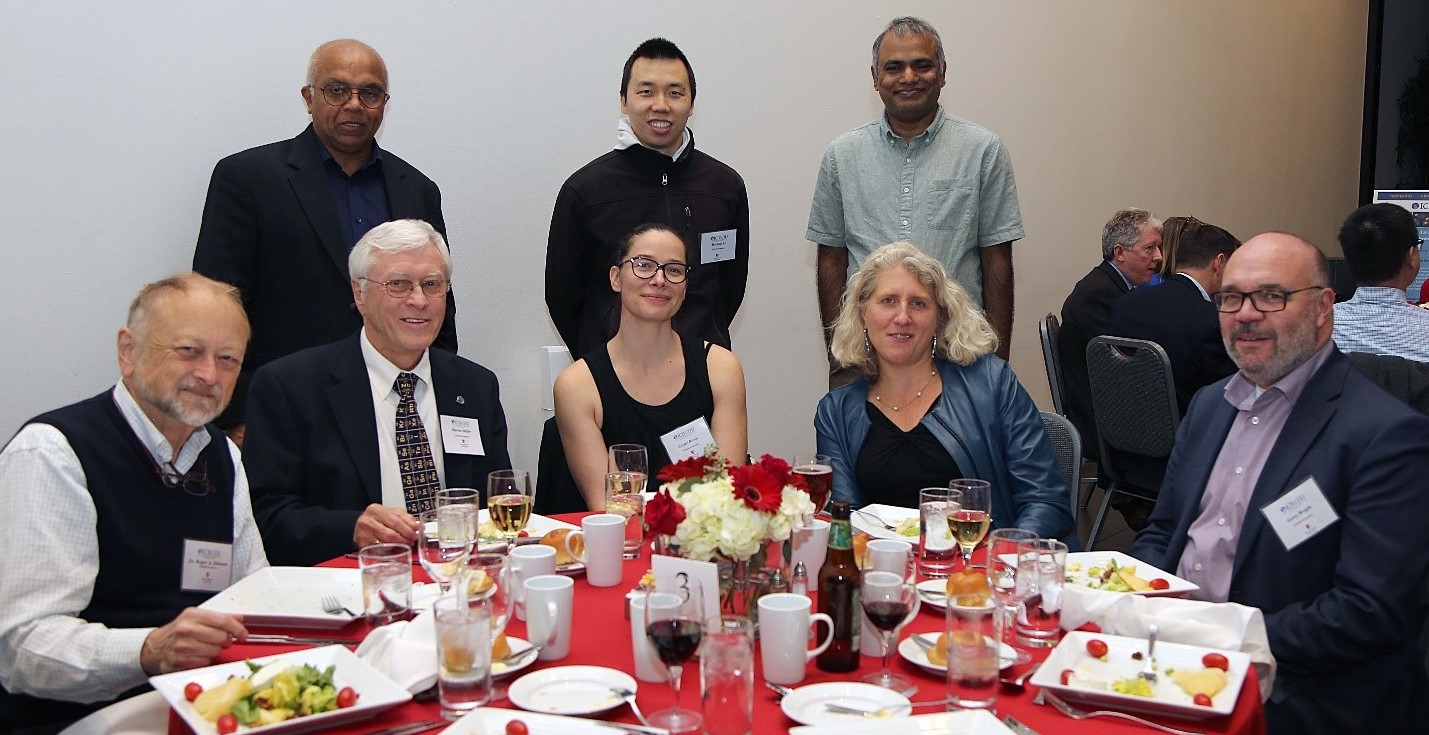

The Symposium was sponsored by Office of Vice-President of Research, School of Medicine, Department of Chemistry, Department of Microbiology and Immunology, Hoffmann & Baron LLP, Burroughs Welcome Fund, Chem-Master International Inc., Cambio Diagnostics Systems Inc and Avanti Biosciences Inc.
Please link to photos below
https://photos.app.goo.gl/McFSjufgc8fcSDBfA
ICB&DD Twelveth Annual Symposium (2018)
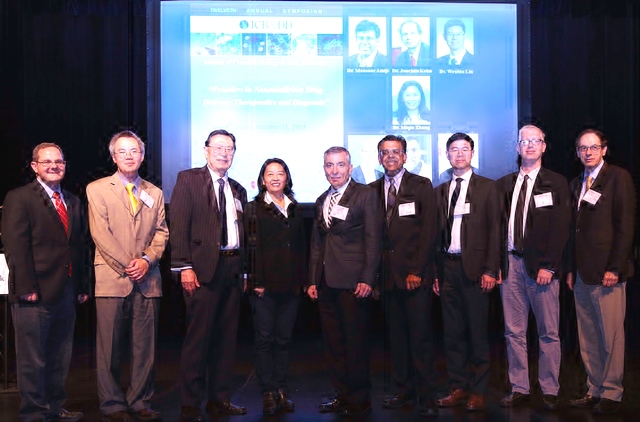
(from left to right) Drs. Jonathan Rudick, Stanislaus Wong, Iwao Ojima, Miqin Zhang,James Tour, Mansoor Amiji,,Wenbin Lin, Henry Hess and Joachim Kohn.
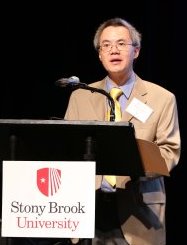 On Thursday, October 11, 2018, the ICB&DD hosted its Twelveth Annual Symposium entitled, “Frontiers in Nanomedicine:
Drug Delivery, Therapeutics and Diagnosis” at the Charles B. Wang Center, Stony Brook
University. The
On Thursday, October 11, 2018, the ICB&DD hosted its Twelveth Annual Symposium entitled, “Frontiers in Nanomedicine:
Drug Delivery, Therapeutics and Diagnosis” at the Charles B. Wang Center, Stony Brook
University. The Symposium featured seven Plenary Lecturers. Dr. Stanislaus Wong, represented the Department
of Chemistry of Stony Brook University. The event was attended by a diversified audience
composed of faculty, research staff and students on campus. The Poster Session equally
attracted participation from students from Stony Brook University. There were 49 scientific
posters presented at the Poster Session.
Symposium featured seven Plenary Lecturers. Dr. Stanislaus Wong, represented the Department
of Chemistry of Stony Brook University. The event was attended by a diversified audience
composed of faculty, research staff and students on campus. The Poster Session equally
attracted participation from students from Stony Brook University. There were 49 scientific
posters presented at the Poster Session.
Dr. Stanislaus Wong Professor of Chemistry and Chair of the Symposium Organizing Committee
opened the Symposium and introduced Dr. Lina Obeid, Dean of Research, Stony Brook
University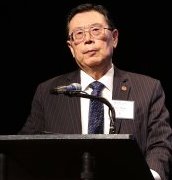 School of Medicine who gave the welcoming remarks for the Symposium. Then Dr. Wong
introduced Dr. Iwao Ojima, Distinguished Professor and Director of ICB&DD. Dr. Ojima
concisely summarized the history of accomplishments and the current and future goals
of ICB&DD.
School of Medicine who gave the welcoming remarks for the Symposium. Then Dr. Wong
introduced Dr. Iwao Ojima, Distinguished Professor and Director of ICB&DD. Dr. Ojima
concisely summarized the history of accomplishments and the current and future goals
of ICB&DD.
Dr. Dale Drueckhammer, Professor, Department of Chemistry introduced the first Plenary
Lecturer, Dr. Miqin Zhang, Kyocera Professor, Department of Materials Science & Engineering, University of Washington who gave a lecture entitled,
“Biodegradable Nanotheranostic Nanoparticles for Targeted Gene Therapy ”. In her presentation, Dr. Zhang described the development andassessment of a cancer-cell
specific magnetic nanovector construct for efficient gene delivery and non-invasive
monitoring through magnetic resonance imaging (MRI). She also presented applications
of the NP mediated siRNAs in combination with either radiation or chemotherapy for
treating deadly gliomblastoma.
Materials Science & Engineering, University of Washington who gave a lecture entitled,
“Biodegradable Nanotheranostic Nanoparticles for Targeted Gene Therapy ”. In her presentation, Dr. Zhang described the development andassessment of a cancer-cell
specific magnetic nanovector construct for efficient gene delivery and non-invasive
monitoring through magnetic resonance imaging (MRI). She also presented applications
of the NP mediated siRNAs in combination with either radiation or chemotherapy for
treating deadly gliomblastoma.
 Dr. Eszter Boros, Assistant Professor, Department of Chemistry, introduced the second
Plenary Lecturer, Dr. Joachim Kohn, Director, New Jersey Center for Biomaterials, Chair, International College of Fellows
(ICF-BSE) who gave a lecture entitled, “Tyrosine-derived Nanoparticles (TyroSpheres) and their Medical Applications”. TyroSpheres are polymeric nanospheres based on derivatives of the naturally occurring
amino acid L-tyrosine. TyroSpheres were first developed in 2004 by the Kohn group
and are composed of an amphiphilic A-B-A triblock copolymer. Dr. Kohn discussed the
main advantages of TyroSpheres are their low CMC, their extensive drug loading capability,
and their ability to increase significantly the water solubility of hydrophobic drugs.
Dr. Eszter Boros, Assistant Professor, Department of Chemistry, introduced the second
Plenary Lecturer, Dr. Joachim Kohn, Director, New Jersey Center for Biomaterials, Chair, International College of Fellows
(ICF-BSE) who gave a lecture entitled, “Tyrosine-derived Nanoparticles (TyroSpheres) and their Medical Applications”. TyroSpheres are polymeric nanospheres based on derivatives of the naturally occurring
amino acid L-tyrosine. TyroSpheres were first developed in 2004 by the Kohn group
and are composed of an amphiphilic A-B-A triblock copolymer. Dr. Kohn discussed the
main advantages of TyroSpheres are their low CMC, their extensive drug loading capability,
and their ability to increase significantly the water solubility of hydrophobic drugs. 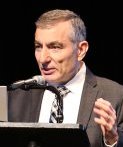
Dr. Stanislaus Wong, Professor, Department of Chemistry introduced the third Plenary Lecturer, Dr. James Tour, T. T. and W. F. Chao Professor, Department of Chemistry, Department of Computer Science and Department of Materials Science and Nano Engineering. Rice University, Smalley-Curl Institute and the Nano Carbon Center. Dr. Tour gave a lecture entitled, “Carbon Nanoparticles as Bridges for Electron Transfer in Mitochondria”. Dr. Tour talked about the efficacy of poly (ethylene glycol)-hydrophilic carbon clusters (PEG-HCCs) as broadly active and high capacity antioxidants in brain ischemia and injury models. PEG-HCCs are a type of highly oxidized graphene-based carbon nanomaterial composed of a highly oxidized carbon core with peroxyl, quinone, ketone, carboxylate, and hydroxyl functional groups. He describes a new property of these materials: the ability to shuttle electrons between key surrogates and proteins of the mitochondrial electron transport chain. He explained how these new findings may also extend their potential use to mitochondrial disorders.
 Dr. Elizabeth Boon Associate Professor, Department of Chemistry, introduced the fourth
Plenary Lecturer, Dr. Wenbin Lin, James Franck Professor, Department of Chemistry, the University of Chicago who gave
a lecture entitled, “Nanoscale Metal-Organic Frameworks for Cancer Therapy”. He discussed about his recent efforts on designing nanoscale metal-organic frameworks
(nMOFs) containing multiple therapeutics or treatment modalities for chemotherapy,
radiotherapy, and immunotherapy of resistant cancers.
Dr. Elizabeth Boon Associate Professor, Department of Chemistry, introduced the fourth
Plenary Lecturer, Dr. Wenbin Lin, James Franck Professor, Department of Chemistry, the University of Chicago who gave
a lecture entitled, “Nanoscale Metal-Organic Frameworks for Cancer Therapy”. He discussed about his recent efforts on designing nanoscale metal-organic frameworks
(nMOFs) containing multiple therapeutics or treatment modalities for chemotherapy,
radiotherapy, and immunotherapy of resistant cancers.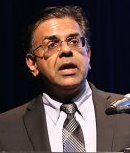
Dr. Ming-Yu Ngai Assistant Professor, Department of Chemistry, introduced the fifth Plenary Lecturer, Dr. Mansoor Amiji, Distinguished Professor, Department of Pharmaceutical Sciences, Northeastern University, School of Pharmacy. He gave a lecture entitled,“Integrated Nano-Medicine for Cancer and Inflammatory Diseases”. In his presentation he talked about new approaches for development of multifunctional engineered nano-systems for targeted therapies in the treatment of cancer and inflammatory diseases. He focused on challenging medical problems with innovative solutions that use safe materials and scalable fabrication methods in order to facilitate clinical translation and improve patient outcomes.
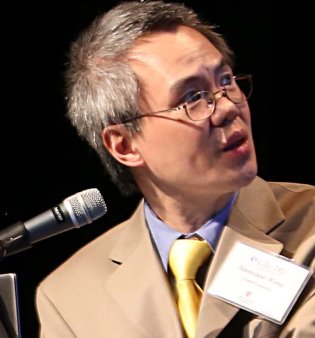 Dr. Jonathan Rudick Associate Professor, Department of Chemistry, introduced the sixth
Plenary Lecturer, Dr. Stanislaus Wong, Professor, Department of Chemistry, Stony Brook University who gave a lecture entitled,
“Functionalized Nanostructures in Biological and Biomedical Applications”. In his presentation, he focused on a number of recent collaborative efforts, involving
the labs of individual ICB&DD members. He spoke about interactions between hematite
(α-Fe2O3) Nanorhombohedra (N-Rhomb) and biological systems. In particular, microglia which
represents the first line of defense in the central nervous system (CNS) during severe
injury or disease such as Parkinson’s and Alzheimer’s as illustrative examples. He
presented preliminary results seeking to determine if microglia/macrophages will effectively
carry functionalized nanoparticles to tumor regions. If successful, the nanoparticles
could be used not only as compounds that can be used to treat cancer but also as non-invasive
diagnostics, given the paramagnetic (MRI-appropriate) properties of nanoparticles.
Dr. Jonathan Rudick Associate Professor, Department of Chemistry, introduced the sixth
Plenary Lecturer, Dr. Stanislaus Wong, Professor, Department of Chemistry, Stony Brook University who gave a lecture entitled,
“Functionalized Nanostructures in Biological and Biomedical Applications”. In his presentation, he focused on a number of recent collaborative efforts, involving
the labs of individual ICB&DD members. He spoke about interactions between hematite
(α-Fe2O3) Nanorhombohedra (N-Rhomb) and biological systems. In particular, microglia which
represents the first line of defense in the central nervous system (CNS) during severe
injury or disease such as Parkinson’s and Alzheimer’s as illustrative examples. He
presented preliminary results seeking to determine if microglia/macrophages will effectively
carry functionalized nanoparticles to tumor regions. If successful, the nanoparticles
could be used not only as compounds that can be used to treat cancer but also as non-invasive
diagnostics, given the paramagnetic (MRI-appropriate) properties of nanoparticles.
Dr. Jarrod French, Assistant Professor, Department of Chemistry and Department of
Biochemistry, introduced the seventh Plenary Lecturer, Dr. Henry Hess, Professor and Editor-in-Chief, IEEE Transactions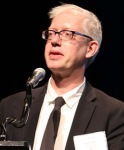 on Nanobioscience, Department of Biomedical Engineering, Columbia University who gave
a lecture entitled, “Engineering with Biomolecular Motors and Enzyme Cascades”. Dr. Hess most recent work created a molecular system that is capable of dynamically
assembling and disassembling its building blocks while retaining its functionality,
and demonstrates the possibility of self- healing and adaptation. In his presentation
he discussed his perspective on the role of scaffolds in the organization of enzyme
cascade reactions and his recent efforts to understand metabolon formation in cells.
The correct application of biophysical principles provides important insights into
the role of spatial organization for the complex biochemical reactions occurring in
the cell as well as in biotechnological processes.
on Nanobioscience, Department of Biomedical Engineering, Columbia University who gave
a lecture entitled, “Engineering with Biomolecular Motors and Enzyme Cascades”. Dr. Hess most recent work created a molecular system that is capable of dynamically
assembling and disassembling its building blocks while retaining its functionality,
and demonstrates the possibility of self- healing and adaptation. In his presentation
he discussed his perspective on the role of scaffolds in the organization of enzyme
cascade reactions and his recent efforts to understand metabolon formation in cells.
The correct application of biophysical principles provides important insights into
the role of spatial organization for the complex biochemical reactions occurring in
the cell as well as in biotechnological processes.


The bes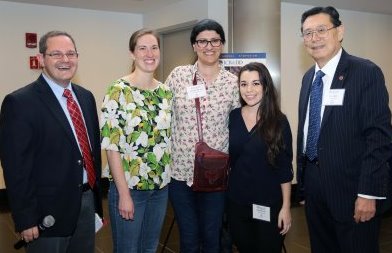 t three of the 48 posters presented in the Poster Session were selected for the Poster
Awards. The award winning posters this year were presented by Alyssa N. Preston, from the research group of Dr. Scott T. Laughlin for her poster entitled, “Chemical Approaches to Visualizing the Brain's Astrocytes”; Ilana Heckler . From the research group of Dr. Elizabeth Boon for her poster entitled, “Discovery of a Nitric Oxide Responsive Quorum SensingCircuit in Vibrio Cholera” and Shabnam Davoodi from the research group of Dr. Peter Tonge for her poster entitled, “The Impact of Tyr158 pKa on Proton Transferring Process in InhA Active Site”.
t three of the 48 posters presented in the Poster Session were selected for the Poster
Awards. The award winning posters this year were presented by Alyssa N. Preston, from the research group of Dr. Scott T. Laughlin for her poster entitled, “Chemical Approaches to Visualizing the Brain's Astrocytes”; Ilana Heckler . From the research group of Dr. Elizabeth Boon for her poster entitled, “Discovery of a Nitric Oxide Responsive Quorum SensingCircuit in Vibrio Cholera” and Shabnam Davoodi from the research group of Dr. Peter Tonge for her poster entitled, “The Impact of Tyr158 pKa on Proton Transferring Process in InhA Active Site”.
The 12th ICB&DD Symposium culminated with a wonderful dinner at the Chapel of the Charles B. Wang Center. Among attendees were Dr. Lina Obeid, Distinguished Professor and Dean of Research, Yusuf Hannun, Director Stony Brook Cancer Center, Nancy Goroff, Chair of the Department of Chemistry, Kenneth Shroyer, Chair Department of Chemistry. They expressed their appreciation for the outstanding lectures presented at the symposium, as well as acknowledged the significance of the ICB&DD and the collaborative efforts among academia and industry. They also commended Dr. Ojima for his successful leadership for the ICB&DD operation and more than a decade-long cutting-edge Symposium.
The Symposium was co-sponsored by the Office of the Vice-President for Research, Stony Brook School of Medicine, Department of Chemistry, Chembio Diagnostics Systems Inc., Chem-Master International, Inc., Avanti Biosciences Inc., Targagenix Inc, and Hoffmann and Baron LLP.
Please link to photos below
https://photos.app.goo.gl/SCkFRv7vKpWDMaq17
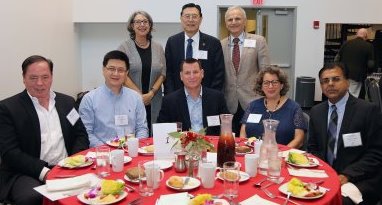

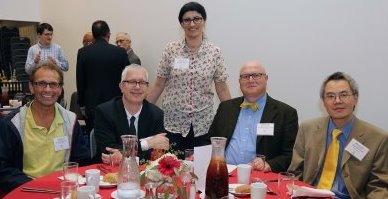
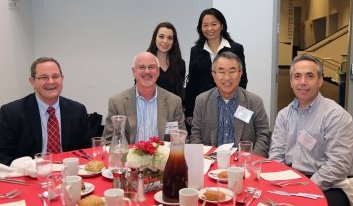
ICB&DD Eleventh Annual Symposium (2017)
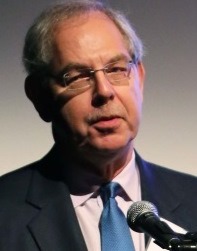
 On Friday, October 6, 2017, the ICB&DD hosted its Eleventh Annual Symposium entitled, “Frontiers in Chemical Biology and Drug Discovery”at the Charles B. Wang Center, Stony Brook University. This year it was also held
as the second joint-symposium with Icahn School of Medicine at Mount Sinai. The Symposium
featured eight Plenary Lecturers: Dr. Michael Airola, Assistant Professor, Department
of Biochemistry and Cell Biology, Dr. Jingfang Ju, Department of Pathology, Stony
Brook School of Medicine, Dr. Dima Kozakov, Assistant Professor, Department of Applied
Mathematics and Statistics and Dr. Nicole Sampson, Professor, Department of Chemistry.
These four speakers represented Stony Brook University. Dr. Ming-Ming Zhou, Professor
and Chairman, Department of Pharmacological Sciences, Dr.
On Friday, October 6, 2017, the ICB&DD hosted its Eleventh Annual Symposium entitled, “Frontiers in Chemical Biology and Drug Discovery”at the Charles B. Wang Center, Stony Brook University. This year it was also held
as the second joint-symposium with Icahn School of Medicine at Mount Sinai. The Symposium
featured eight Plenary Lecturers: Dr. Michael Airola, Assistant Professor, Department
of Biochemistry and Cell Biology, Dr. Jingfang Ju, Department of Pathology, Stony
Brook School of Medicine, Dr. Dima Kozakov, Assistant Professor, Department of Applied
Mathematics and Statistics and Dr. Nicole Sampson, Professor, Department of Chemistry.
These four speakers represented Stony Brook University. Dr. Ming-Ming Zhou, Professor
and Chairman, Department of Pharmacological Sciences, Dr. 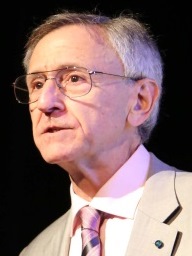 Dusan Bogunovic, Assistant Professor, Department of Microbiology, Dr. Arvin Dar, Assistant
Professor, Department of Oncological Sciences and Dr. Michael Lazarus, Assistant Professor,
Department of Pharmacological Sciences. They represented Icahn School of Medicine
at Mt. Sinai. The event was very well attended by a diversified audience composed
of faculty, research staff and students on campus, as well as universities and industries
in the Greater New York metropolitan area. The Poster Session equally attracted a
large participation of students from Stony Brook University, the Laufer Center for
Physical and Quantitative Biology, Icahn School of Medicine at Mt. Sinai School, Chembio
Diagnostics Systems Inc., among others. There were 60 scientific posters presented
at the Poster Session.
Dusan Bogunovic, Assistant Professor, Department of Microbiology, Dr. Arvin Dar, Assistant
Professor, Department of Oncological Sciences and Dr. Michael Lazarus, Assistant Professor,
Department of Pharmacological Sciences. They represented Icahn School of Medicine
at Mt. Sinai. The event was very well attended by a diversified audience composed
of faculty, research staff and students on campus, as well as universities and industries
in the Greater New York metropolitan area. The Poster Session equally attracted a
large participation of students from Stony Brook University, the Laufer Center for
Physical and Quantitative Biology, Icahn School of Medicine at Mt. Sinai School, Chembio
Diagnostics Systems Inc., among others. There were 60 scientific posters presented
at the Poster Session.
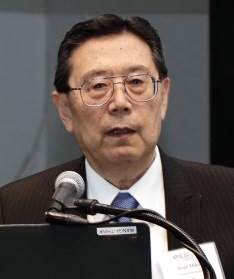 Dr. John Haley, Research Associate Professor of Pathology, Stony Brook University and Chair of the
Symposium Organizing Committee, opened the Symposium and introduced Dr. Scott L. Friedman, Dean of Therapeutic Discovery, Icahn School of Medicine at Mount Sinai, who gave
the welcoming remarks and briefly described the background and importance of the SBU-ISMMS
joint-symposiums. Then, Dr. Haley introduced Dr. Kenneth Kaushansky, Dean, Stony Brook University School of Medicine. Dr. Kaushansky congratulated the
joint symposium, emphasized the importance of the collaboration between the two institutions,
and then introduced
Dr. Iwao Ojima, Distinguished Professor and Director of ICB&DD. Dr. Ojima concisely summarized the
history of accomplishments and the current and future goals of ICB&DD.
Dr. John Haley, Research Associate Professor of Pathology, Stony Brook University and Chair of the
Symposium Organizing Committee, opened the Symposium and introduced Dr. Scott L. Friedman, Dean of Therapeutic Discovery, Icahn School of Medicine at Mount Sinai, who gave
the welcoming remarks and briefly described the background and importance of the SBU-ISMMS
joint-symposiums. Then, Dr. Haley introduced Dr. Kenneth Kaushansky, Dean, Stony Brook University School of Medicine. Dr. Kaushansky congratulated the
joint symposium, emphasized the importance of the collaboration between the two institutions,
and then introduced
Dr. Iwao Ojima, Distinguished Professor and Director of ICB&DD. Dr. Ojima concisely summarized the
history of accomplishments and the current and future goals of ICB&DD.
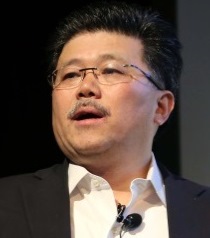 Dr. Steven Glynn, Assistant Professor, Department of Biochemistry, introduced the
First Plenary Lecturer, Dr. Ming-Ming Zhou, Dr. Harold and Golden Lamport Professor and Chairman, Department of Pharmacological
Sciences, Icahn School of Medicine at Mount Sinai, who gave a lecture entitled, “From
Epigenetic Structural Mechanism to Targeted Therapy”. In his presentation, Dr. Zhou
provided an overview of his investigative team’s latest structural and mechanistic
study of protein-protein interactions involving master transcription factors and core
histones that play an important role in epigenetic control of gene transcription,
cell proliferation and lineage-specific differentiation. In addition, he discussed
the functional implications of the new findings on the basic principles that govern
the molecular interactions and regulation in gene expression and strategies for developing
new targeted epigenetic therapy for human diseases, including cancer and inflammation.
Dr. Steven Glynn, Assistant Professor, Department of Biochemistry, introduced the
First Plenary Lecturer, Dr. Ming-Ming Zhou, Dr. Harold and Golden Lamport Professor and Chairman, Department of Pharmacological
Sciences, Icahn School of Medicine at Mount Sinai, who gave a lecture entitled, “From
Epigenetic Structural Mechanism to Targeted Therapy”. In his presentation, Dr. Zhou
provided an overview of his investigative team’s latest structural and mechanistic
study of protein-protein interactions involving master transcription factors and core
histones that play an important role in epigenetic control of gene transcription,
cell proliferation and lineage-specific differentiation. In addition, he discussed
the functional implications of the new findings on the basic principles that govern
the molecular interactions and regulation in gene expression and strategies for developing
new targeted epigenetic therapy for human diseases, including cancer and inflammation.
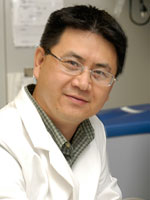 Dr. John Haley, introduced the second Plenary Lecturer, Dr. Jingfang Ju, Professor, Department of Pathology, Stony Brook University School of Medicine, who
gave a lecture entitled, “The Development of miRNA-Based Therapeutics for Colorectal
Cancer”. In his presentation, Dr. Ju discussed his laboratory’s findings that the
translational regulation of suspected genes in cancer has come to a new frontier in
recent years. He stated that, “Mounting evidence showed that post-transcriptional
and translational controls mediated by various regulatory molecules, such as RNA-binding
proteins and non-coding RNAs (e.g. miRNAs), are critically important.” His team “uncovered
a novel mechanism that a number of miRNAs were regulated by tumor suppressor p53 in
colon cancer. Such a regulatory mechanism is important in regulating cell proliferation
and cell cycle control.” He believes that, given the significant role of miRNAs in
many aspects of tumor development such as proliferation, autophagy, cell cycle control,
invasion, EMT and maintained tumor stem cell phenotype, he is hopeful that miRNA based
therapeutics, diagnosis and prognosis may emerge in the near future to benefit patients.
Dr. John Haley, introduced the second Plenary Lecturer, Dr. Jingfang Ju, Professor, Department of Pathology, Stony Brook University School of Medicine, who
gave a lecture entitled, “The Development of miRNA-Based Therapeutics for Colorectal
Cancer”. In his presentation, Dr. Ju discussed his laboratory’s findings that the
translational regulation of suspected genes in cancer has come to a new frontier in
recent years. He stated that, “Mounting evidence showed that post-transcriptional
and translational controls mediated by various regulatory molecules, such as RNA-binding
proteins and non-coding RNAs (e.g. miRNAs), are critically important.” His team “uncovered
a novel mechanism that a number of miRNAs were regulated by tumor suppressor p53 in
colon cancer. Such a regulatory mechanism is important in regulating cell proliferation
and cell cycle control.” He believes that, given the significant role of miRNAs in
many aspects of tumor development such as proliferation, autophagy, cell cycle control,
invasion, EMT and maintained tumor stem cell phenotype, he is hopeful that miRNA based
therapeutics, diagnosis and prognosis may emerge in the near future to benefit patients.
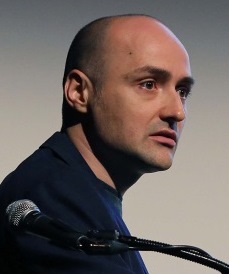 Dr. Maurizio Del Poeta, Professor, Department of Molecular Genetics and Microbiology
introduced the third Plenary Lecturer, Dr. Dusan Bogunovic, Assistant Professor, Department of Oncological Sciences and Department of Pharmacological
Sciences, Icahn School of Medicine at Mount Sinai, who gave a lecture entitled, “Broad
Spectrum Antivirals: Human Genetics Leading Therapy”. In his presentation, Dr. Bugunovic
discussed his group’s use of next-generation sequencing in the discovery of humans
who have augmented protection against viral infections. He stated that, “These individuals
have loss-of-function mutations in ISG15, a negative regulator of Type I interferon (IFN) pathway. Clinically, ISG15 deficient
individuals are largely asymptomatic, but functionally have low-level, persistent
transcription of IFN stimulated genes”. He reported that his research group has recently
demonstrated that “this small amount of IFN stimulated gene transcripts confers increased
protection against a broad spectrum of viruses”.
Dr. Maurizio Del Poeta, Professor, Department of Molecular Genetics and Microbiology
introduced the third Plenary Lecturer, Dr. Dusan Bogunovic, Assistant Professor, Department of Oncological Sciences and Department of Pharmacological
Sciences, Icahn School of Medicine at Mount Sinai, who gave a lecture entitled, “Broad
Spectrum Antivirals: Human Genetics Leading Therapy”. In his presentation, Dr. Bugunovic
discussed his group’s use of next-generation sequencing in the discovery of humans
who have augmented protection against viral infections. He stated that, “These individuals
have loss-of-function mutations in ISG15, a negative regulator of Type I interferon (IFN) pathway. Clinically, ISG15 deficient
individuals are largely asymptomatic, but functionally have low-level, persistent
transcription of IFN stimulated genes”. He reported that his research group has recently
demonstrated that “this small amount of IFN stimulated gene transcripts confers increased
protection against a broad spectrum of viruses”.
 Dr. Martin Kaczocha, Assistant Professor, Department of Anesthesiology , introduced
the fourth Plenary Lecturer, Dr. Arvin Dar, Department of Oncological Sciences and Department of Pharmacological Sciences, Icahn
School of Medicine at Mount Sinai, who gave a lecture entitled, “A Whole Animal Platform
to Advance a Clinical Kinase Inhibitor into New Disease Space”. In his presentation,
Dr. Dar described his research and studies on signal transduction networks at multiple
levels: structurally, biochemically, within cells, and also within whole animals.
He stressed that a goal of his research program is “to build the tools that will allow
us to modulate signaling networks within the context of cells and animals for therapeutic
applications”. In his talk, Dr. Dar presented his recent work, employing methods from
synthetic organic chemistry, X-ray crystallography, informatics, biochemistry and
model organism genetics to develop novel kinase inhibitors.
Dr. Martin Kaczocha, Assistant Professor, Department of Anesthesiology , introduced
the fourth Plenary Lecturer, Dr. Arvin Dar, Department of Oncological Sciences and Department of Pharmacological Sciences, Icahn
School of Medicine at Mount Sinai, who gave a lecture entitled, “A Whole Animal Platform
to Advance a Clinical Kinase Inhibitor into New Disease Space”. In his presentation,
Dr. Dar described his research and studies on signal transduction networks at multiple
levels: structurally, biochemically, within cells, and also within whole animals.
He stressed that a goal of his research program is “to build the tools that will allow
us to modulate signaling networks within the context of cells and animals for therapeutic
applications”. In his talk, Dr. Dar presented his recent work, employing methods from
synthetic organic chemistry, X-ray crystallography, informatics, biochemistry and
model organism genetics to develop novel kinase inhibitors.
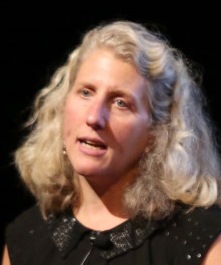 Dr. Scott Laughlin, Assistant Professor, Department of Chemistry, introduced the fifth
Plenary Lecturer, Dr. Nicole Sampson, Department of Chemistry, Stony Brook University, who gave a lecture entitled, “Cholesterol
Metabolic Pathways in M. tuberculosis: Opportunities for Tuberculosis Drug Discovery and Diagnosis”. In her presentation,
Dr. Sampson stated that, “Tuberculosis (TB) is the number one killer from infectious
disease in the world. Current drug regiments are lengthy and toxic, and new approaches
to TB treatment are needed.” She stressed that, “existing diagnostic tools fail to
confirm TB in most children, who typically have disease with low bacterial counts”. Mycobacterium tuberculosis (Mtb), is the causative agent of TB, and infects and divides inside human immune cells.
The ability of Mtb to metabolize human cholesterol is critical for the maintenance of the Mtb infection in these cells. She stressed that, building on her laboratory’s biochemical
basis on the cholesterol metabolism, her team has identified potential avenues for
both diagnosing TB disease more readily, particularly in children and improving treatment
of TB.
Dr. Scott Laughlin, Assistant Professor, Department of Chemistry, introduced the fifth
Plenary Lecturer, Dr. Nicole Sampson, Department of Chemistry, Stony Brook University, who gave a lecture entitled, “Cholesterol
Metabolic Pathways in M. tuberculosis: Opportunities for Tuberculosis Drug Discovery and Diagnosis”. In her presentation,
Dr. Sampson stated that, “Tuberculosis (TB) is the number one killer from infectious
disease in the world. Current drug regiments are lengthy and toxic, and new approaches
to TB treatment are needed.” She stressed that, “existing diagnostic tools fail to
confirm TB in most children, who typically have disease with low bacterial counts”. Mycobacterium tuberculosis (Mtb), is the causative agent of TB, and infects and divides inside human immune cells.
The ability of Mtb to metabolize human cholesterol is critical for the maintenance of the Mtb infection in these cells. She stressed that, building on her laboratory’s biochemical
basis on the cholesterol metabolism, her team has identified potential avenues for
both diagnosing TB disease more readily, particularly in children and improving treatment
of TB.
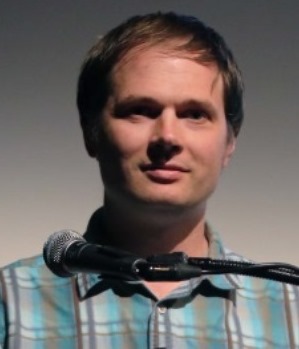 Dr. Robert Rizzo, Professor, Department of Mathematics introduced the sixth Plenary
Lecturer, Dr. Dima Kozakov, Assistant Professor, Department of Applied Mathematics and Statistics, Faculty Member,
Laufer Center for Physical Quantitative Biology, Stony Brook University, who gave
a lecture entitled, “Modeling and Modulation of Protein Interactions”. In his presentation,
Dr. Kozakov focused on the understanding of the key principles of disrupting protein-protein
interactions using small molecules, macrocycles or other compounds because modulating
protein interactions for therapeutic purposes has become one of the modern frontiers
of biomedical research. His group accomplished the disruption of the protein-protein
interactions by introducing the concept of hot spots, which are regions of surface
that disproportionally contribute to binding free energy. Hot spots were determined
by modeling the interaction of proteins with a number of small molecules used as probes.
This method is a direct computational analogue of experimental techniques, and uses
the FFT-based sampling approach. Dr. Kozakov then demonstrated how these hot spots
provided information on the ability of drug-like small molecules for binding to the
site of protein-protein interactions, as well as allosteric sites.
Dr. Robert Rizzo, Professor, Department of Mathematics introduced the sixth Plenary
Lecturer, Dr. Dima Kozakov, Assistant Professor, Department of Applied Mathematics and Statistics, Faculty Member,
Laufer Center for Physical Quantitative Biology, Stony Brook University, who gave
a lecture entitled, “Modeling and Modulation of Protein Interactions”. In his presentation,
Dr. Kozakov focused on the understanding of the key principles of disrupting protein-protein
interactions using small molecules, macrocycles or other compounds because modulating
protein interactions for therapeutic purposes has become one of the modern frontiers
of biomedical research. His group accomplished the disruption of the protein-protein
interactions by introducing the concept of hot spots, which are regions of surface
that disproportionally contribute to binding free energy. Hot spots were determined
by modeling the interaction of proteins with a number of small molecules used as probes.
This method is a direct computational analogue of experimental techniques, and uses
the FFT-based sampling approach. Dr. Kozakov then demonstrated how these hot spots
provided information on the ability of drug-like small molecules for binding to the
site of protein-protein interactions, as well as allosteric sites.
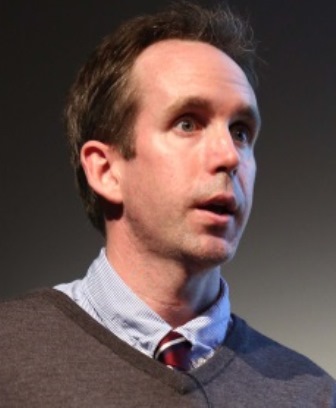 Dr. Jarrod French, Department of Biochemistry, introduced the seventh Plenary Lecturer, Dr. Michael Airola, Assistant Professor, Department of Biochemistry and Cell Biology, Stony Brook University,
who gave a lecture entitled, "Structure, Function, and Inhibition of Lipid Metabolism
in Cancer". In his presentation, Dr. Airola explored his observation, “During the
past thirty years, the perceived role of lipids has shifted from simple structural
components of cell membranes to bioactive molecules that regulate critical cellular
and pathological processes”. He stated that, “The enzymes that generate and breakdown
these bioactive lipids have emerged as novel therapeutic targets for treating the
leading causes of diseases in the United States, including cancer”. In his talk, Dr.
Airola presented new insight into the way that two key enzymes in sphingolipid metabolism
work at the molecular and structural level. These include the colon cancer therapeutic
target, human neutral ceramidase, and the membrane-associated enzyme, neutral sphingomyelinase
2 which has established roles in neurodegeneration, metastasis, and intracellular
communication.
Dr. Jarrod French, Department of Biochemistry, introduced the seventh Plenary Lecturer, Dr. Michael Airola, Assistant Professor, Department of Biochemistry and Cell Biology, Stony Brook University,
who gave a lecture entitled, "Structure, Function, and Inhibition of Lipid Metabolism
in Cancer". In his presentation, Dr. Airola explored his observation, “During the
past thirty years, the perceived role of lipids has shifted from simple structural
components of cell membranes to bioactive molecules that regulate critical cellular
and pathological processes”. He stated that, “The enzymes that generate and breakdown
these bioactive lipids have emerged as novel therapeutic targets for treating the
leading causes of diseases in the United States, including cancer”. In his talk, Dr.
Airola presented new insight into the way that two key enzymes in sphingolipid metabolism
work at the molecular and structural level. These include the colon cancer therapeutic
target, human neutral ceramidase, and the membrane-associated enzyme, neutral sphingomyelinase
2 which has established roles in neurodegeneration, metastasis, and intracellular
communication.
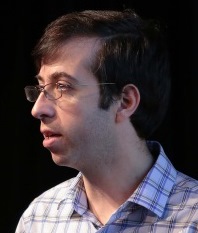 Dr. Adam Rosebrock, Assistant Professor, Department of Pahtology, introduced the eighth
Plenary Lecturer, Dr. Michael Lazarus, Assistant Professor, Department of Pharmacological Sciences, Icahn School of Medicine
at Mount Sinai, who gave a lecture entitled, “The Incredible ULKs: Structure and Inhibition
of Autophagy Kinases”. In his presentation, Dr. Lazarus discussed his research team’s
research on small molecule inhibitors against key enzymes of a family of kinases,
called ULKs that initiate autophagy. He identified autophagy as a “fundamental cellular
pathway conserved from yeast to humans” which is “necessary for development and normal
cellular function”. “These enzymes diverged from the yeast kinase Atg1 and have more
complex roles in mammalian cells in general and in cancer in particular.” His group
“solved the first structure of ULK1 and is developing inhibitors to probe the therapeutic
value of targeting autophagy alone or as a combination treatment for numerous malignancies”.
Dr. Lazarus stressed that the strategy of targeting ULK1 and ULK2 could be beneficial
for cancer treatment.
Dr. Adam Rosebrock, Assistant Professor, Department of Pahtology, introduced the eighth
Plenary Lecturer, Dr. Michael Lazarus, Assistant Professor, Department of Pharmacological Sciences, Icahn School of Medicine
at Mount Sinai, who gave a lecture entitled, “The Incredible ULKs: Structure and Inhibition
of Autophagy Kinases”. In his presentation, Dr. Lazarus discussed his research team’s
research on small molecule inhibitors against key enzymes of a family of kinases,
called ULKs that initiate autophagy. He identified autophagy as a “fundamental cellular
pathway conserved from yeast to humans” which is “necessary for development and normal
cellular function”. “These enzymes diverged from the yeast kinase Atg1 and have more
complex roles in mammalian cells in general and in cancer in particular.” His group
“solved the first structure of ULK1 and is developing inhibitors to probe the therapeutic
value of targeting autophagy alone or as a combination treatment for numerous malignancies”.
Dr. Lazarus stressed that the strategy of targeting ULK1 and ULK2 could be beneficial
for cancer treatment.
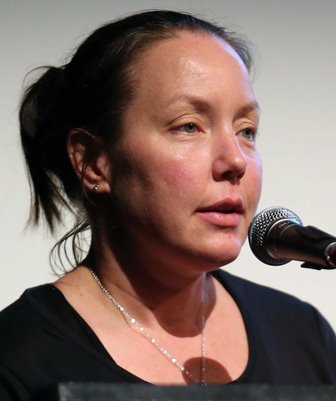 Dr. Elizabeth Boon, Associate Professor, Department of Chemistry gave the closing remarks, thanking
the Plenary Lecturers for their outstanding presentations as well as the Organizing
Committee members for their successful planning and execution of the Eleventh Annual
ICB&DD Symposium.
Dr. Elizabeth Boon, Associate Professor, Department of Chemistry gave the closing remarks, thanking
the Plenary Lecturers for their outstanding presentations as well as the Organizing
Committee members for their successful planning and execution of the Eleventh Annual
ICB&DD Symposium.
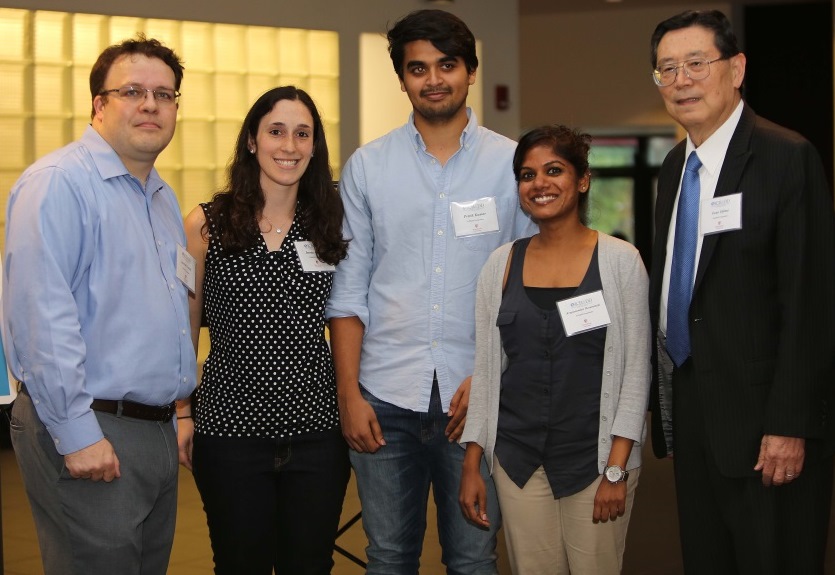 The best three posters of the 60 scientific papers presented in the Poster Session
were selected for the Poster Awards. Dr. Jarrod French, Chair of the Poster Session Committee presented the awards to the selected winners. The
award winning posters this year were Krupa Haranahalli from the laboratory of Dr. Iwao Ojima for her poster entitled:“SAR Study on Novel Anti-Fungal Agents Targeting the Synthesis of Fungal Sphingolipids”, Pratik Kumar from the laboratory of Scott Laughlin, for his poster entitled: “3-N Spirocyclopropenes
Provide Spatiotemporal Control of Bioorthogonal and Jennie B. Altman from the laboratory of Dr. Bogunovic, Department of Microbiology, Icahn School of
Medicine at Mount Sinai for her poster entitled: “Broad Spectrum Antivirals - Human
Genetics Leading Therapy Utilizing ISG15 Deficiency”.
The best three posters of the 60 scientific papers presented in the Poster Session
were selected for the Poster Awards. Dr. Jarrod French, Chair of the Poster Session Committee presented the awards to the selected winners. The
award winning posters this year were Krupa Haranahalli from the laboratory of Dr. Iwao Ojima for her poster entitled:“SAR Study on Novel Anti-Fungal Agents Targeting the Synthesis of Fungal Sphingolipids”, Pratik Kumar from the laboratory of Scott Laughlin, for his poster entitled: “3-N Spirocyclopropenes
Provide Spatiotemporal Control of Bioorthogonal and Jennie B. Altman from the laboratory of Dr. Bogunovic, Department of Microbiology, Icahn School of
Medicine at Mount Sinai for her poster entitled: “Broad Spectrum Antivirals - Human
Genetics Leading Therapy Utilizing ISG15 Deficiency”.
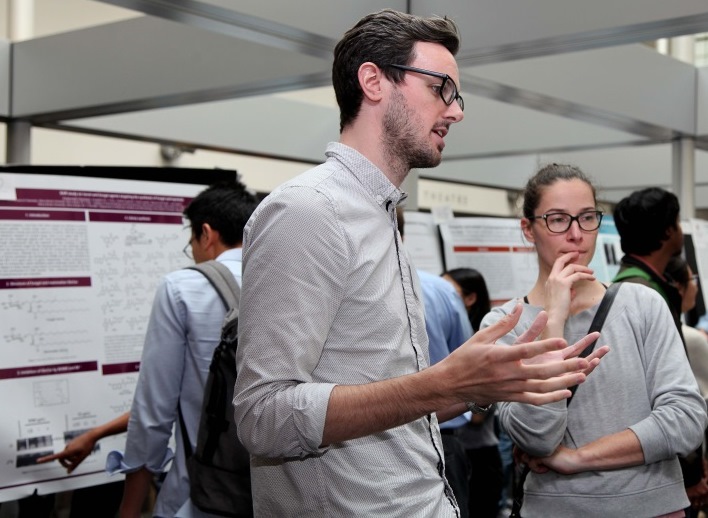
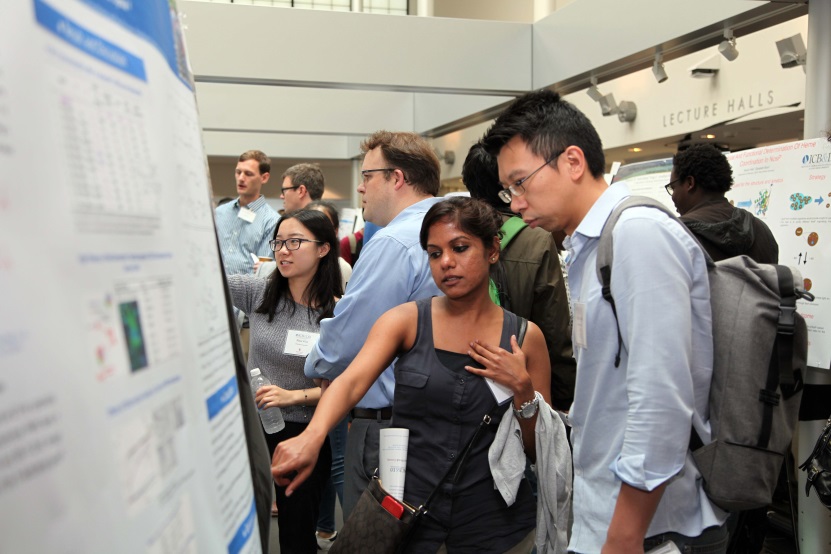


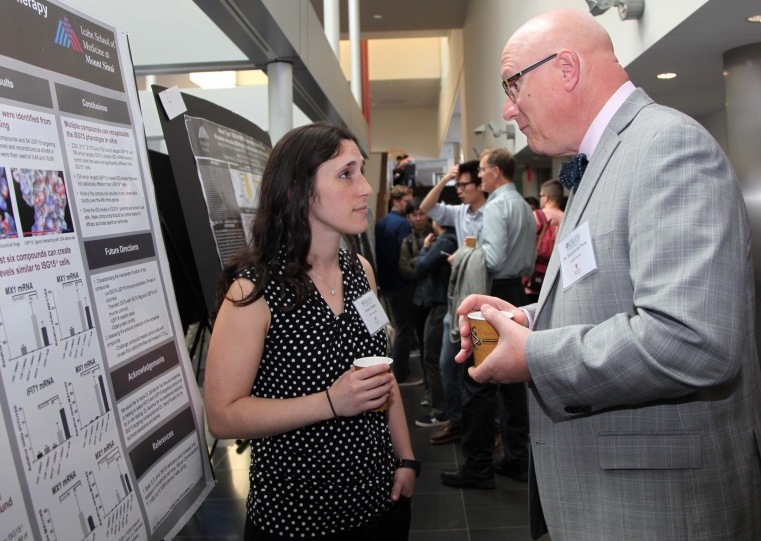
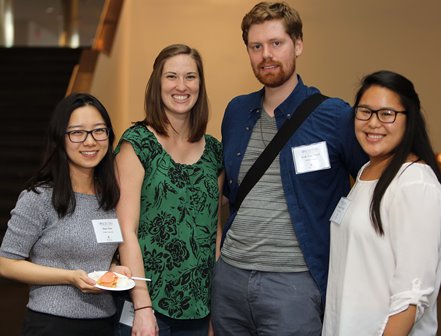
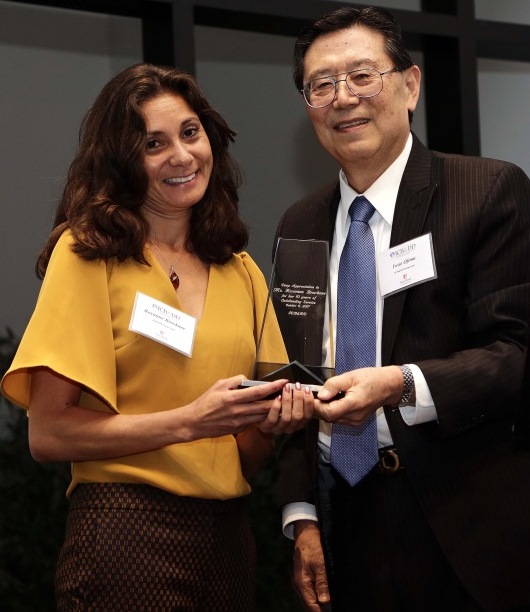 The 11th ICB&DD Symposium culminated with a wonderful dinner at the Chapel of the Charles B.
Wang Center. The invitees expressed their appreciation for the outstanding lectures
presented at the symposium as well as acknowledged the significance of the ICB&DD
and the collaborative efforts among academia and industry. They also commended Dr.
Ojima for his successful leadership for the ICB&DD operation and holding decade-long
cutting-edge Symposiums. Dr. Ojima extended special thanks to Ms. Roxanne Brockner, Assistant to the Director for her exceptional and dedicated efforts for the success
of ICB&DD and its Symposiums since its inception in 2007, and presented her a glass
plaque of deep appreciation.
The 11th ICB&DD Symposium culminated with a wonderful dinner at the Chapel of the Charles B.
Wang Center. The invitees expressed their appreciation for the outstanding lectures
presented at the symposium as well as acknowledged the significance of the ICB&DD
and the collaborative efforts among academia and industry. They also commended Dr.
Ojima for his successful leadership for the ICB&DD operation and holding decade-long
cutting-edge Symposiums. Dr. Ojima extended special thanks to Ms. Roxanne Brockner, Assistant to the Director for her exceptional and dedicated efforts for the success
of ICB&DD and its Symposiums since its inception in 2007, and presented her a glass
plaque of deep appreciation.
The Symposium was co-sponsored by Icahn School of Medicine at Mount Sinai, Stony Brook School of Medicine, Office of the Vice-President for Research, Department of Chemistry, Targagenix Inc, Chembio Diagnostics Systems Inc., Hoffmann & Baron LLP and Avanti Biosciences Inc.
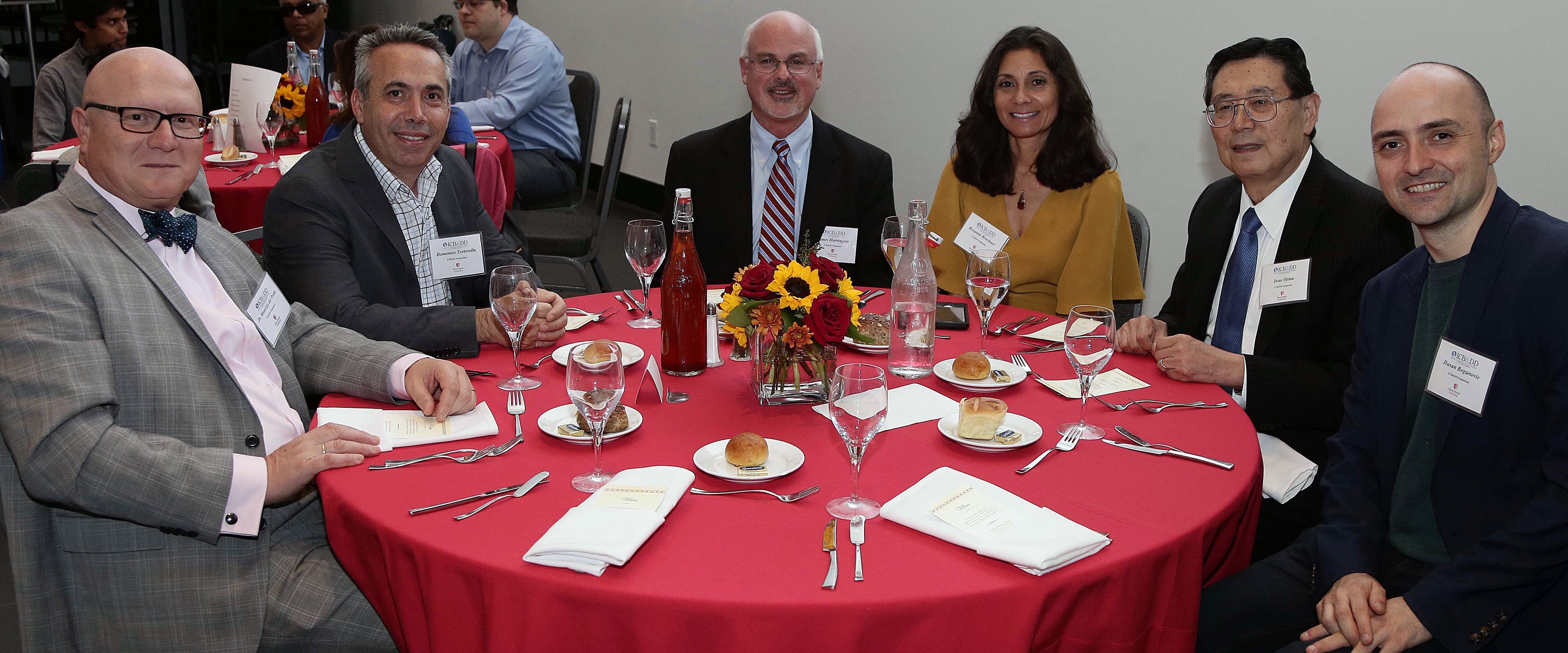
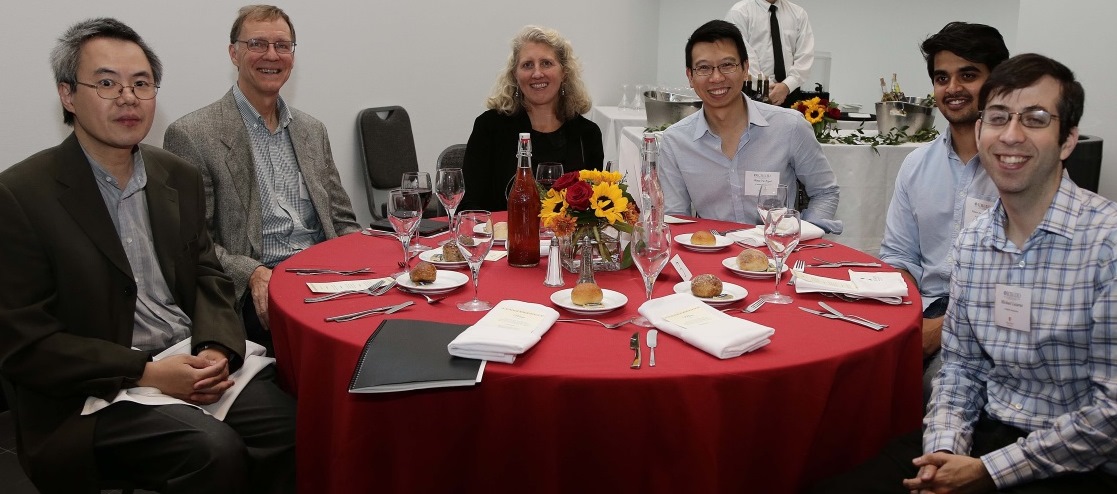
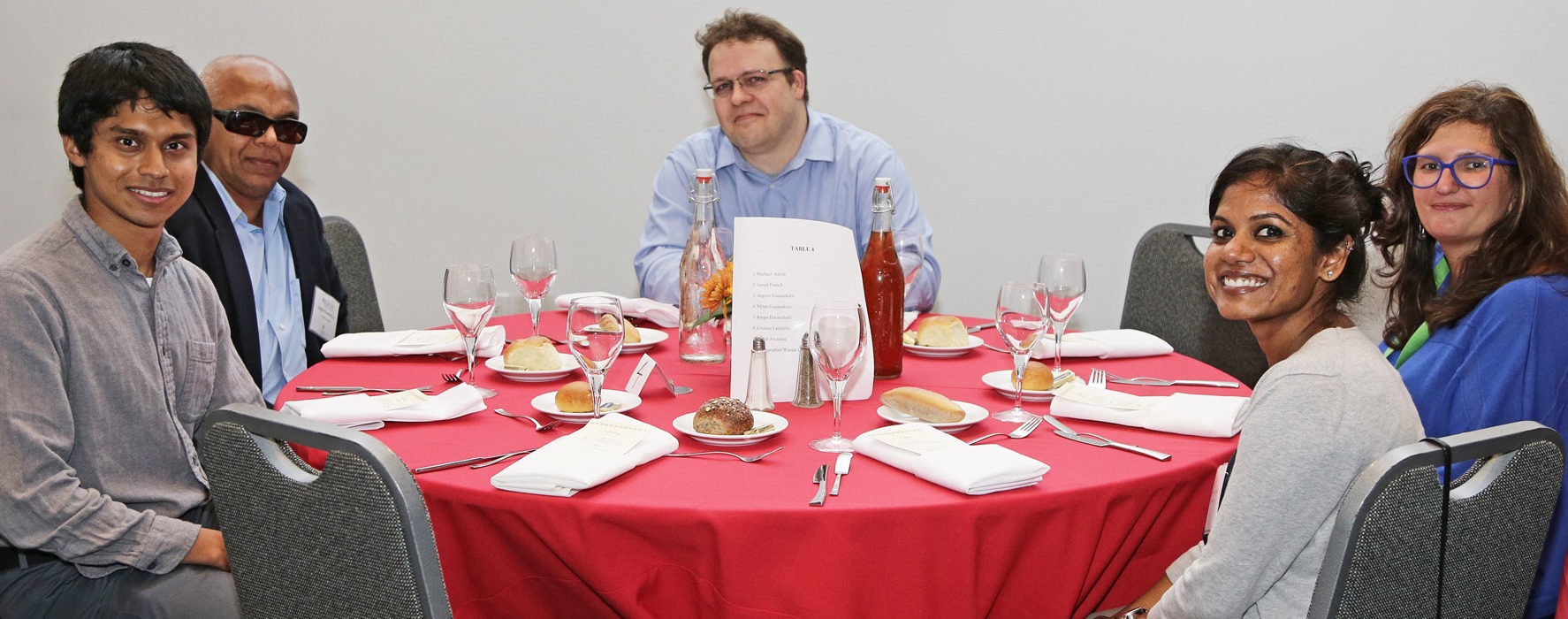

ICB&DD Tenth Annual Symposium (2016)
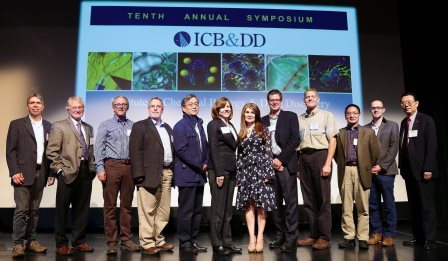
(from left to right) Drs. Robert Rizzo, Ken Dill, James Wells, Charles Brooks III, Da-Neng Wang, Wendy Cornell, Leemor Joshua-Tor, Clint Potter, Grant Jensen, Huilin Li, Steven Glynn and Iwao Ojima)
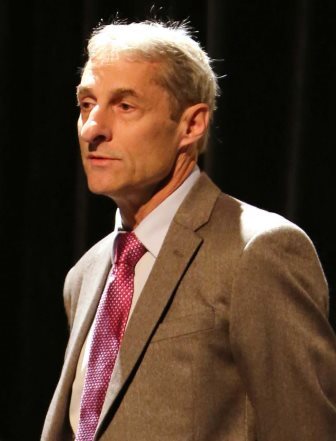 On Thursday, October 6, 2016, the ICB&DD hosted its Tenth Annual Symposium entitled,
“Frontiers in Structural and Computational Biology” at the Charles B. Wang Center,
Stony Brook University.
On Thursday, October 6, 2016, the ICB&DD hosted its Tenth Annual Symposium entitled,
“Frontiers in Structural and Computational Biology” at the Charles B. Wang Center,
Stony Brook University. 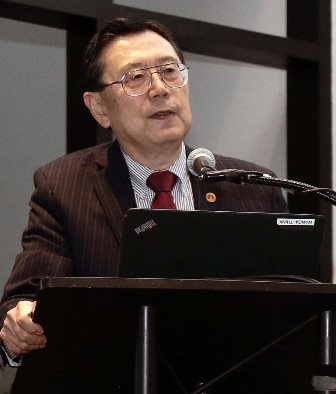 The Symposium featured eight Plenary Lecturers. Lecturer, Dr. Ken A. Dill, represented
the Laufer Center for Physical and Quantitative Biology of Stony Brook University.
The event was very well attended by a diversified audience composed of faculty, research
staff and students on campus, as well as universities and industries in the Greater
New York metropolitan area. The Poster Session equally attracted a large participation
of students from Stony Brook University, the Laufer Center for Physical and Quantitative
Biology, Mt. Sinai School of Medicine, Chembio Diagnostics Systems Inc., among others.
There were 65 scientific posters presented at the Poster Session. Dr. Huilin Li, Professor
at the Van Andel Research Institute, former Professor of Biochemistry and Cell Biology,
Stony Brook University and Chair of the Symposium Organizing Committee, opened the
Symposium and introduced Dr. Richard Reeder, Vice President for Research at Stony
Brook University, who gave the welcoming remarks for the Symposium. Then Dr. Lee
introduced Dr. Iwao Ojima, Distinguished Professor and Director of ICB&DD. Dr. Ojima
concisely summarized the history of accomplishments and the current and future goals
of ICB&DD.
The Symposium featured eight Plenary Lecturers. Lecturer, Dr. Ken A. Dill, represented
the Laufer Center for Physical and Quantitative Biology of Stony Brook University.
The event was very well attended by a diversified audience composed of faculty, research
staff and students on campus, as well as universities and industries in the Greater
New York metropolitan area. The Poster Session equally attracted a large participation
of students from Stony Brook University, the Laufer Center for Physical and Quantitative
Biology, Mt. Sinai School of Medicine, Chembio Diagnostics Systems Inc., among others.
There were 65 scientific posters presented at the Poster Session. Dr. Huilin Li, Professor
at the Van Andel Research Institute, former Professor of Biochemistry and Cell Biology,
Stony Brook University and Chair of the Symposium Organizing Committee, opened the
Symposium and introduced Dr. Richard Reeder, Vice President for Research at Stony
Brook University, who gave the welcoming remarks for the Symposium. Then Dr. Lee
introduced Dr. Iwao Ojima, Distinguished Professor and Director of ICB&DD. Dr. Ojima
concisely summarized the history of accomplishments and the current and future goals
of ICB&DD.
Ojima concisely summarized the history of accomplishments and the current and future goals of ICB&DD.
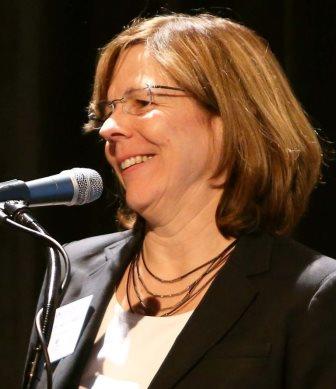 Dr. Robert Rizzo, Professor, Department of Applied Mathematics and Statistics, introduced
the first Plenary Lecturer, Dr. Wendy Cornell, Principal Research Staff Member, Soft Matter Science, IBM T. J. Watson Research
Center, who gave a lecture entitled, “Data Mining and Integration for Drug Discovery
Pipeline Decision Support”. In her presentation, Dr. Cornell provided an overview
of her research which focuses on the drug discovery process involving numerous stage
gates where targets, compounds, clinical trials, and other key options are prioritized
and Go/NoGo decisions are made. She described the generation and application of a
variety of different decision support models and workflows based on protein structural,
protein sequence, and pharmacological data as well as structured and unstructured
textual sources and the resulting impact.
Dr. Robert Rizzo, Professor, Department of Applied Mathematics and Statistics, introduced
the first Plenary Lecturer, Dr. Wendy Cornell, Principal Research Staff Member, Soft Matter Science, IBM T. J. Watson Research
Center, who gave a lecture entitled, “Data Mining and Integration for Drug Discovery
Pipeline Decision Support”. In her presentation, Dr. Cornell provided an overview
of her research which focuses on the drug discovery process involving numerous stage
gates where targets, compounds, clinical trials, and other key options are prioritized
and Go/NoGo decisions are made. She described the generation and application of a
variety of different decision support models and workflows based on protein structural,
protein sequence, and pharmacological data as well as structured and unstructured
textual sources and the resulting impact.
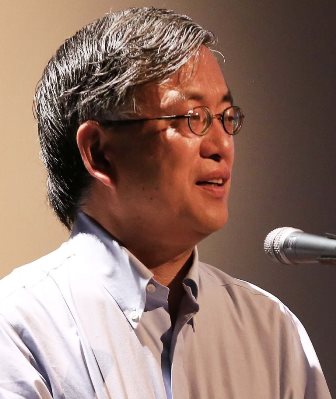 Dr. Peter Tonge, Professor, Department of Chemistry, introduced the second Plenary
Lecturer, Dr. Da-Neng Wang, Professor, Skirball Institute of Biomolecular Medicine, NYU Medical School, who
gave a lecture entitled, “Structure and Mechanism of a Bacterial Sodium-Dependent
Dicarboxylate Transporter- Implications in Fatty Acid Synthesis and Obesity”. In his
presentation, Dr. Wang discussed the factors, such as its direct import across the
plasma membrane via the Na+- dependent citrate transporter (NaCT) which influence the concentration of cytosolic
citrate, a major precursor for the synthesis of fatty acids, triacylglycerols, cholesterol
and low density lipoprotein in liver and adipose cells. He stated that mutations of
the homologous transporter gene in flies (INDY) result in reduced fat storage through
calorie restriction. His research team has determined the 3.2 Å crystal structure
an INDY homolog from Vibrio cholera. In conclusion, he indicated that homology modeling of the human NaCT protein has
been used to understand its interaction with various small molecules.
Dr. Peter Tonge, Professor, Department of Chemistry, introduced the second Plenary
Lecturer, Dr. Da-Neng Wang, Professor, Skirball Institute of Biomolecular Medicine, NYU Medical School, who
gave a lecture entitled, “Structure and Mechanism of a Bacterial Sodium-Dependent
Dicarboxylate Transporter- Implications in Fatty Acid Synthesis and Obesity”. In his
presentation, Dr. Wang discussed the factors, such as its direct import across the
plasma membrane via the Na+- dependent citrate transporter (NaCT) which influence the concentration of cytosolic
citrate, a major precursor for the synthesis of fatty acids, triacylglycerols, cholesterol
and low density lipoprotein in liver and adipose cells. He stated that mutations of
the homologous transporter gene in flies (INDY) result in reduced fat storage through
calorie restriction. His research team has determined the 3.2 Å crystal structure
an INDY homolog from Vibrio cholera. In conclusion, he indicated that homology modeling of the human NaCT protein has
been used to understand its interaction with various small molecules.
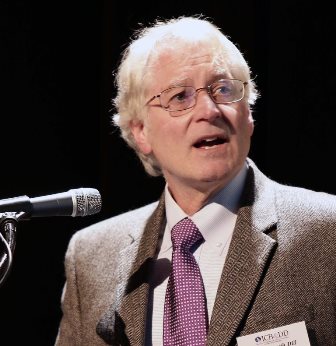 Dr. David Green, Associate Professor, Department of Applied Mathematics and Statistics,
introduced the third Plenary Lecturer, Dr. Ken A. Dill, Distinguished Professor and Director of the Laufer Center for Physical and Quantitative
Biology, Member of the National Academy of Sciences, who gave a lecture entitled,
“Melding Physical Simulations with Fuzzy Information for Computational Folding and
Binding”. In his presentation, Dr. Dill discussed the computing of the folded or
docked structures of proteins using physics-based molecular simulations. He stated
that physical simulations have the advantage of capturing energies in addition to
structural information, satisfying the Boltzmann distribution law, and giving dynamic
and mechanistic information. He described the MELD method where he and his research
team would speed up physical simulations by using fuzzy and uncertain external information
and how MELD could help in experimental structure determination and finding native
states of small proteins. He concluded by stating that he was optimistic that the
MELD accelerator would add value to molecular dynamics modeling.
Dr. David Green, Associate Professor, Department of Applied Mathematics and Statistics,
introduced the third Plenary Lecturer, Dr. Ken A. Dill, Distinguished Professor and Director of the Laufer Center for Physical and Quantitative
Biology, Member of the National Academy of Sciences, who gave a lecture entitled,
“Melding Physical Simulations with Fuzzy Information for Computational Folding and
Binding”. In his presentation, Dr. Dill discussed the computing of the folded or
docked structures of proteins using physics-based molecular simulations. He stated
that physical simulations have the advantage of capturing energies in addition to
structural information, satisfying the Boltzmann distribution law, and giving dynamic
and mechanistic information. He described the MELD method where he and his research
team would speed up physical simulations by using fuzzy and uncertain external information
and how MELD could help in experimental structure determination and finding native
states of small proteins. He concluded by stating that he was optimistic that the
MELD accelerator would add value to molecular dynamics modeling.
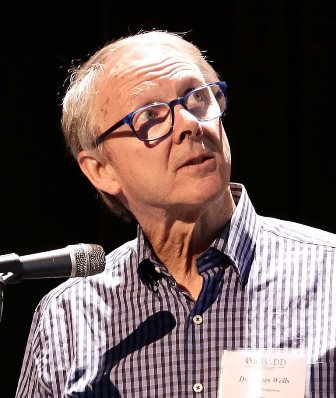 Dr. Markus Seeliger, Associate Professor, Department of Pharmacological Sciences,
introduced the fourth Plenary Lecturer, Dr. James Wells, Chair, Department of Pharmaceutical Chemistry, University of California, San Francisco,
who gave a lecture entitled, “Challenging Targets for Drug Discovery: ‘The High Hanging
Fruit’”. In his presentation, Dr. Wells described Tethering, a fragment-based discovery
approach used to probe the surfaces of proteins that engage in protein-protein interactions
or that may be regulated by allosteric interactions. He stated that for these sites,
plasticity and conformational adaptability of proteins has begun to reveal new opportunities
for drug discovery on targets previously assumed to be undruggable. Although protein-protein
interfaces are generally flat and large, small fragment molecules can be found that
bind with much greater ligand efficiency to “hot-spots” and in crevices that protein
partners do not exploit. In addition, the site-directed nature of Tethering makes
it very useful for exploring allosteric sites that may not be found by typical screening
approaches. These technologies and the intrinsic adaptability and flexibility of proteins
dramatically expand the opportunities for drug discovery at protein-protein interfaces
and allosteric sites.
Dr. Markus Seeliger, Associate Professor, Department of Pharmacological Sciences,
introduced the fourth Plenary Lecturer, Dr. James Wells, Chair, Department of Pharmaceutical Chemistry, University of California, San Francisco,
who gave a lecture entitled, “Challenging Targets for Drug Discovery: ‘The High Hanging
Fruit’”. In his presentation, Dr. Wells described Tethering, a fragment-based discovery
approach used to probe the surfaces of proteins that engage in protein-protein interactions
or that may be regulated by allosteric interactions. He stated that for these sites,
plasticity and conformational adaptability of proteins has begun to reveal new opportunities
for drug discovery on targets previously assumed to be undruggable. Although protein-protein
interfaces are generally flat and large, small fragment molecules can be found that
bind with much greater ligand efficiency to “hot-spots” and in crevices that protein
partners do not exploit. In addition, the site-directed nature of Tethering makes
it very useful for exploring allosteric sites that may not be found by typical screening
approaches. These technologies and the intrinsic adaptability and flexibility of proteins
dramatically expand the opportunities for drug discovery at protein-protein interfaces
and allosteric sites.
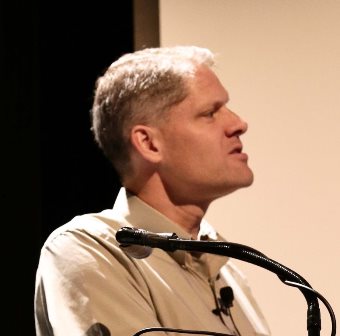 Dr. Huilin Li, Professor at the Van Andel Research Institute and former Professor
of Department of Biochemistry and Cell Biology at Stony Brook University, introduced
the fifth Plenary Lecturer, Dr. Grant Jensen, Principal Investigator, HHMI and California Institute of Technology, Department
of Biology, Broad Center for the Biological Sciences, who gave a presentation entitled,
“Structural Biology in vivo Through Electron Cryotomography”. In his presentation,
Dr. Jensen stated that in the last ten years, electron cryotomography has made it
possible to visualize large macromolecular assemblies inside intact cells in a near-native,
"frozen-hydrated" state in 3-D to a few nanometers resolution and that atomic models
of individual proteins and smaller complexes obtained by X-ray crystallography, NMR
spectroscopy, or other methods can be fit into cryotomograms to reveal how the various
pieces work together inside cells. He stressed that a few good pictures are sometimes
all that is needed to distinguish between competing models. Dr. Jensen then summarized
the key technological advances that have made electron cryotomography possible and
then presented several examples of current results from his research group’s recent
work in bacterial cell biology, including new images and mechanistic insights into
bacterial chemoreceptor arrays, secretion systems, and the Type IV pilus to illustrate
these points.
Dr. Huilin Li, Professor at the Van Andel Research Institute and former Professor
of Department of Biochemistry and Cell Biology at Stony Brook University, introduced
the fifth Plenary Lecturer, Dr. Grant Jensen, Principal Investigator, HHMI and California Institute of Technology, Department
of Biology, Broad Center for the Biological Sciences, who gave a presentation entitled,
“Structural Biology in vivo Through Electron Cryotomography”. In his presentation,
Dr. Jensen stated that in the last ten years, electron cryotomography has made it
possible to visualize large macromolecular assemblies inside intact cells in a near-native,
"frozen-hydrated" state in 3-D to a few nanometers resolution and that atomic models
of individual proteins and smaller complexes obtained by X-ray crystallography, NMR
spectroscopy, or other methods can be fit into cryotomograms to reveal how the various
pieces work together inside cells. He stressed that a few good pictures are sometimes
all that is needed to distinguish between competing models. Dr. Jensen then summarized
the key technological advances that have made electron cryotomography possible and
then presented several examples of current results from his research group’s recent
work in bacterial cell biology, including new images and mechanistic insights into
bacterial chemoreceptor arrays, secretion systems, and the Type IV pilus to illustrate
these points.
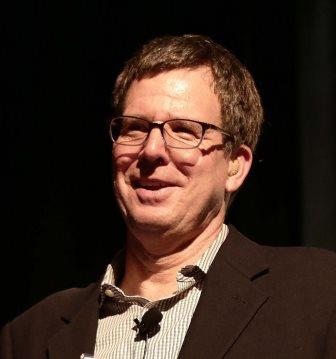 Dr. Liang Gao, Assistant Professor, Department of Chemistry, introduced the sixth
Plenary Lecturer,Dr. Clint Potter, Co-Director, Electron Microscopy, New York Structural Biology Center, who gave a
lecture entitled, “New Challenges for Molecular Electron Microscopy”. In his presentation,
Dr. Potter focused on the dramatic improvements in the progress of Molecular Electron
Microscopy (EM), and a set of techniques and approaches used to analyze the structure
of macromolecular machines using a transmission electron microscope (TEM). He stated
that new detectors and image processing software have enabled the reconstruction of
atomic resolution maps for large well-ordered macromolecules and that high levels
of automation in image acquisition and processing have enabled the reconstruction
of multiple different states of molecular machines from a single sample. Dr. Potter
then provided an overview of the new technology being used to understand structures
that may be highly heterogeneous and/or dynamic and illustrated how the power of this
method can be applied in the understanding of molecular machines.
Dr. Liang Gao, Assistant Professor, Department of Chemistry, introduced the sixth
Plenary Lecturer,Dr. Clint Potter, Co-Director, Electron Microscopy, New York Structural Biology Center, who gave a
lecture entitled, “New Challenges for Molecular Electron Microscopy”. In his presentation,
Dr. Potter focused on the dramatic improvements in the progress of Molecular Electron
Microscopy (EM), and a set of techniques and approaches used to analyze the structure
of macromolecular machines using a transmission electron microscope (TEM). He stated
that new detectors and image processing software have enabled the reconstruction of
atomic resolution maps for large well-ordered macromolecules and that high levels
of automation in image acquisition and processing have enabled the reconstruction
of multiple different states of molecular machines from a single sample. Dr. Potter
then provided an overview of the new technology being used to understand structures
that may be highly heterogeneous and/or dynamic and illustrated how the power of this
method can be applied in the understanding of molecular machines.
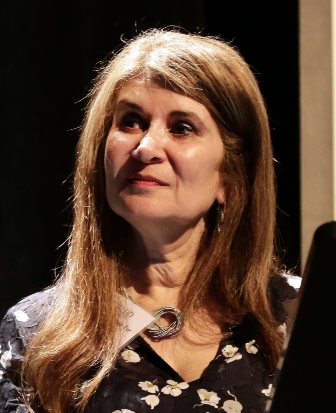 Dr. Miguel Garcia-Diaz, Associate Professor, Department of Pharmacological Sciences,
introduced the seventh Plenary Lecturer, Dr. Leemor Joshua-Tor, Professor and Dean of Watson School of Biological Sciences, HHMI Investigator, Cold
Spring Harbor Laboratory and HHMI, who gave a presentation entitled, “Mad About U:
Regulating the Let7 Pre-miRNA”. In her presentation, Dr. Tor explored the key mechanistic
features of the steps in the regulation of the let-7 family of regulatory miRNA. She
stated that Lin28 is the pluripotency factor that inhibits the biogenesis of the let-7
family. Lin28 is highly expressed in embryonic stem cells and has a fundamental role
in development and tissue regeneration. It is an oncogene in a subset of human cancers,
while let-7 is a tumor suppressor, that silences several human oncogenes. She described
the process by which Lin28 triggers the suppression of mature let-7 expression in
stem cells and certain cancer cells.
Dr. Miguel Garcia-Diaz, Associate Professor, Department of Pharmacological Sciences,
introduced the seventh Plenary Lecturer, Dr. Leemor Joshua-Tor, Professor and Dean of Watson School of Biological Sciences, HHMI Investigator, Cold
Spring Harbor Laboratory and HHMI, who gave a presentation entitled, “Mad About U:
Regulating the Let7 Pre-miRNA”. In her presentation, Dr. Tor explored the key mechanistic
features of the steps in the regulation of the let-7 family of regulatory miRNA. She
stated that Lin28 is the pluripotency factor that inhibits the biogenesis of the let-7
family. Lin28 is highly expressed in embryonic stem cells and has a fundamental role
in development and tissue regeneration. It is an oncogene in a subset of human cancers,
while let-7 is a tumor suppressor, that silences several human oncogenes. She described
the process by which Lin28 triggers the suppression of mature let-7 expression in
stem cells and certain cancer cells.
 Dr. Carlos Simmerling, Professor, Department of Chemistry, introduced the eighth Plenary
Lecturer, Dr. Charles L. Brooks III, Warner-Lambert/Parke-Davis Professor of Chemistry and Biophysics, Department of
Chemistry and Biophysics, University of Michigan, who gave a presentation entitled,
“High-Throughput, Free Energy Based Ligand Discovery and Optimization Using Multi-Site
λ-Dynamics”. In his presentation, Dr. Brooks discussed his research group’s development
of an extended Lagrangian approach to free energy simulations called λ-dynamics and
a multi-site version, which he termed multi-site λ-dynamics. He stressed that this
system of interest “’evolves’ dynamically in the space of chemical substituents of
interest and thus significantly enhances the efficiency of the search problem and
convergence of the overall free energy calculations”. Dr. Books then described the
extended Lagrangian methodology and illustrated it in the context of large- scale
ligand screening calculations and then concluded his presentation by discussing generalizations
to permit both sequence-based resistant mutations and ligand affinities.
Dr. Carlos Simmerling, Professor, Department of Chemistry, introduced the eighth Plenary
Lecturer, Dr. Charles L. Brooks III, Warner-Lambert/Parke-Davis Professor of Chemistry and Biophysics, Department of
Chemistry and Biophysics, University of Michigan, who gave a presentation entitled,
“High-Throughput, Free Energy Based Ligand Discovery and Optimization Using Multi-Site
λ-Dynamics”. In his presentation, Dr. Brooks discussed his research group’s development
of an extended Lagrangian approach to free energy simulations called λ-dynamics and
a multi-site version, which he termed multi-site λ-dynamics. He stressed that this
system of interest “’evolves’ dynamically in the space of chemical substituents of
interest and thus significantly enhances the efficiency of the search problem and
convergence of the overall free energy calculations”. Dr. Books then described the
extended Lagrangian methodology and illustrated it in the context of large- scale
ligand screening calculations and then concluded his presentation by discussing generalizations
to permit both sequence-based resistant mutations and ligand affinities.
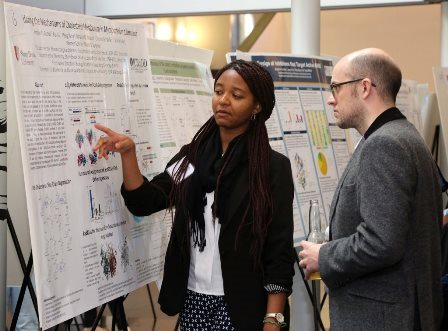
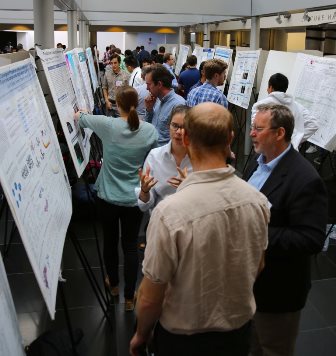
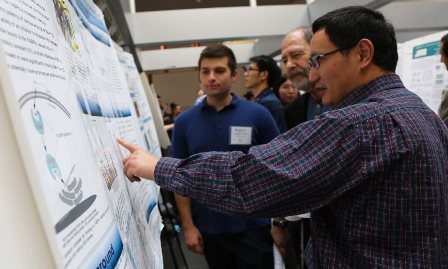
Dr. Robert Rizzo gave the closing remarks, thanking the Plenary Lecturers for their outstanding presentations as well as the Organizing Committee members for their successful planning and execution of the Tenth Annual ICB&DD Symposium.
 The best three of the 65 posters presented in the Poster Session were selected for
the Poster Awards. The award winning posters this year were presented by Amber Bondsfrom the research group of Dr. Nicole Sampson for her poster entitled, “Elucidating
the Mechanisms of Cholesterol Metabolism in Mycobacterium Tuberculosis”; T. Dwight McGee Jr. from the research group of Dr. Robert Rizzo for his poster entitled, “Exploiting
Targetable Events in HIV Entry with Small-Molecule Inhibitors” and Xin Wang from the research group of Dr. Iwao Ojima for her poster entitled, “SB-T-1214 and
Biotin Functionalized Gold Nanoparticles”.
The best three of the 65 posters presented in the Poster Session were selected for
the Poster Awards. The award winning posters this year were presented by Amber Bondsfrom the research group of Dr. Nicole Sampson for her poster entitled, “Elucidating
the Mechanisms of Cholesterol Metabolism in Mycobacterium Tuberculosis”; T. Dwight McGee Jr. from the research group of Dr. Robert Rizzo for his poster entitled, “Exploiting
Targetable Events in HIV Entry with Small-Molecule Inhibitors” and Xin Wang from the research group of Dr. Iwao Ojima for her poster entitled, “SB-T-1214 and
Biotin Functionalized Gold Nanoparticles”.
The 10th ICB&DD Symposium culminated with a wonderful dinner at the Chapel of the Charles B. Wang Center. Among the attendees were Kenneth Shroyer, Chair of the Department of Pathology and Maria Ryan, Chair of the Department of Oral Biology and Pathology. They expressed their appreciation for the outstanding lectures presented at the symposium as well as acknowledged the significance of the ICB&DD and the collaborative efforts among academia and industry. They also commended Dr. Ojima for his successful leadership for the ICB&DD operation and holding decade-long cutting-edge Symposiums. Dr. Ojima extended special thanks to Ms. Roxanne Brockner, Assistant to the Director for her exceptional and dedicated efforts for the success of ICB&DD and its Symposiums.
The Symposium was co-sponsored by the Office of the Vice-President for Research, Stony Brook School of Medicine, Department of Chemistry, TargaGenix Inc., Chembio Diagnostics Systems Inc., Chem-Master International, Inc. and Hoffmann and Baron LLP.
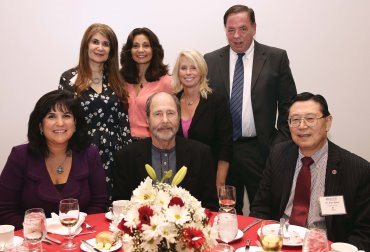
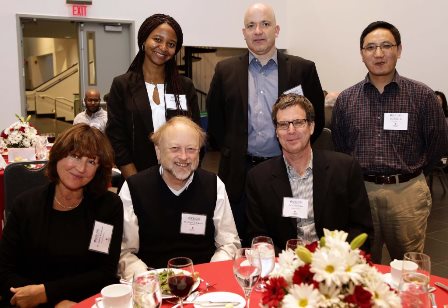
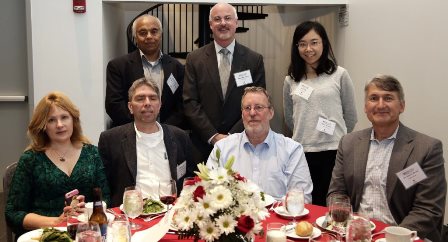
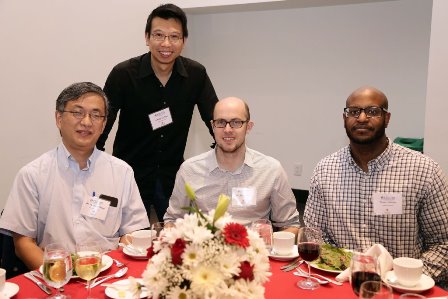
ICB&DD Ninth Annual Symposium (2015)
 On Thursday, October 8, 2015, ICB&DD hosted its Ninth Annual Symposium entitled, “Molecular
Targets, Chemoprevention, and Cancer Therapeutics” at the Charles B. Wang Center,
Stony Brook University. The Symposium featured seven Plenary Lecturers. The event
was well attended by a diversified audience composed of faculty, research staff and
students on campus and Brookhaven National Laboratory, as well as universities and
industries in the Greater New York metropolitan area. The Poster Session equally attracted
a large participation of students from Stony Brook University, Stony Brook Cancer
Center and Brookhaven National Laboratory among others.
On Thursday, October 8, 2015, ICB&DD hosted its Ninth Annual Symposium entitled, “Molecular
Targets, Chemoprevention, and Cancer Therapeutics” at the Charles B. Wang Center,
Stony Brook University. The Symposium featured seven Plenary Lecturers. The event
was well attended by a diversified audience composed of faculty, research staff and
students on campus and Brookhaven National Laboratory, as well as universities and
industries in the Greater New York metropolitan area. The Poster Session equally attracted
a large participation of students from Stony Brook University, Stony Brook Cancer
Center and Brookhaven National Laboratory among others. 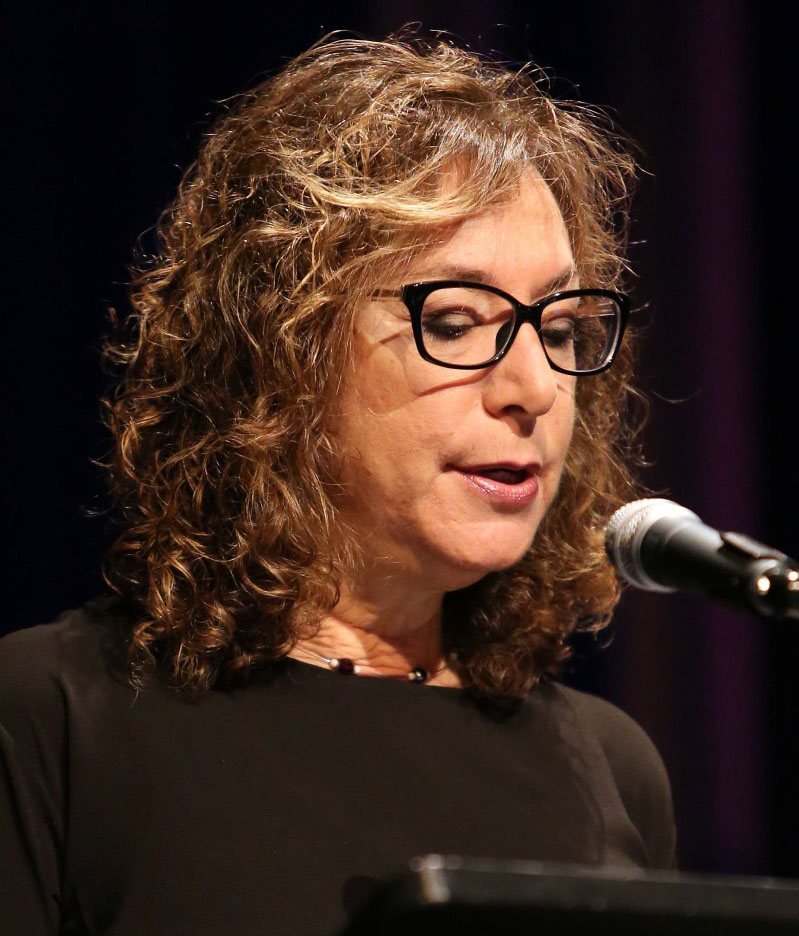 There were 59 scientific papers presented at the Poster Session. Dr. Kenneth Shroyer
(Chair, Department of Pathology, Stony Brook School of Medicine), Chair of the Symposium
Organizing Committee, opened the Symposium, and introduced Dr. Lina Obeid, Professor
of Medicine and Vice-Dean for Scientific Affairs of Stony Brook School of Medicine,
who gave the welcoming remarks for the Symposium. Then, Dr. Shroyer introduced Dr.
Iwao Ojima, Distinguished Professor and Director of ICB&DD. Dr. Ojima concisely summarized
the history of accomplishments and the current and future goals of ICB&DD.
There were 59 scientific papers presented at the Poster Session. Dr. Kenneth Shroyer
(Chair, Department of Pathology, Stony Brook School of Medicine), Chair of the Symposium
Organizing Committee, opened the Symposium, and introduced Dr. Lina Obeid, Professor
of Medicine and Vice-Dean for Scientific Affairs of Stony Brook School of Medicine,
who gave the welcoming remarks for the Symposium. Then, Dr. Shroyer introduced Dr.
Iwao Ojima, Distinguished Professor and Director of ICB&DD. Dr. Ojima concisely summarized
the history of accomplishments and the current and future goals of ICB&DD.
Dr. John Haley, Associate Professor of Research, Department of Pathology, Stony Brook
School of Medicine introduced the first Plenary Lecturer, Dr. Kowk-Kin Wong, Professor at Harvard Medical School, Dana-Faber Cancer Institute. Dr. Wong gave
a lecture entitled, “Understanding Sensitivity and Resistance to Targeted Therapeutics
and Immunotherapeutics Using Mouse Models of Lung Cancer”. In his presentation, Dr.
Wong provided an overview 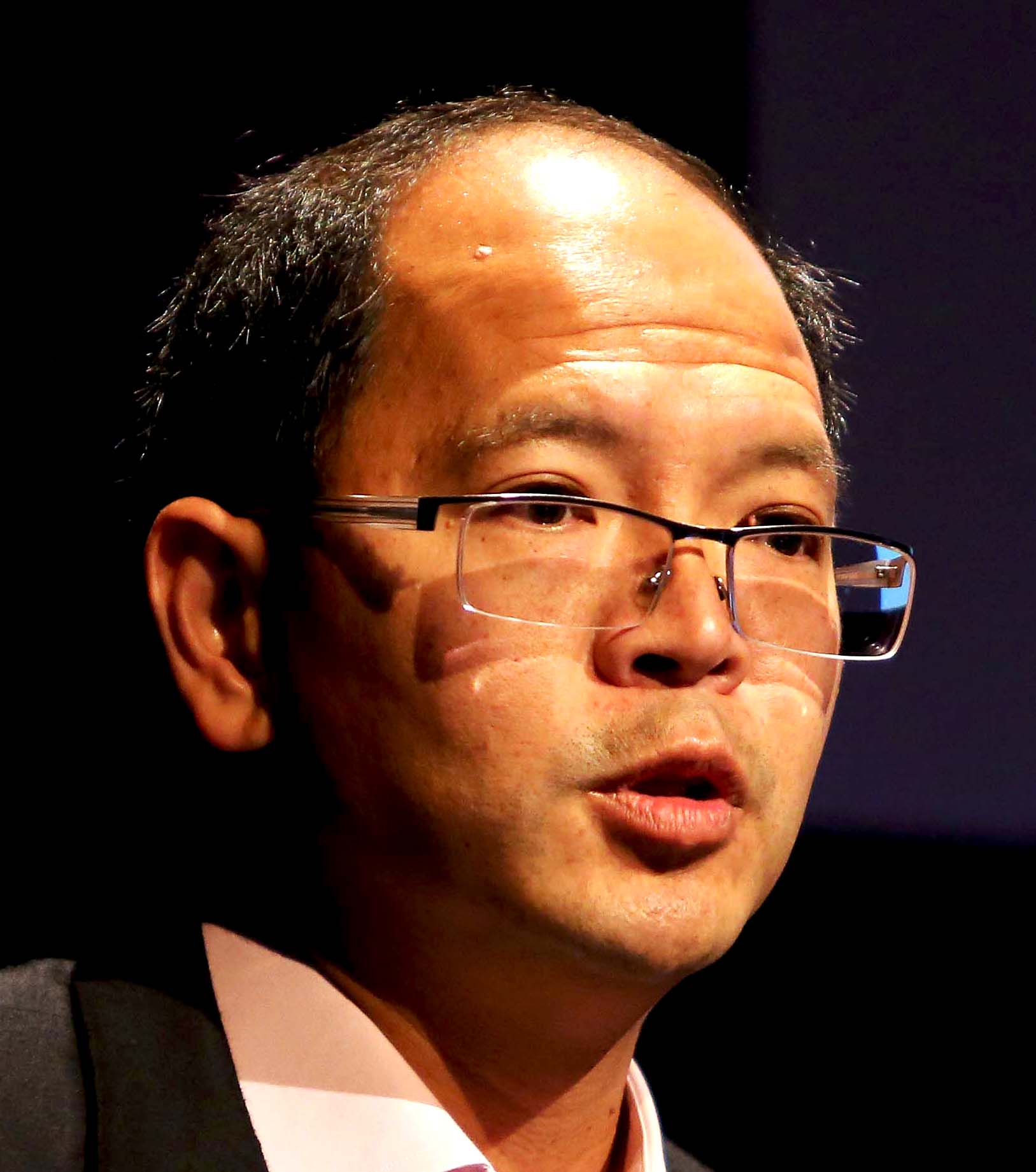 of his research which focuses on understanding the pathogenesis and genetic alterations
involved in lung tumorigenesis, as well as testing novel targeted cancer therapeutics in vivo in lung cancers. Dr. Wong proposed that the data generated from the “mouse clinical
trials” that his research laboratory performed would provide the preclinical rationale
for moving the therapeutic agents that his group used into human clinical trials.
Dr. Geoffrey Girnun, Associate Professor, Department of Pathology, Stony Brook School
of Medicine introduced the second Plenary Lecurer,
of his research which focuses on understanding the pathogenesis and genetic alterations
involved in lung tumorigenesis, as well as testing novel targeted cancer therapeutics in vivo in lung cancers. Dr. Wong proposed that the data generated from the “mouse clinical
trials” that his research laboratory performed would provide the preclinical rationale
for moving the therapeutic agents that his group used into human clinical trials.
Dr. Geoffrey Girnun, Associate Professor, Department of Pathology, Stony Brook School
of Medicine introduced the second Plenary Lecurer, 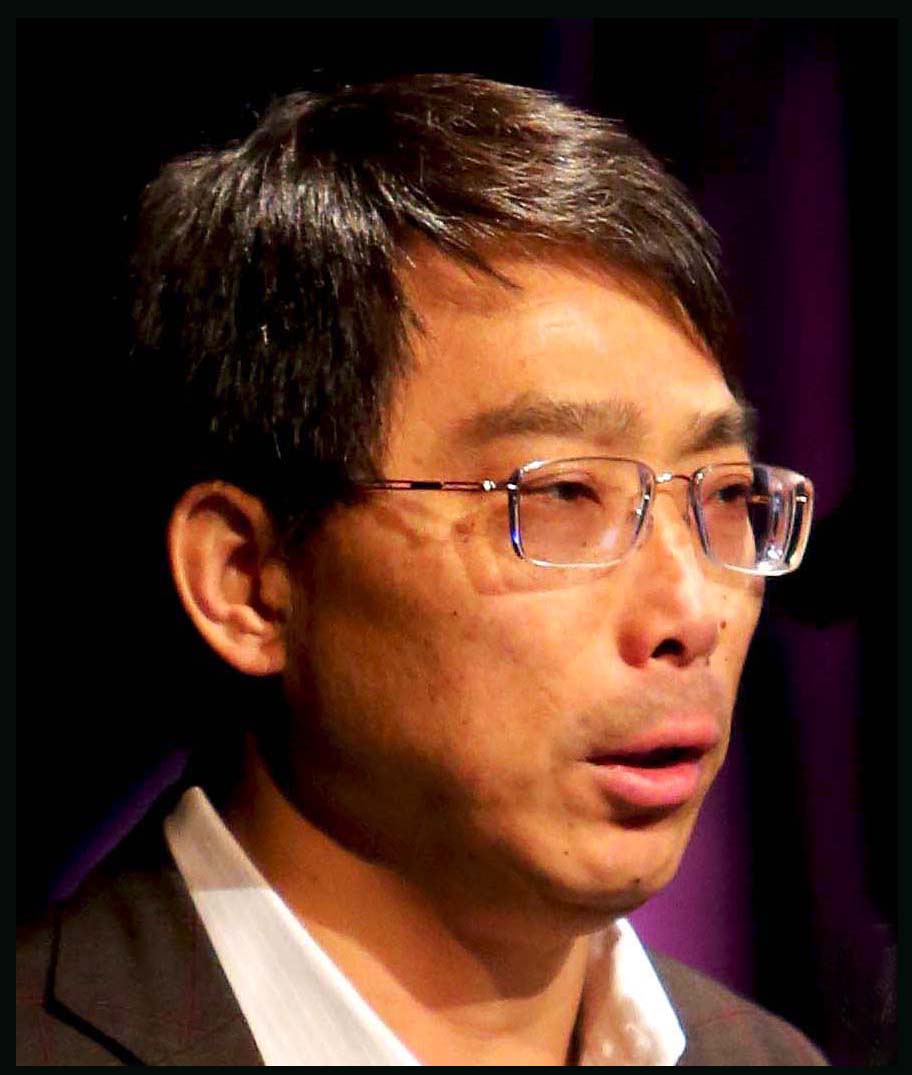 Dr. Shaomeng Wang, Professor Internal Medicine and Pharmacology, University of Michigan Medical School.
Dr. Wang gave a lecture entitled, “Building a Successful Drug Discovery Program in
Academia”. In his presentation, Dr. Wang discussed the difficulty encountered in moving
a drug discovery research project from the laboratory to its clinical development.
His lecture provided an overview of his team’s efforts and collaborations with academic
researchers and biotech and pharmaceutical partners to advance compounds into clinical
development and its research aimed at the “discovery and identification of optimal
compounds for clinical development”. Dr. Orlando Schärer, Professor of Pharmaceutical
Sciences, Stony Brook University introduced the third Plenary Lecturer,
Dr. Shaomeng Wang, Professor Internal Medicine and Pharmacology, University of Michigan Medical School.
Dr. Wang gave a lecture entitled, “Building a Successful Drug Discovery Program in
Academia”. In his presentation, Dr. Wang discussed the difficulty encountered in moving
a drug discovery research project from the laboratory to its clinical development.
His lecture provided an overview of his team’s efforts and collaborations with academic
researchers and biotech and pharmaceutical partners to advance compounds into clinical
development and its research aimed at the “discovery and identification of optimal
compounds for clinical development”. Dr. Orlando Schärer, Professor of Pharmaceutical
Sciences, Stony Brook University introduced the third Plenary Lecturer, 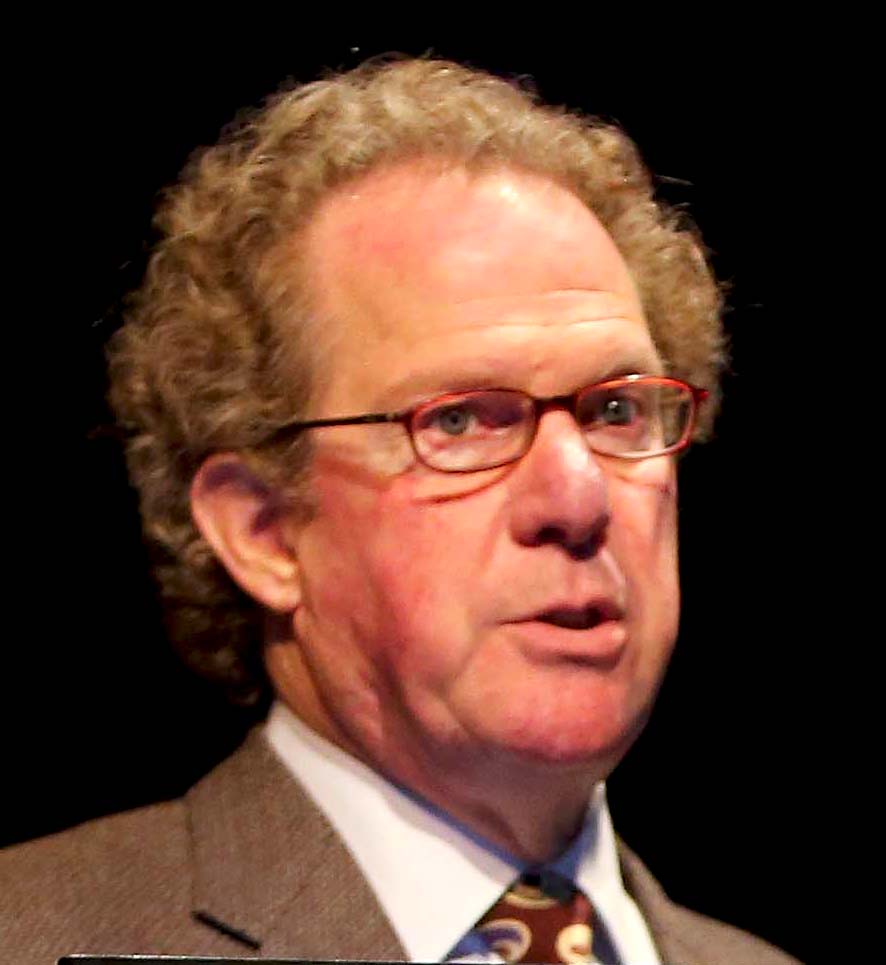 Dr. Steven E. Rokita, Professor, Department Bioorganic Chemistry and Biochemistry, Johns Hopkins University
who gave a lecture entitled, “Dynamic Alkylation and its Consequences for DNA”. In
his presentation, Dr. Rokita described prior research on the mutagenic and therapeutic
potential of DNA alkylation that focused almost exclusively on irreversible reactions
in contrast to reversibly reacting intermediates that can continually maintain a distribution
of products regulated by thermodynamics rather than kinetics. He stated that the ultimate
goal of his research group is to develop covalent, but dynamic cross-linking agents
that can run the DNA repair process sufficiently to enhance the potency of chemotherapy.
Dr. Steven E. Rokita, Professor, Department Bioorganic Chemistry and Biochemistry, Johns Hopkins University
who gave a lecture entitled, “Dynamic Alkylation and its Consequences for DNA”. In
his presentation, Dr. Rokita described prior research on the mutagenic and therapeutic
potential of DNA alkylation that focused almost exclusively on irreversible reactions
in contrast to reversibly reacting intermediates that can continually maintain a distribution
of products regulated by thermodynamics rather than kinetics. He stated that the ultimate
goal of his research group is to develop covalent, but dynamic cross-linking agents
that can run the DNA repair process sufficiently to enhance the potency of chemotherapy.
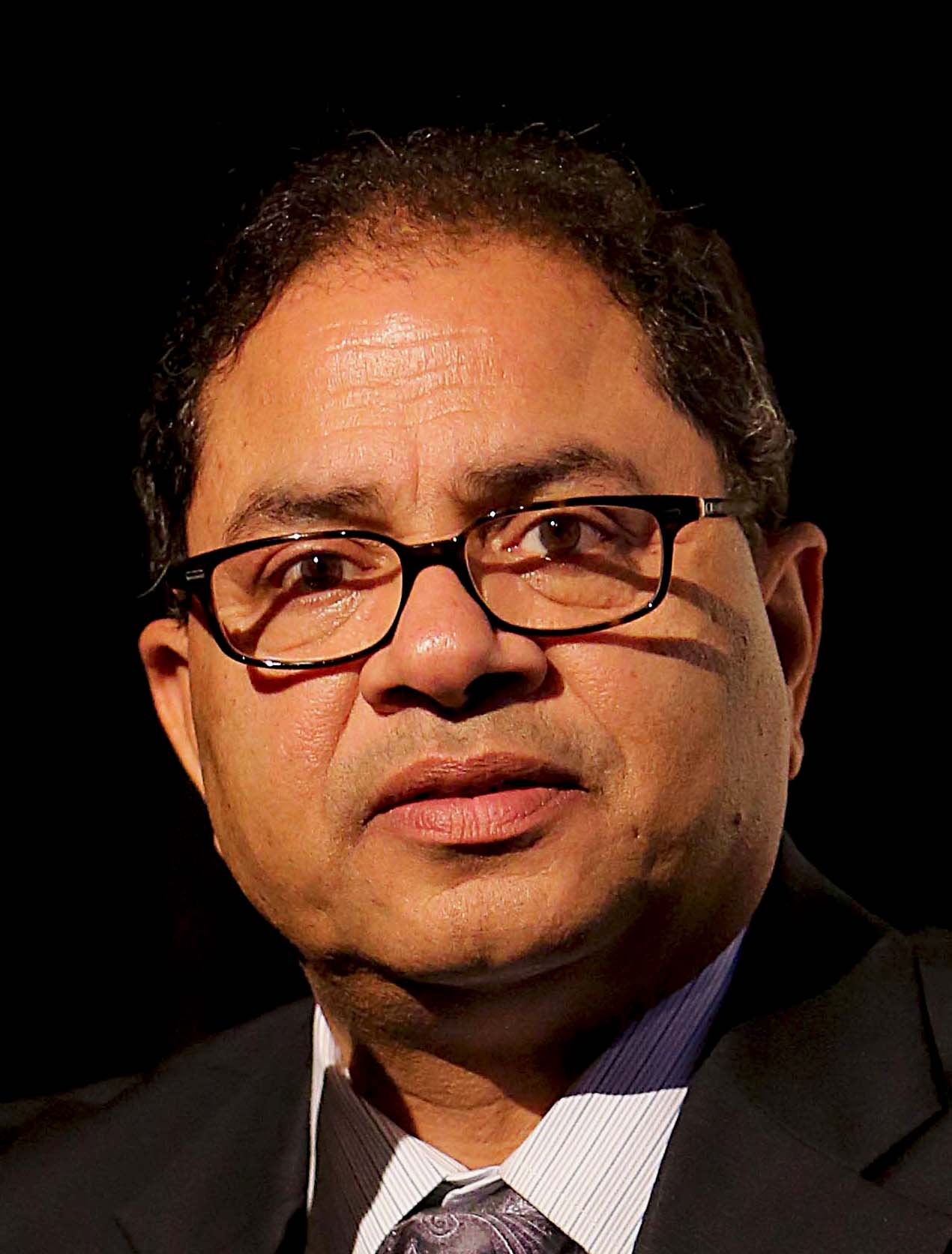 Dr. Kenneth Shroyer, introduced the fourth Plenary Lecturer, Dr. Rajesh Agarwal, Professor, Department of Pharmaceutical Sciences, University of Colorado Cancer
Center. Dr. Agarwal gave a lecture entitled, “Colon Cancer Chemoprevention in New
Era: Targeting the Initiators and the Initiated Ones, a Cancer Stem Cell Perspective”.
In his presentation, Dr. Argarwal described the studies performed by his research
group on whether sibilium, a non-toxic chemopreventive agent against Colorectal Cancer
(CRC) has the potential to target colon CRC and associated inflammatory niche. He
indicated that its studies “showed that sibilium strongly decreases the percentage
of colonosphere formation (a stem cell characteristic) of CRC. Dr.
Dr. Kenneth Shroyer, introduced the fourth Plenary Lecturer, Dr. Rajesh Agarwal, Professor, Department of Pharmaceutical Sciences, University of Colorado Cancer
Center. Dr. Agarwal gave a lecture entitled, “Colon Cancer Chemoprevention in New
Era: Targeting the Initiators and the Initiated Ones, a Cancer Stem Cell Perspective”.
In his presentation, Dr. Argarwal described the studies performed by his research
group on whether sibilium, a non-toxic chemopreventive agent against Colorectal Cancer
(CRC) has the potential to target colon CRC and associated inflammatory niche. He
indicated that its studies “showed that sibilium strongly decreases the percentage
of colonosphere formation (a stem cell characteristic) of CRC. Dr. 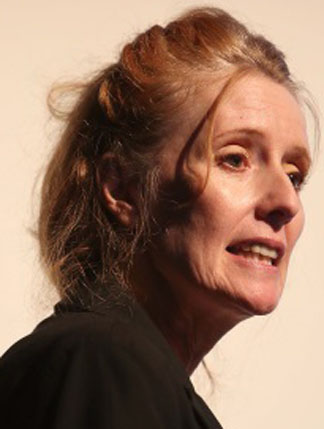 Kenneth Shroyer introduced the fifth Plenary Lecturer, Dr. Patricia Thompson Carino, Professor, Department of Pathology, Stony Brook School of Medicine. Dr. Thompson-Carino
gave a lecture entitled, “MicroRNAs, Colorectal Adenomatous Polyps and Cancer Risk”.
In her presentation, Dr. Thompson-Carino focused on the deregulation of microRNAs
in colorectal tumorigenesis across the adenoma to carcinoma continuum placing emphasis
on the functional consequences at transition states between benign polyps and polyps
that have a high risk of converting to colorectal cancer. In addition, she described
recent results demonstrating microRNA patterns that accurately distinguish adenomatous
polyps with a high propensity to convert to cancer from those with low malignant potential.
Kenneth Shroyer introduced the fifth Plenary Lecturer, Dr. Patricia Thompson Carino, Professor, Department of Pathology, Stony Brook School of Medicine. Dr. Thompson-Carino
gave a lecture entitled, “MicroRNAs, Colorectal Adenomatous Polyps and Cancer Risk”.
In her presentation, Dr. Thompson-Carino focused on the deregulation of microRNAs
in colorectal tumorigenesis across the adenoma to carcinoma continuum placing emphasis
on the functional consequences at transition states between benign polyps and polyps
that have a high risk of converting to colorectal cancer. In addition, she described
recent results demonstrating microRNA patterns that accurately distinguish adenomatous
polyps with a high propensity to convert to cancer from those with low malignant potential.
Dr. Isaac Carrico, Associate Professor, Chemistry Department, Stony Brook University 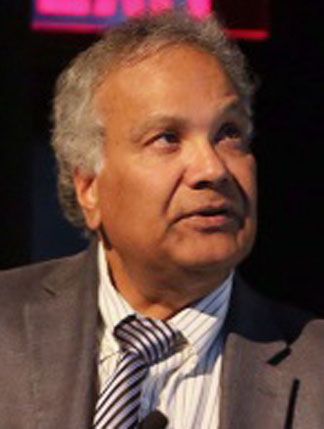 introduced the sixth Plenary Lecturer, Dr. Ravi Chari, Executive Director, Chemistry & Biochemistry, ImmunoGen, Inc. Dr. Chari gave a presentation
entitled, “Antibody-Drug Conjugates: From Concept to Clinical Validation”. In his
presentation, Dr. Chari described his group’s research that is devoted to a semisynthetic
approach to develop a panel of “linkable” analogs of matansine, a potent tubulin interacting
plant natural product as well as potent DNA alkylators (IGNs) for use in Antibody-Drug
Conjugates (ADCs). He indicated that multiple ADCs using maytansinoids are currently
in clinical evaluation and that the clinical data that is emerging from this study
is promising. Dr. Chari stated that, the recent approval by the FDA of the maytansinoid
conjugate ado-trastuzumab emtansine (T-DMI) for the treatment of metastatic breast
cancer validates the potential of this technology”. Dr. John Haley introduced the
seventh Plenary Lecturer, Dr. Geoffrey
introduced the sixth Plenary Lecturer, Dr. Ravi Chari, Executive Director, Chemistry & Biochemistry, ImmunoGen, Inc. Dr. Chari gave a presentation
entitled, “Antibody-Drug Conjugates: From Concept to Clinical Validation”. In his
presentation, Dr. Chari described his group’s research that is devoted to a semisynthetic
approach to develop a panel of “linkable” analogs of matansine, a potent tubulin interacting
plant natural product as well as potent DNA alkylators (IGNs) for use in Antibody-Drug
Conjugates (ADCs). He indicated that multiple ADCs using maytansinoids are currently
in clinical evaluation and that the clinical data that is emerging from this study
is promising. Dr. Chari stated that, the recent approval by the FDA of the maytansinoid
conjugate ado-trastuzumab emtansine (T-DMI) for the treatment of metastatic breast
cancer validates the potential of this technology”. Dr. John Haley introduced the
seventh Plenary Lecturer, Dr. Geoffrey  Girnun. Dr. Girnun gave a presentation entitled, “Targeting Oncogenic Signaling in Cancer
via Regulation of Metabolic Flux”. In his presentation, Dr. Girnun discussed the emerging
studies that highlight the role of the TCA cycle in the regulation of cancer cell
proliferation and previous studies of the role of Phosphoenolpyruvate carboxykinase
(PEPCK) in glucogenesis and as a key regulator of TCA cycle flux. He described that
his research team discovered that PEPCK has a role in promoting cancer cell proliferation in vitro and in vivo and also one in linking metabolic flux and anabolic pathways to cancer cell growth.
Dr. Girnun concluded his lecture by stating that his research group is currently working
on the study of inhibitors of PEPCK as therapeutic agents of cancer.
Girnun. Dr. Girnun gave a presentation entitled, “Targeting Oncogenic Signaling in Cancer
via Regulation of Metabolic Flux”. In his presentation, Dr. Girnun discussed the emerging
studies that highlight the role of the TCA cycle in the regulation of cancer cell
proliferation and previous studies of the role of Phosphoenolpyruvate carboxykinase
(PEPCK) in glucogenesis and as a key regulator of TCA cycle flux. He described that
his research team discovered that PEPCK has a role in promoting cancer cell proliferation in vitro and in vivo and also one in linking metabolic flux and anabolic pathways to cancer cell growth.
Dr. Girnun concluded his lecture by stating that his research group is currently working
on the study of inhibitors of PEPCK as therapeutic agents of cancer.
Dr. Shroyer gave the closing remarks, thanking the Plenary Lecturers for their outstanding presentations as well as the Organizing Committee members for its successful planning and execution of the Ninth Annual ICB&DD Symposium.
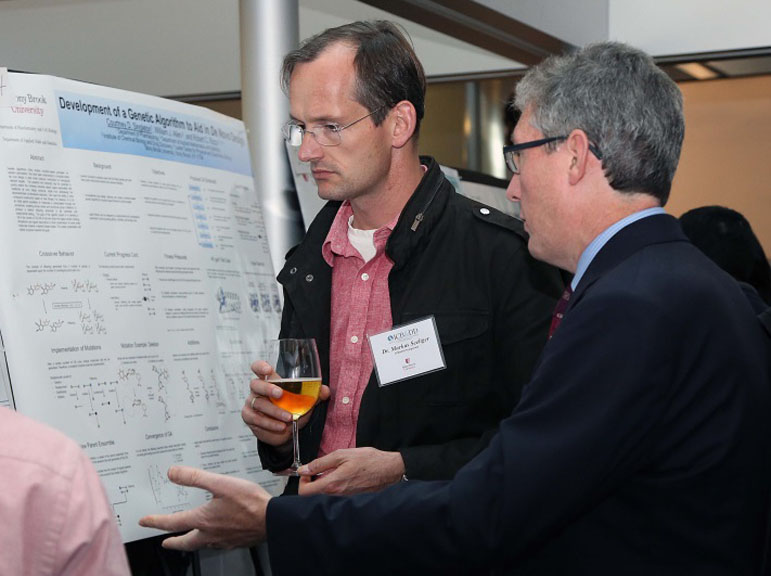

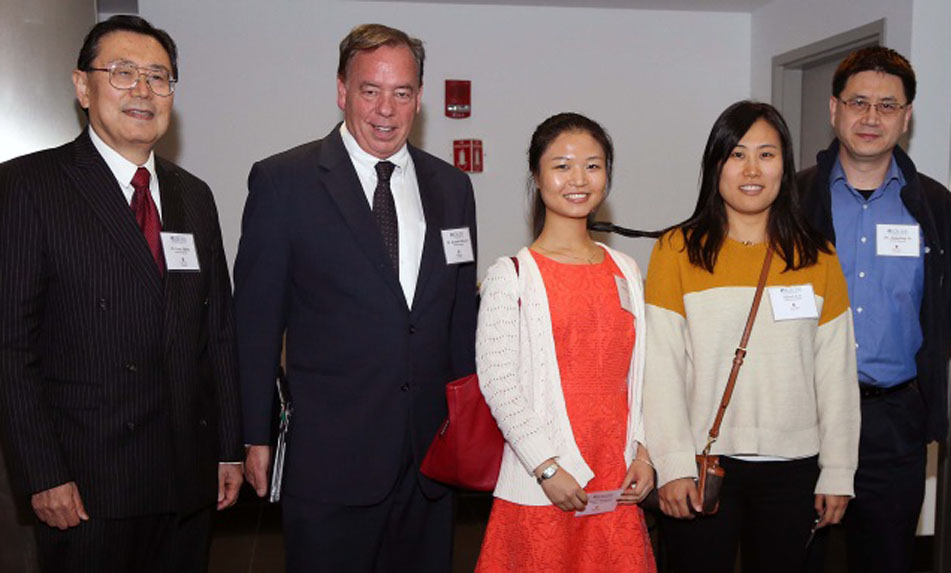
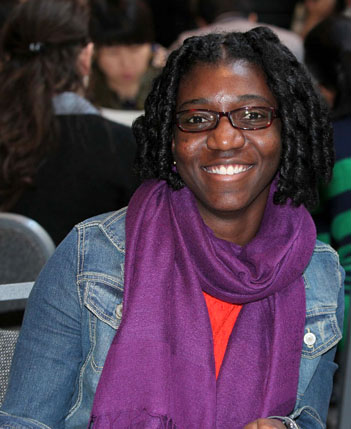
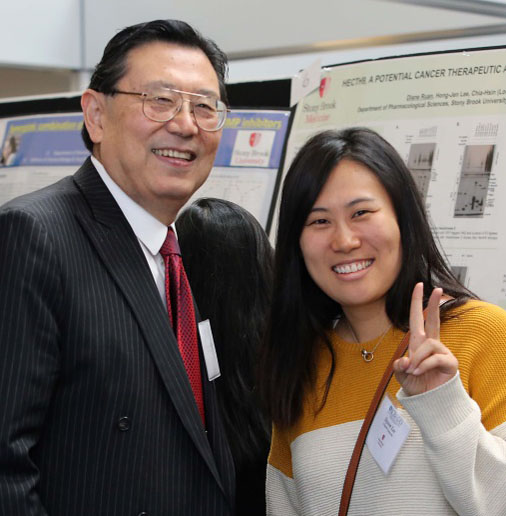
The best three posters of the 66 scientific papers presented in the Poster Session were selected for the Poster Awards. The award winning posters this year were Siyeon Lee from the laboratory of Dr. Iwao Ojima for her poster entitled, “Boc-Lys (AC)-GABA-taxoids as Novel Tumor Targeted Anticancer Agents”, Jingming Wang from the laboratory of Dr. Hyungjin Kim for her poster entitled, “Regulation of DNA Repair by the SCF Ubiquitin E3 Ligase Complex” and Lisa-Marie Nisbett from the laboratory of Dr. Elizabeth Boon for her poster entitled, “Characterization of a NosP Signal Transduction Pathway in Shewanellaoneidensis”.
The 9th ICB&DD Symposium culminated with a wonderful dinner at the Chapel of the Charles B. Wang Center. Among the attendees were, Lina Obeid, Yusuf Hannun, Peter Tonge and John Haley. They expressed their appreciation for the outstanding lectures presented at the symposium and acknowledged the significance of the ICB&DD and the collaborative efforts among academia and industry. They also commended Dr. Ojima for his leadership of the ICB&DD and congratulated his 70th birthday. The Symposium was co-sponsored by the Office of the Vice-President for Research, Stony Brook School of Medicine, Department of Chemistry, Department of Pathology, Chembio Diagnostics Systems Inc., TargaGenix Inc.,
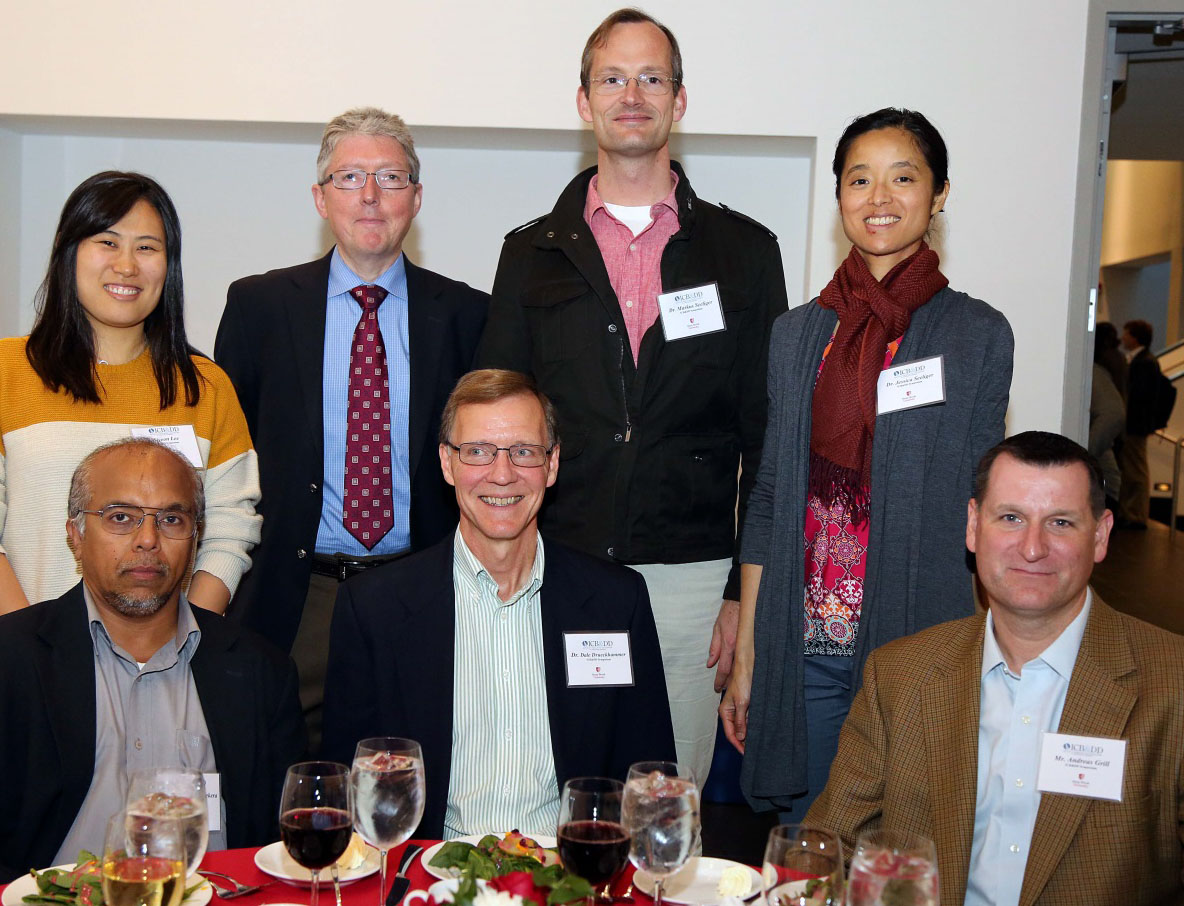
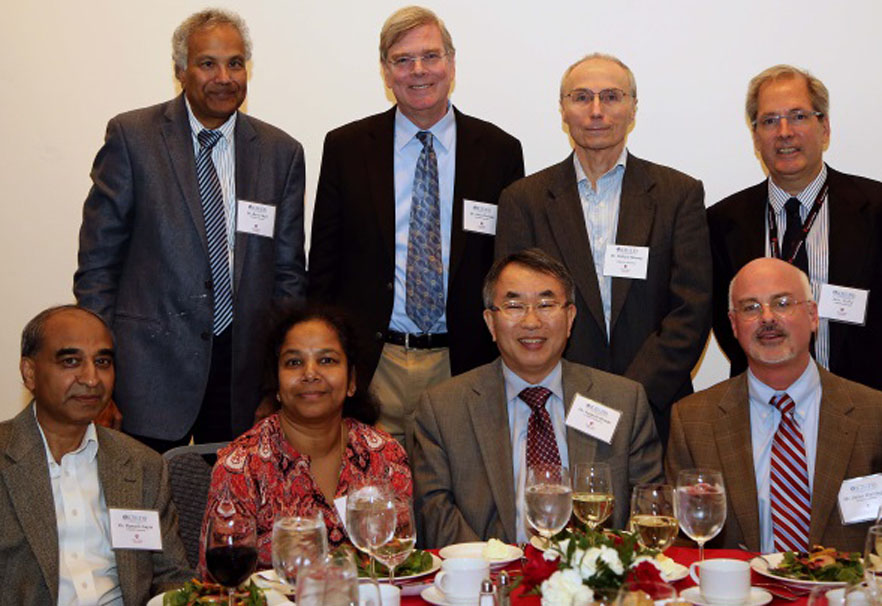
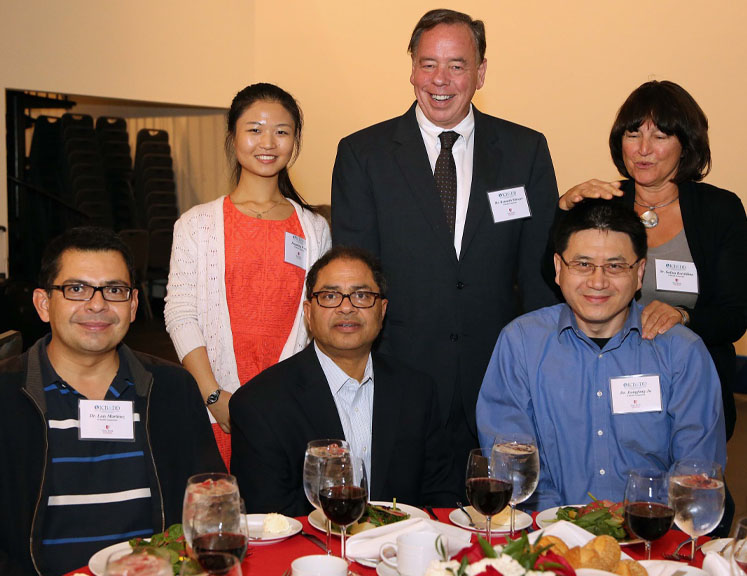
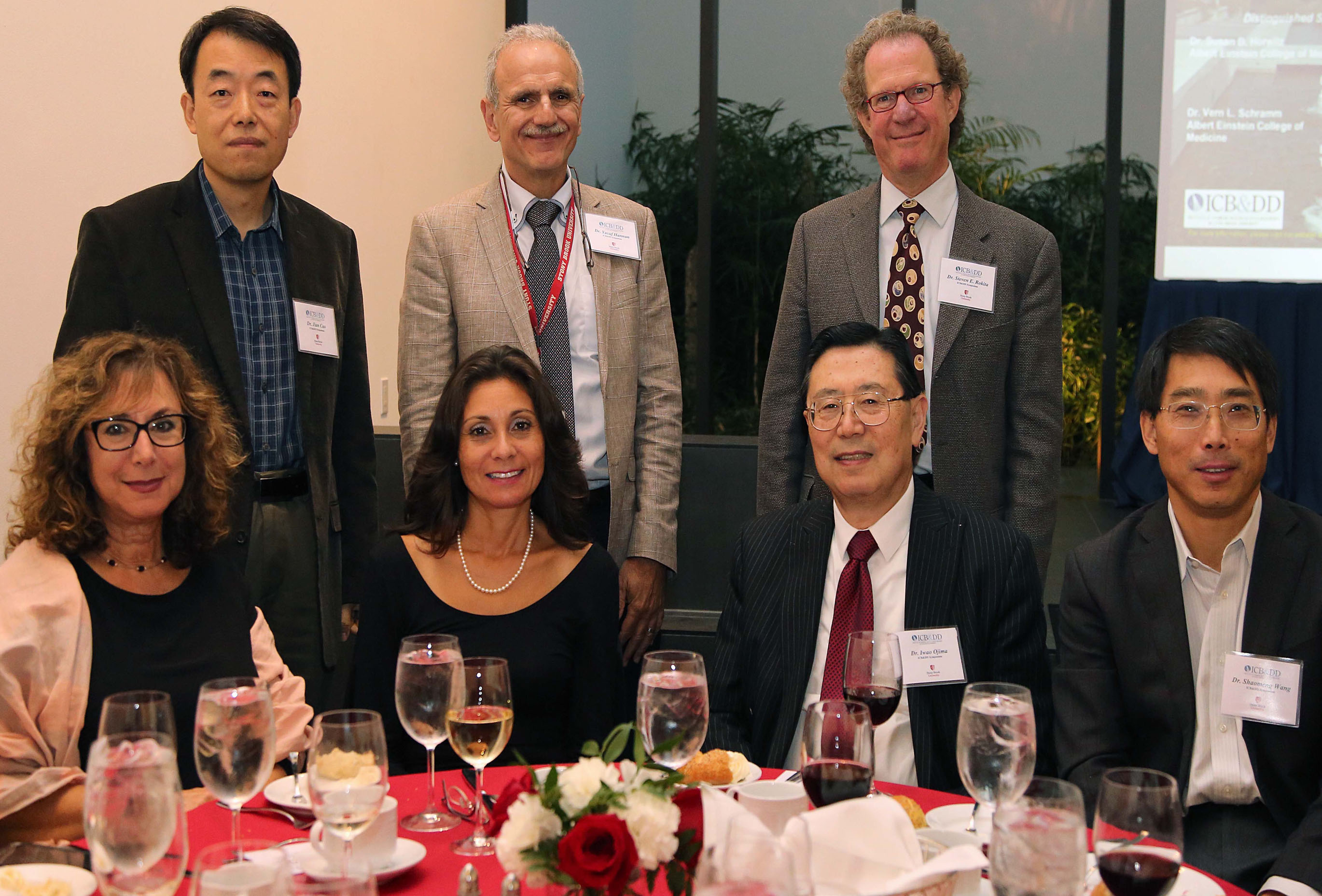
ICB&DD Eighth Annual Symposium (2014)
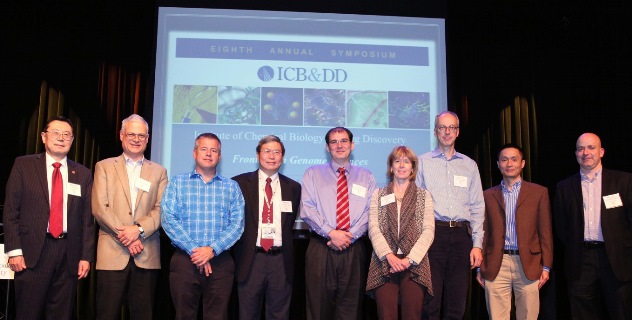
(from left to right), Drs. Iwao Ojima, Alan D’Andrea, Barry Stoddard, Vincent Yang, Miguel Garcia Diaz, Cynthia Burrows, Thomas Tuschl, Chuan He and Orlando Schärer
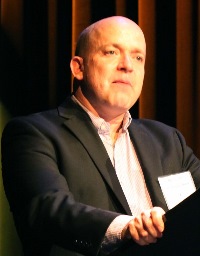 On Thursday, October 9, 2014, ICB&DD hosted its eighth ICB&DD Annual symposium entitled,
On Thursday, October 9, 2014, ICB&DD hosted its eighth ICB&DD Annual symposium entitled, 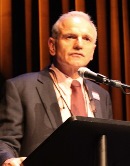 “Frontiers in Genome Sciences” at the Charles B. Wang Center, Stony Brook University.
The symposium featured seven Plenary Lecturers. Two of the lecturers, Dr. Dr. Miguel
Garcia-Diaz and Dr. Vincent Yang represented Stony Brook University. The event was
well attended by a widely ranging audience composed of faculty, research staff and
students on campus and Brookhaven National laboratory, as well as universities and
industries in the Greater NY metropolitan area. The Poster Session equally attracted
a large participation of students from Stony Brook University, Stony Brook Cancer
Center, Cold Spring Harbor Laboratory, Columbia University and Memorial Sloan-Kettering
Cancer Center among others. There were 66 scientific papers presented at the Poster
Session. Dr. Orlando Schärer, Professor of Pharmacological Sciences, Stony Brook
University and Chair of the Symposium Organizing Committee, opened the symposium,
and introduced Dr. Yusuf Hannun, Professor of Medicine and Director, Stony Brook Cancer
Center, and Vice-Dean for Cancer Medicine, Stony Brook University
“Frontiers in Genome Sciences” at the Charles B. Wang Center, Stony Brook University.
The symposium featured seven Plenary Lecturers. Two of the lecturers, Dr. Dr. Miguel
Garcia-Diaz and Dr. Vincent Yang represented Stony Brook University. The event was
well attended by a widely ranging audience composed of faculty, research staff and
students on campus and Brookhaven National laboratory, as well as universities and
industries in the Greater NY metropolitan area. The Poster Session equally attracted
a large participation of students from Stony Brook University, Stony Brook Cancer
Center, Cold Spring Harbor Laboratory, Columbia University and Memorial Sloan-Kettering
Cancer Center among others. There were 66 scientific papers presented at the Poster
Session. Dr. Orlando Schärer, Professor of Pharmacological Sciences, Stony Brook
University and Chair of the Symposium Organizing Committee, opened the symposium,
and introduced Dr. Yusuf Hannun, Professor of Medicine and Director, Stony Brook Cancer
Center, and Vice-Dean for Cancer Medicine, Stony Brook University 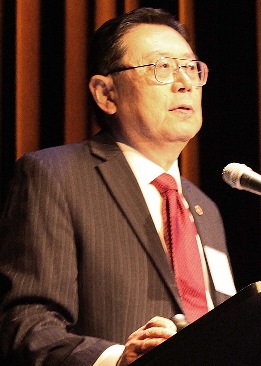 School of Medicine, who gave welcome remarks for the Symposium. Then, Dr. Schärer
introduced Dr. Iwao Ojima, Distinguished Professor and Director of ICB&DD. Dr. Ojima
concisely summarized the history of accomplishments, and the current and future goals
of ICB&DD.
School of Medicine, who gave welcome remarks for the Symposium. Then, Dr. Schärer
introduced Dr. Iwao Ojima, Distinguished Professor and Director of ICB&DD. Dr. Ojima
concisely summarized the history of accomplishments, and the current and future goals
of ICB&DD.
Dr. Nicole Sampson, Professor and Chair, Department of Chemistry, Stony Brook University
introduced the first Plenary Lecturer, Dr. Cynthia J. Burrows, Distinguished Professor, University of Utah. Dr. Burrows gave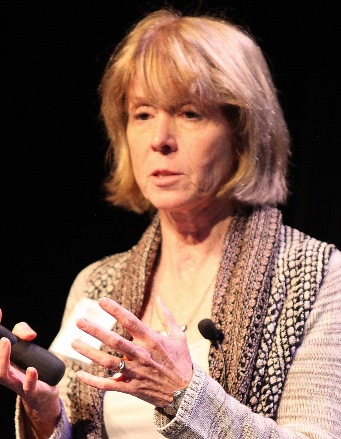 a lecture entitled, “Shape-Shifters: How Promoter and Telometric DNA Sequences Respond
to Oxidative Stress”. In her presentation, Dr. Burrows provided an overview of her
research that indicates that “oxidative stress in the cell results in modifications
to DNA and RNA bases and downstream events including effects on transcription and
a lecture entitled, “Shape-Shifters: How Promoter and Telometric DNA Sequences Respond
to Oxidative Stress”. In her presentation, Dr. Burrows provided an overview of her
research that indicates that “oxidative stress in the cell results in modifications
to DNA and RNA bases and downstream events including effects on transcription and  replication as well as signaling for repair. Ultimately unrepaired damage in DNA
leads to mutagenesis that is a contributing factor to cancer and other diseases”.
Dr. David Green, Associate Professor, Department of Applied Mathematics and Statistics,
Stony Brook University introduced the second Plenary Lecturer, Dr. Barry Stoddard, Principal Investigator, Fred Hutchinson Cancer Research Center. Dr. Stoddard gave
a lecture entitled, “Structure, Engineering and Application of Targeted Nucleases
for Genome Engineering and Correction”. In his presentation, Dr. Stoddard discussed
the approaches that are now being used in the rapidly maturing discipline of genome
engineering and targeted gene modification “in which genomes within cell lines, tissues
or organisms are manipulated and altered at specific individual loci”.
replication as well as signaling for repair. Ultimately unrepaired damage in DNA
leads to mutagenesis that is a contributing factor to cancer and other diseases”.
Dr. David Green, Associate Professor, Department of Applied Mathematics and Statistics,
Stony Brook University introduced the second Plenary Lecturer, Dr. Barry Stoddard, Principal Investigator, Fred Hutchinson Cancer Research Center. Dr. Stoddard gave
a lecture entitled, “Structure, Engineering and Application of Targeted Nucleases
for Genome Engineering and Correction”. In his presentation, Dr. Stoddard discussed
the approaches that are now being used in the rapidly maturing discipline of genome
engineering and targeted gene modification “in which genomes within cell lines, tissues
or organisms are manipulated and altered at specific individual loci”.
Dr. Elizabeth Boon, Associate Professor, Department of Chemistry, Stony Brook University
introduced the third Plenary Lecturer, Dr. Chuan He, Professor, The University of Chicago and Investigator, Howard Hughes Medical Institute.
Dr. He gave a lecture entitled, “Reversible DNA and RNA Methylation and Biological
Regulation”. In his presentation, Dr. He stated that, “we have developed chemical
and biochemical methods to precisely map 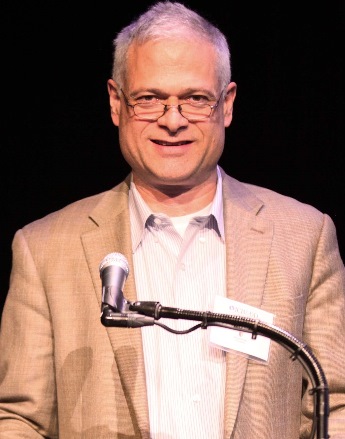 and study active DNA demethylation in mammalian systems,” and as a result of the use
these techniques, his research team’s “discoveries indicate the
and study active DNA demethylation in mammalian systems,” and as a result of the use
these techniques, his research team’s “discoveries indicate the 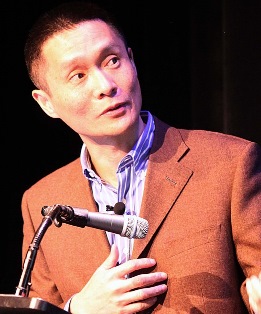 presence of a new mode of biological regulation that depends on reversible RNA modification”.
Dr. Orlando Schärer introduced the fourth Plenary Lecturer, Dr. Alan D. D’Andrea, Professor, Harvard Medical School and Scientific Director, Division of Genomic Stability
and DNA Repair, Dana Faber Cancer Institute. Dr. D’Andrea gave a lecture entitled,
“Fanconi Anemia/BRCA Pathway and its control by Ubiquitination”. “Fanconi Anemia (FA)
is a rare autosomal recessive X linked recessive cancer susceptibility disorder characterized
by bone marrow failure, congenital malformations, and cellular hypersensitivity to
Cisplatin, Mitomycin C, and other crosslionking agents”. Dr. D’Andrea’s lecture focused
“on the specific roles of Ubiquitin and SUMO in the regulation of the Fanconi Anemia/BRCA
pathway”. genesis that is a contributing factor to cancer and other diseases”.
presence of a new mode of biological regulation that depends on reversible RNA modification”.
Dr. Orlando Schärer introduced the fourth Plenary Lecturer, Dr. Alan D. D’Andrea, Professor, Harvard Medical School and Scientific Director, Division of Genomic Stability
and DNA Repair, Dana Faber Cancer Institute. Dr. D’Andrea gave a lecture entitled,
“Fanconi Anemia/BRCA Pathway and its control by Ubiquitination”. “Fanconi Anemia (FA)
is a rare autosomal recessive X linked recessive cancer susceptibility disorder characterized
by bone marrow failure, congenital malformations, and cellular hypersensitivity to
Cisplatin, Mitomycin C, and other crosslionking agents”. Dr. D’Andrea’s lecture focused
“on the specific roles of Ubiquitin and SUMO in the regulation of the Fanconi Anemia/BRCA
pathway”. genesis that is a contributing factor to cancer and other diseases”.
Dr. Kenneth Shroyer, Professor and Chair, Department of Pathology, Stony Brook University
introduced the fifth Plenary Lecturer, Dr. Vincent W. Yang, Professor and Chairman, Department of Medicine, Stony Brook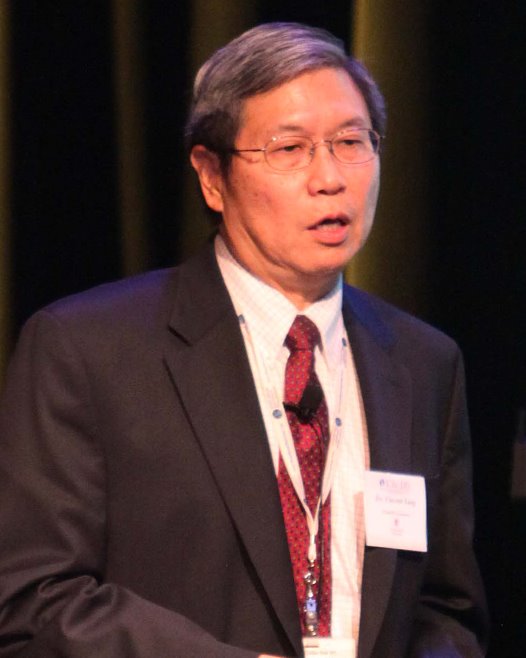
University School of Medicine. Dr. Yang gave a lecture entitled, “Intestinal Stem
Cells: Dynamics and Regulation”. In his presentation, Dr. Yang reviewed the recent
literature regarding how proliferation and lineage determination of Lgr5-expression
intestinal stem cells (ISC) is regulated. He also discussed “the roles of a number
of transcription factors called Krüppel-like factors (KLFs), in regulating proliferation
and differentiation of ISC in the intestinal epithelium”.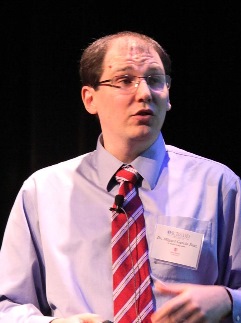
Dr. Jessica Seeliger, Assistant Professor, Department of Pharmacological Sciences,
Stony Brook University introduced the sixth Plenary Lecturer, Dr. Miguel Garcia-Diaz, Associate Professor, Department of Pharmacological Sciences, Stony Brook University
School of Medicine. Dr. Garcia-Diaz gave a lecture entitled, “Mechanisms of Mitochondrial
Transcription and Mitochondrial Disease”. In his presentation, Dr. Garcia-Diaz described
the extensive evidence that “links mitochondrial deficiencies to human pathology,
with defects in gene expression playing a central role in pathogenesis.” His research
team has “been studying the regulation of mitochondrial transcription, its association
with ribosome biogenesis and how defects in transcriptional termination can contribute
to mitochondrial disease”. Dr. Jingfang Ju, Associate Professor, Department of Pathology,
Stony Brook University introduced the seventh Plenary Lecturer, Dr. Thomas Tuschl, Professor, The Rockefeller University and Investigator, Howard Hughes Medical Institute.
Dr. Tuchl gave a lecture entitled, “RNA Regulation and DNA Diagnostics”. In his presentation,
Dr. Tuschl discussed his research group’s “experimental approaches for studying RNA-binding
proteins (RBPs) and defining their target RNAs and how these can be guided by their
census”. 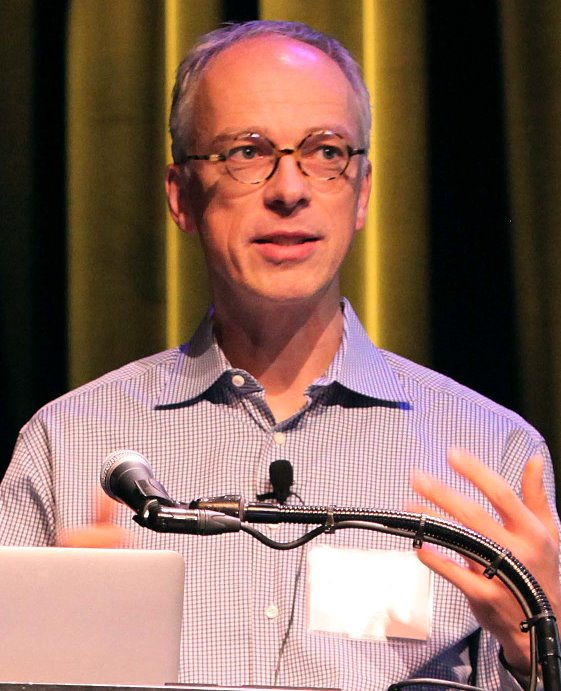
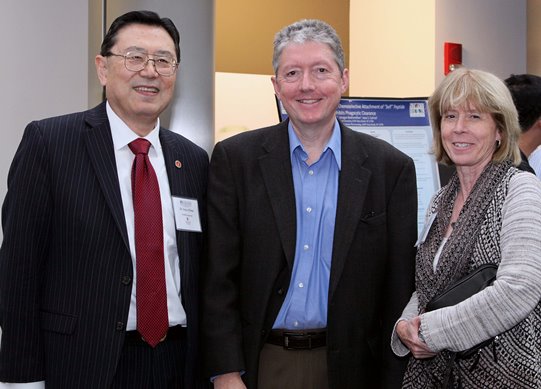 Dr. Schärer gave the closing remarks, thanking the Plenary Lecturers for their outstanding
presentations as well as the Organizing Committee members for the successful planning
and execution of the 8thAnnual ICB&DD Symposium.
Dr. Schärer gave the closing remarks, thanking the Plenary Lecturers for their outstanding
presentations as well as the Organizing Committee members for the successful planning
and execution of the 8thAnnual ICB&DD Symposium.
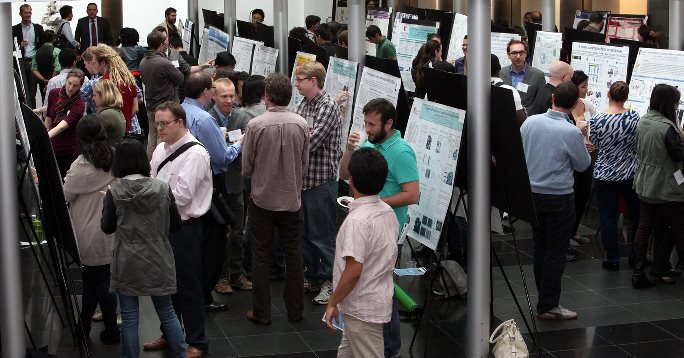 There were 66 scientific papers presented in the Poster Session. The best three posters
were selected for the Poster Awards. Historically, there have been two but the best
poster for the medicinal chemistry category was awarded this year. The award-winning
posters this year were: Lingling Jiang from the laboratory of Robert Rizzo. Grace
Tan from the laboratory of Markus Seeliger and Weixuan Yu for the medicinal chemistry
category from the
There were 66 scientific papers presented in the Poster Session. The best three posters
were selected for the Poster Awards. Historically, there have been two but the best
poster for the medicinal chemistry category was awarded this year. The award-winning
posters this year were: Lingling Jiang from the laboratory of Robert Rizzo. Grace
Tan from the laboratory of Markus Seeliger and Weixuan Yu for the medicinal chemistry
category from the
laboratory of Peter Tonge.
The 8th ICB&DD Symposium culminated with a splendid dinner at the Chapel of the Charles B.
Wang Center. Among the attendees were, Lina Obeid (Vice-Dean of Research, Stony Brook
University School of Medicine), Maria Ryan (Chair, Department of Oral Biology and
Pathology) and John Haley (Professor of Research,  Department of Pathology and Director of Proteomics, former Senior Research Director
of Translational Research, OSI Pharmaceuticals). They expressed their appreciation
for the outstanding lectures presented at the Symposium. Equally they acknowledged
the high level of importance of ICB&DD collaborative efforts among academia and industry.
They all congratulated Dr. Ojima for his numerous contributions and successful leadership
of the ICB&DD. This year, as part as commemorating 8 years of remarkable success
of these annual symposia, Dr. Ojima presented a “Glass Flame of Appreciation” to every
chair of the organizing committee since its inauguration from 2007. The flame of
appreciation awards were presented to Drs. James Bliska, Daniel Raleigh, Nicole Sampson,
Maria Ryan, Peter Tonge, Todd Miller, Robert Haltiwanger and Orlando Scharer. A “Glass
Flame of Appreciation” was also presented to Ms. Roxanne Brockner, Assistant to the
Director of ICB&DD. Dr. Ojima cited her crucial contributions to the success of ICB&DD,
and particularly big applauses were given to her distinction. The Symposium was co-sponsored
by, Office of the Vice-President for Research, Stony Brook University School of Medicine,
Department of Chemistry and Chem-Master International Inc.
Department of Pathology and Director of Proteomics, former Senior Research Director
of Translational Research, OSI Pharmaceuticals). They expressed their appreciation
for the outstanding lectures presented at the Symposium. Equally they acknowledged
the high level of importance of ICB&DD collaborative efforts among academia and industry.
They all congratulated Dr. Ojima for his numerous contributions and successful leadership
of the ICB&DD. This year, as part as commemorating 8 years of remarkable success
of these annual symposia, Dr. Ojima presented a “Glass Flame of Appreciation” to every
chair of the organizing committee since its inauguration from 2007. The flame of
appreciation awards were presented to Drs. James Bliska, Daniel Raleigh, Nicole Sampson,
Maria Ryan, Peter Tonge, Todd Miller, Robert Haltiwanger and Orlando Scharer. A “Glass
Flame of Appreciation” was also presented to Ms. Roxanne Brockner, Assistant to the
Director of ICB&DD. Dr. Ojima cited her crucial contributions to the success of ICB&DD,
and particularly big applauses were given to her distinction. The Symposium was co-sponsored
by, Office of the Vice-President for Research, Stony Brook University School of Medicine,
Department of Chemistry and Chem-Master International Inc.

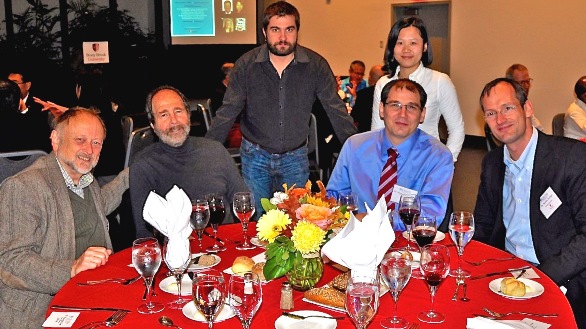
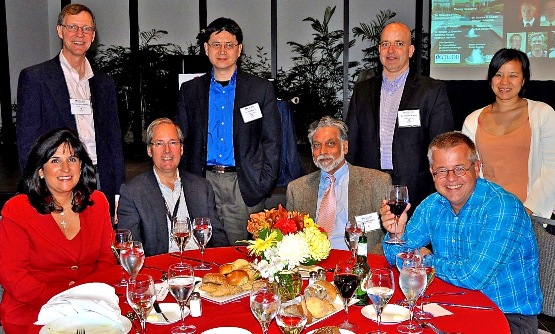
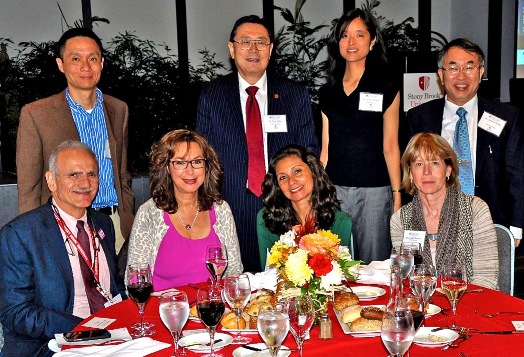
ICB&DD Seventh Annual Symposium (2013)
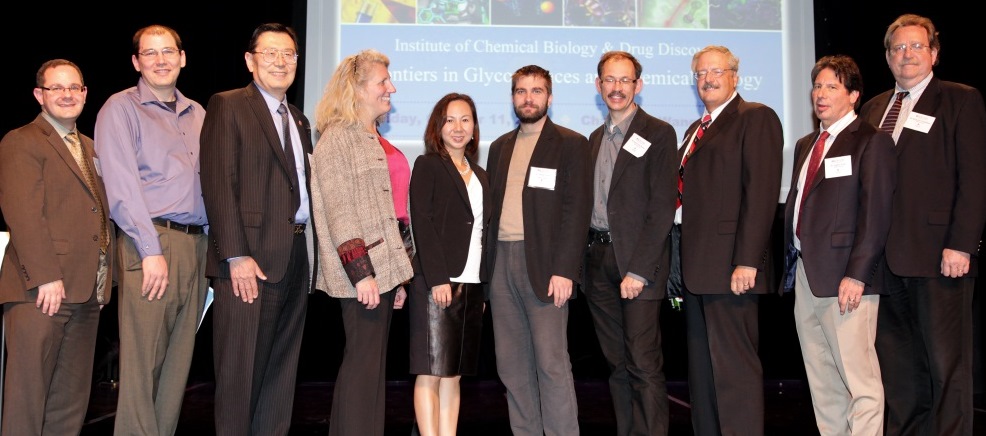
(from left to right) Drs. Jonathan Rudick, Miguel Garcia-Díaz, Iwao Ojima, Nicole Sampson, Linda Hsieh-Wilson, David Green, Geert-Jan Boons, Gerard Hart, Jeffery Esko and Richard Cummings
On Friday, October 11, 2013, The ICB&DD hosted its ICB&DD seventh Annual Symposium entitled, “Frontiers in Glycosciences and Chemical Biology” at the Charles B. Wang Center, Stony Brook University. The symposium featured seven Plenary Lecturers. Two of the lecturers, David Green and Nicole Sampson represented Stony Brook University. The event was very well attended by a widely ranging audience composed of faculty, research staff and students on campus and Brookhaven National Laboratory, as well as universities and industries in the greater NY metropolitan area. The Poster Session equally attracted a large participation of students from Stony Brook University, New York University, Columbia University, Chembio Diagnostic Systems Inc, and Brookhaven National Laboratory among others. There were 82 scientific papers presented at the Poster Session.

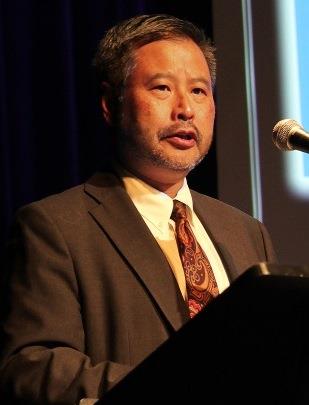
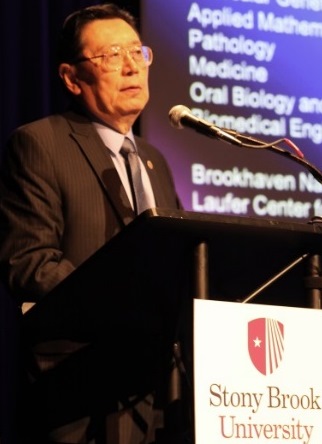
Dr. Robert Haltiwanger, Chair of the Symposium Organizing Committee, opened the Symposium, and introduced Dr. Bejamin Hsiao, Vice President for Research at Stony Brook University, who gave welcome remarks for the Symposium. Then, Dr. Haltiwanger introduced Dr. Iwao Ojima, Distinguished Professor and Director of ICB&DD. Dr. Ojima concisely summarized the history of accomplishments, current and future goals of ICB&DD.
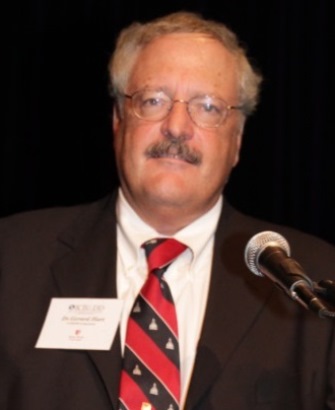 Dr. Haltiwanger, Professor and Chair of Cell Biology and Biochemistry, introduced
the first Plenary Lecturer, Dr. Gerald Hart, Professor and Director of Biological Chemistry, Johns Hopkins University School of
Medicine. Dr. Hart gave a lecture entitled, “Nutrient Regulation of Signaling & Transcription:
Roles of O-GlcNAcylation in Diabetes, Cancer and Neurodegeneration”. He presented an excellent
overview of his research program on understanding how dynamic O-GlcNAcylation serves as a major sensor of cellular nutrient status and how it regulates
transcription, signaling and metabolism in response to nutrients.
Dr. Haltiwanger, Professor and Chair of Cell Biology and Biochemistry, introduced
the first Plenary Lecturer, Dr. Gerald Hart, Professor and Director of Biological Chemistry, Johns Hopkins University School of
Medicine. Dr. Hart gave a lecture entitled, “Nutrient Regulation of Signaling & Transcription:
Roles of O-GlcNAcylation in Diabetes, Cancer and Neurodegeneration”. He presented an excellent
overview of his research program on understanding how dynamic O-GlcNAcylation serves as a major sensor of cellular nutrient status and how it regulates
transcription, signaling and metabolism in response to nutrients.
 Dr. Jonathan Rudick, Assistant Professor of Chemistry introduced the second Plenary
Lecturer, Dr. Geert-Jan Boons, Professor, Department of Chemistry, University of Georgia. Dr. Boons gave a lecture
entitled, “Glycoscience: Downsizing or Oversizing?” His presentation described a chemoenzymatic
strategy that can provide libraries of highly complex asymmetrical N-glycans
Dr. Jonathan Rudick, Assistant Professor of Chemistry introduced the second Plenary
Lecturer, Dr. Geert-Jan Boons, Professor, Department of Chemistry, University of Georgia. Dr. Boons gave a lecture
entitled, “Glycoscience: Downsizing or Oversizing?” His presentation described a chemoenzymatic
strategy that can provide libraries of highly complex asymmetrical N-glycans
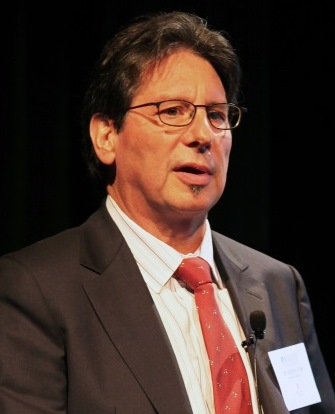 Dr. Wei-Xing Zong, Associate Professor of Molecular Genetics & Microbiology introduced
the third Plenary Lecturer, Dr. Jeffery Esko, Professor, Department of Molecular and Cellular Medicine, University of California
at San Diego. Dr. Esko gave a very stimulating lecture entitled, “Heparin Sulfate:
Light at the End of the Chain”. In his presentation, Dr. Esko focused on the need
for improved biomarkers for differential diagnosis, prognosis and monitoring of therapeutic
interventions for mucopolysaccharidoses (MPS).
Dr. Wei-Xing Zong, Associate Professor of Molecular Genetics & Microbiology introduced
the third Plenary Lecturer, Dr. Jeffery Esko, Professor, Department of Molecular and Cellular Medicine, University of California
at San Diego. Dr. Esko gave a very stimulating lecture entitled, “Heparin Sulfate:
Light at the End of the Chain”. In his presentation, Dr. Esko focused on the need
for improved biomarkers for differential diagnosis, prognosis and monitoring of therapeutic
interventions for mucopolysaccharidoses (MPS).
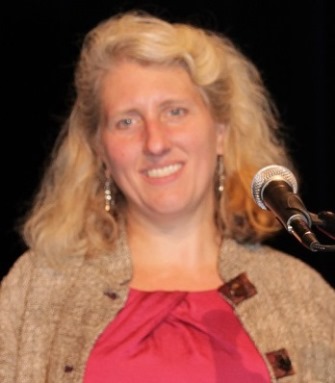 Dr. Elizabeth Boon, Associate Professor of Chemistry introduced the fourth Plenary
Lecturer, Dr. Nicole Sampson, Professor and Chair, Department of Chemistry, Stony Brook University. Dr. Sampson gave a lecture entitled, “Mycobacteria on Steroids: Metabolite Profiling
and Enzyme Function”. She described the identification of two new structural-functional
enzyme motifs in Mycobacterium tuberculosis (Mtb) for the catalysis of b-oxidation with steroid substrates in the igr operon that function in the metabolic pathway for sterol side chain cleavage in the
metabolism of cholesterol.
Dr. Elizabeth Boon, Associate Professor of Chemistry introduced the fourth Plenary
Lecturer, Dr. Nicole Sampson, Professor and Chair, Department of Chemistry, Stony Brook University. Dr. Sampson gave a lecture entitled, “Mycobacteria on Steroids: Metabolite Profiling
and Enzyme Function”. She described the identification of two new structural-functional
enzyme motifs in Mycobacterium tuberculosis (Mtb) for the catalysis of b-oxidation with steroid substrates in the igr operon that function in the metabolic pathway for sterol side chain cleavage in the
metabolism of cholesterol.

Dr. David Green, Associate Professor of Applied Mathematics and Statistics introduced the fifth Plenary Lecturer, Dr. Richard Cummings, Professor and Chair, Department of Chemistry, National Center for Functional Glycomics, Emory University School of Medicine. Dr. Cummings’ lecture was entitled, “Genetic and Biochemical Insights into Roles of Glycoconjugates in Animal Biology and Disease”. Dr. Cummings presented how the use of both genetic and biochemical approaches has enabled him and his team to explore the roles of glycoconjugates in a variety of biological systems, including animal development and cancer, as well as innate and adaptive immune responses.
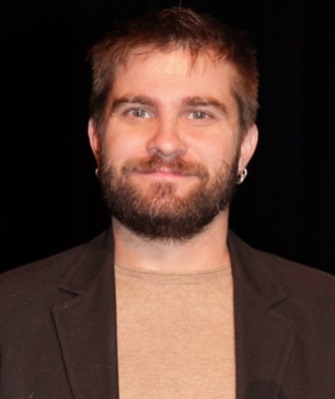 Dr. Miguel Garcia-Diaz, Associate Professor of Pharmacology introduced the sixth Plenary
Lecturer, Dr. David Green, Associate Professor, Department of Applied Mathematics and Statistics, Stony Brook
University. Dr. Green’s presentation was entitled, “Rational Engineering of Anti-Viral
Lectins Targeting HIV”. In his lecture, Dr. Green indicated that viral surfaces are
able to avoid an immune response because their surfaces are heavily glycosylated.
He indicated that his team’s understanding of the origins and affinities of a series
of oligosaccharides is evolving and his team has developed computational models that
explain the known differences in affinities for a series of oligosaccharides and provide
insight into the mechanisms of multi-valent bonding.
Dr. Miguel Garcia-Diaz, Associate Professor of Pharmacology introduced the sixth Plenary
Lecturer, Dr. David Green, Associate Professor, Department of Applied Mathematics and Statistics, Stony Brook
University. Dr. Green’s presentation was entitled, “Rational Engineering of Anti-Viral
Lectins Targeting HIV”. In his lecture, Dr. Green indicated that viral surfaces are
able to avoid an immune response because their surfaces are heavily glycosylated.
He indicated that his team’s understanding of the origins and affinities of a series
of oligosaccharides is evolving and his team has developed computational models that
explain the known differences in affinities for a series of oligosaccharides and provide
insight into the mechanisms of multi-valent bonding.
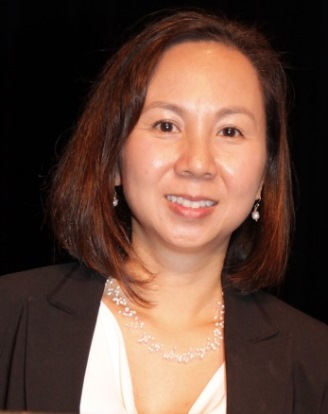 Dr. Isaac Carrico, Associate Professor of Chemistry introduced the seventh Plenary
Lecturer, Dr. Linda Hsieh-Wilson, Professor Division of Chemistry and Chemical Engineering, California Institute of
Technology and the Howard Hughes Medical Institute, Pasadena, California. Dr. Hsieh-Wilson’s
presentation was entitled, “The Sweeter Side of Cellular Signaling: Elucidating the
Structure-Function Relationships of Carbohydrates in the Brain”. In her stimulating
presentation, Dr. Hsieh-Wilson described the fundamental challenges in studying carbohydrates
and the development of chemical approaches to overcome these challenges. She exemplified
how the principles and tools of chemistry can be used to elucidate the roles of carbohydrates
and their associated proteins in development and neuroregeneration.
Dr. Isaac Carrico, Associate Professor of Chemistry introduced the seventh Plenary
Lecturer, Dr. Linda Hsieh-Wilson, Professor Division of Chemistry and Chemical Engineering, California Institute of
Technology and the Howard Hughes Medical Institute, Pasadena, California. Dr. Hsieh-Wilson’s
presentation was entitled, “The Sweeter Side of Cellular Signaling: Elucidating the
Structure-Function Relationships of Carbohydrates in the Brain”. In her stimulating
presentation, Dr. Hsieh-Wilson described the fundamental challenges in studying carbohydrates
and the development of chemical approaches to overcome these challenges. She exemplified
how the principles and tools of chemistry can be used to elucidate the roles of carbohydrates
and their associated proteins in development and neuroregeneration.
Dr. Haltiwanger gave the closing remarks, thanking the Plenary Lecturers for their outstanding presentations as well as the Organizing Committee members for the successful planning and execution of the 7th Annual ICB&DD Symposium.
There were 82 scientific papers presented at the Poster Session. The best two posters were selected for the Poster Awards. The award-winning posters this year were: Sajjad Hossain from the laboratory of Elizabeth Boon in Department of Chemistry and Julie-Ann Cavallo from Department of Pharmacological Sciences, Stony Brook School of Medicine.
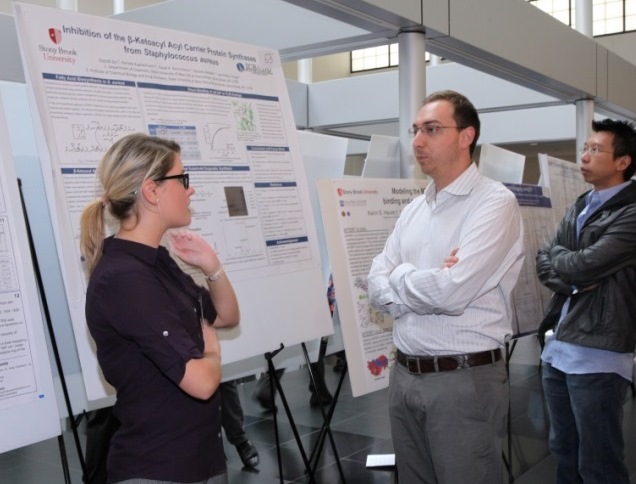
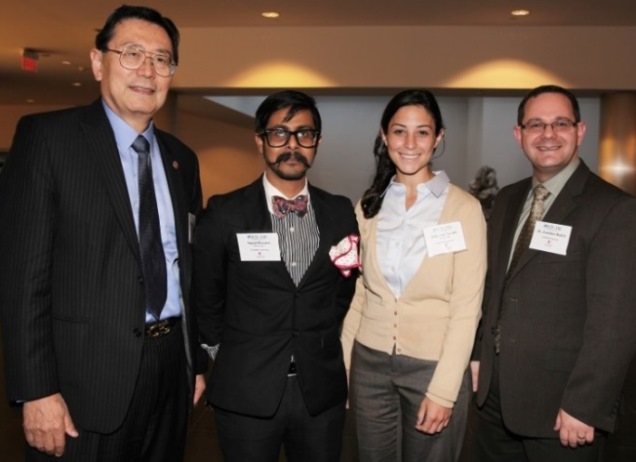
The 7th ICB&DD Symposium culminated with a splendid dinner at the Chapel of the Charles B. Wang Center. Among other attendees were Dr. Benjamin Hsiao, Vice-President for Research, Dr. Nicole Sampson (Chair, Department of Chemistry), Maria Ryan (Chair, Department of Oral Biology and Pathology) and Dr. Michael Frohman (Chairman, Department of Pharmacological Sciences, SOM). They expressed their appreciation for the outstanding lectures presented at the Symposium. Equally, they acknowledged the high level of importance of ICB&DD collaborative efforts among academia and industry. They all congratulated Professor Ojima for his numerous contributions and successful leadership of the ICB&DD. The symposium was co-sponsored by the Office of the Vice President for Research, Office of the Provost, School of Medicine, Department of Chemistry, Department of Biochemistry and Cell Biology, Forest Laboratories Inc. and Chem-Master International, Inc.
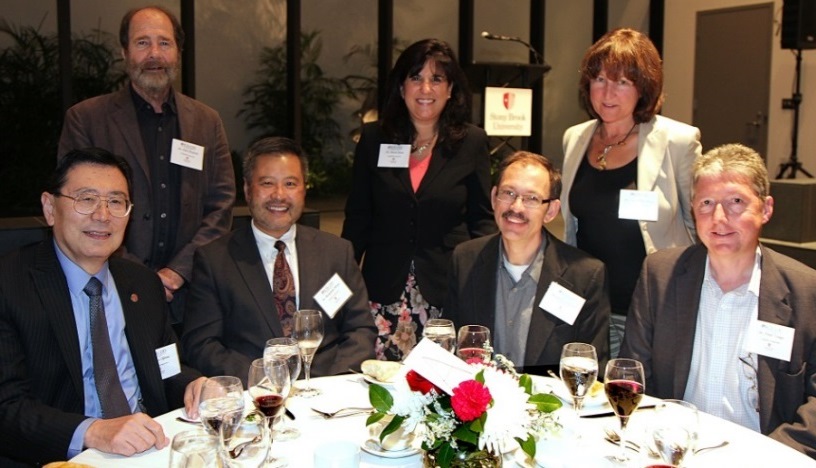
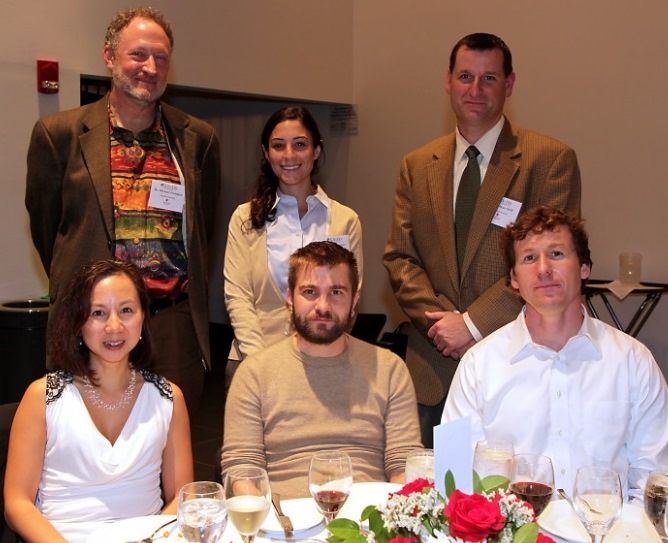
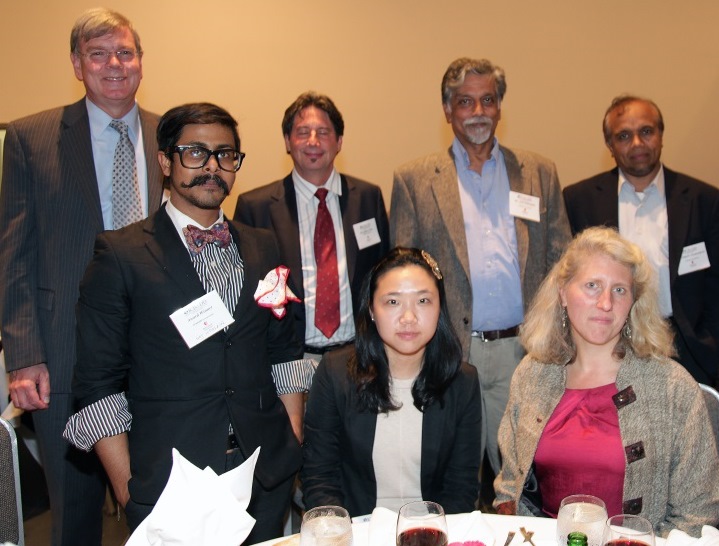
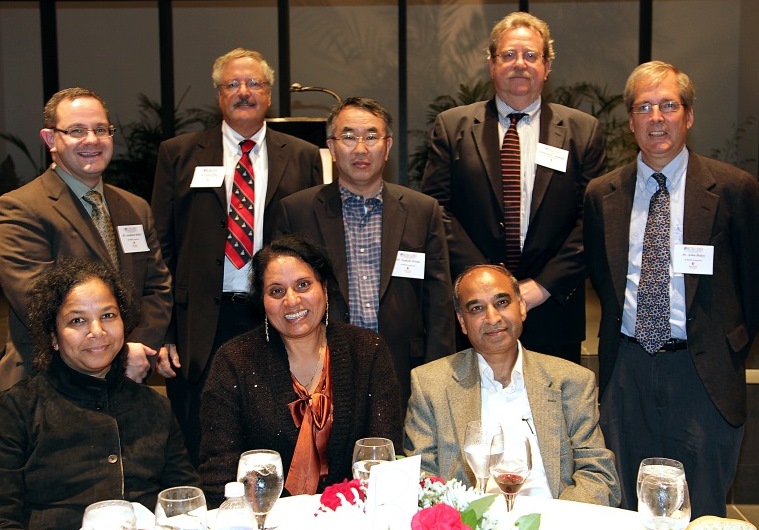
ICB&DD Sixth Annual Symposium (2012)
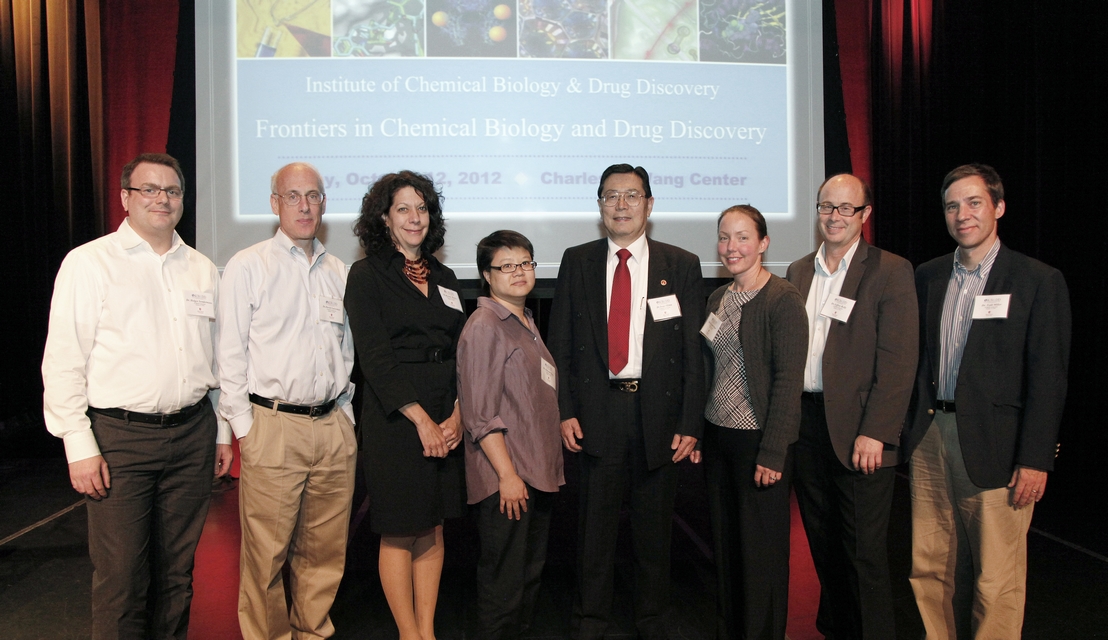
(from left to right) Drs. Holger Sondermann, David Lawrence, Bonnie Bassler, Deborah Hung, Iwao Ojima, Elizabeth Boon, Jeffery Kelly and Todd Miller.
On Friday, October 12, 2012, The ICB&DD hosted its Sixth ICB&DD Annual Symposium,
“Frontiers in Chemical Biology and Drug Discovery” at the Charles B. Wang Center at
Stony Brook University. The symposium featured seven Plenary Lecturers. Two of them
were from Stony Brook University. The event was very well attended by a wide range
of audience from faculty, research staff and students on campus as well as universities
and industries in the greater NY metropolitan area and Brookhaven National Laboratory.
The Poster Session equally attracted a large participation of students from Stony
Brook University, New York University, Columbia University, Chembio Diagnostic Systems
Inc, and Brookhaven National Laboratory among others. There were 78 scientific abstracts
presented at the Poster Session.
Dr. Todd Miller, Professor and Chair of the Symposium Organizing Committee, opened
the Symposium and introduced Dr. Iwao Ojima, Distinguished Professor and Director
of ICB&DD. Dr. Ojima concisely summarized the history of accomplishments, current
and future goals of the ICB&DD. Dr.Elizabeth Boon, Assistant Professor of Chemistry
introduced the first Plenary Lecturer, Dr. Bonnie BasslerHoward Hughes Medical Institute Investigator and the Squibb Professor of Molecular
Biology at Princeton University, Member of the National Academy of Sciences. Dr. Bassler
gave a lecture entitled “Manipulating Quorum Sensing to Control Bacterial Pathogenecity”
. She explained the focus of her research on understanding how cell-cell communication
in bacteria involves the production, release and subsequent detection of chemical
signaling molecules named autoinducers. A process called quorum sensing. Research
is now targeted in the development of therapies that interfere with quorum sensing
to control bacterial virulence. Dr. Daniel Raleigh, Professor of Chemistry introduced
the second Plenary Lecturer, Dr. Jeffery Kelly, Chairman, Department of Molecular and Experimental Medicine, Department of Chemistry,
the Scripps Research Institute. Dr. Kelly gave a lecture entitled “Biological and
Chemical Approaches to Adapt Proteostasis to Ameliorate Protein Misfolding and Aggregation
Diseases”. His presentation focused on how the proteostasis network can be adapted
through unfolded protein response arm-selective signaling to alleviate several loss-of-function
diseases where excessive  misfolding and degradation leads to maladies like the lysosomal storage diseases.
Dr. James Bliska,Professor of Microbiology, introduced the third Plenary Lecturer, Dr. Holger Sondermann, Dr. Sondermann gave a very stimulating lecture entitled “The ins and outs of c-di-GMP
Signaling in Bacterial Biofilm Formation”. In his presentation, Dr. Sondermann focused
on the molecular mechanisms that yield finely tuned signaling cascades controlling
cell adhesion in several bacterial species. In addition, how in the long term, the
results emerging from these studies could provide blueprints for the development of
novel therapeutics against bacterial infections. Dr. Stanley Zucker, Professor of
Medicine, introduced the fourth Plenary Lecturer, Dr. Basil Rigas, Professor of Medicine and Pharmacological Sciences. Chief, Divisions of Cancer Prevention
and Gastroenterology, Dean for Clinical Affairs, Stony Brook University School of Medicine. Dr. Rigas gave a lecture entitled “Modified NSAIDs and Cancer”. He presented an overview
of his research on cancer prevention and its emphasis on the development of novel
anticancer agents. He discussed how epidemiological studies and interventional trials
have established NSAIDs as efficacious chemopreventive agents against several human
cancers. Their drawbacks are low efficacy and significant side effects. To overcome
these limitations, he has developed a general approach through which targeted chemical
modifications of NSAIDs enhance their efficacy and minimize their toxicity. Dr. Jessica
Seeliger, Assistant Professor of Pharmacological Sciences introduced the fifth Plenary
Lecturer, Dr. Deborah Hung, Physician Scientist, Center for Computational and Integrative Biology, and Department
of Molecular Biology, Massachusetts General Hospital; Department of Microbiology and Immunobiology, Harvard Medical School; Broad Institute of MIT and Harvard University. Dr. Hung’s
lecture was entitled “Chemical Biological Approach to TB: Identifying New Drugs Targets”.
Dr. Hung explained the focus of her research in how she is combining chemical biology
and genomic approaches to define host-pathogen interactions and to reveal essential in vivo gene functions of pathogens to explore new paradigms for anti-infective intervention.
By deploying small organic molecules and genome-wide tools to both perturb and understand
bacterial infection, she is working to provide insight into new approaches to a variety
of devastating pathogens, including Vibrio cholerae, Pseudomonas aeruginosa and Mycobacterium tuberculosis.
misfolding and degradation leads to maladies like the lysosomal storage diseases.
Dr. James Bliska,Professor of Microbiology, introduced the third Plenary Lecturer, Dr. Holger Sondermann, Dr. Sondermann gave a very stimulating lecture entitled “The ins and outs of c-di-GMP
Signaling in Bacterial Biofilm Formation”. In his presentation, Dr. Sondermann focused
on the molecular mechanisms that yield finely tuned signaling cascades controlling
cell adhesion in several bacterial species. In addition, how in the long term, the
results emerging from these studies could provide blueprints for the development of
novel therapeutics against bacterial infections. Dr. Stanley Zucker, Professor of
Medicine, introduced the fourth Plenary Lecturer, Dr. Basil Rigas, Professor of Medicine and Pharmacological Sciences. Chief, Divisions of Cancer Prevention
and Gastroenterology, Dean for Clinical Affairs, Stony Brook University School of Medicine. Dr. Rigas gave a lecture entitled “Modified NSAIDs and Cancer”. He presented an overview
of his research on cancer prevention and its emphasis on the development of novel
anticancer agents. He discussed how epidemiological studies and interventional trials
have established NSAIDs as efficacious chemopreventive agents against several human
cancers. Their drawbacks are low efficacy and significant side effects. To overcome
these limitations, he has developed a general approach through which targeted chemical
modifications of NSAIDs enhance their efficacy and minimize their toxicity. Dr. Jessica
Seeliger, Assistant Professor of Pharmacological Sciences introduced the fifth Plenary
Lecturer, Dr. Deborah Hung, Physician Scientist, Center for Computational and Integrative Biology, and Department
of Molecular Biology, Massachusetts General Hospital; Department of Microbiology and Immunobiology, Harvard Medical School; Broad Institute of MIT and Harvard University. Dr. Hung’s
lecture was entitled “Chemical Biological Approach to TB: Identifying New Drugs Targets”.
Dr. Hung explained the focus of her research in how she is combining chemical biology
and genomic approaches to define host-pathogen interactions and to reveal essential in vivo gene functions of pathogens to explore new paradigms for anti-infective intervention.
By deploying small organic molecules and genome-wide tools to both perturb and understand
bacterial infection, she is working to provide insight into new approaches to a variety
of devastating pathogens, including Vibrio cholerae, Pseudomonas aeruginosa and Mycobacterium tuberculosis.
 Dr. Peter Tonge, Professor of Chemistry introduced the sixth Plenary Lecturer, Dr. Elizabeth Boon, AssistantProfessor of Department of Chemistry, Stony Brook University. Dr. Boon’s
gave a lecture entitled “Nitric Oxide Signaling in Bacteria: Discovery of a new Mechanism
for regulating Bacterial Group Behavior”. She described her studies on the importance
of nitric oxide (NO) as biological signals and its signaling role in bacteria. NO
has also been implicated in processes such as quorum sensing and biofilm formation.
Biofilms are extremely resistant to antibiotic treatments and responsible for approximately
60 percent of all human infections. Dr. Todd Miller, Professor of Physiology and Biophysics
introduced the seventh Plenary Lecturer, Dr. David Lawrence, Professor, Division of Medicinal Chemistry & Natural Products, School of Pharmacy & Department
of Chemistry, University of North Carolina at Chapel Hill. Dr. Lawrence presented
a lecture entitled “Organic Chemistry at the Edge of Biology: Taming Cell Behavior
with Light Responsive Molecules”. His very informative lecture provided a comprehensive
view of the challenges associated with the design, synthesis, and use of light-responsive
bioreagents, the scope and limitations associated with the instrumentation required
for their applications, and a few recent examples used to scrutinize the secrets of
cell signaling and behavior. Dr. Miller gave the closing remarks, thanking the Plenary
Lecturers for their outstanding presentations as well as the Organizing Committee
members for the successful planning and execution of the 6th Annual ICB&DD Symposium.
Dr. Peter Tonge, Professor of Chemistry introduced the sixth Plenary Lecturer, Dr. Elizabeth Boon, AssistantProfessor of Department of Chemistry, Stony Brook University. Dr. Boon’s
gave a lecture entitled “Nitric Oxide Signaling in Bacteria: Discovery of a new Mechanism
for regulating Bacterial Group Behavior”. She described her studies on the importance
of nitric oxide (NO) as biological signals and its signaling role in bacteria. NO
has also been implicated in processes such as quorum sensing and biofilm formation.
Biofilms are extremely resistant to antibiotic treatments and responsible for approximately
60 percent of all human infections. Dr. Todd Miller, Professor of Physiology and Biophysics
introduced the seventh Plenary Lecturer, Dr. David Lawrence, Professor, Division of Medicinal Chemistry & Natural Products, School of Pharmacy & Department
of Chemistry, University of North Carolina at Chapel Hill. Dr. Lawrence presented
a lecture entitled “Organic Chemistry at the Edge of Biology: Taming Cell Behavior
with Light Responsive Molecules”. His very informative lecture provided a comprehensive
view of the challenges associated with the design, synthesis, and use of light-responsive
bioreagents, the scope and limitations associated with the instrumentation required
for their applications, and a few recent examples used to scrutinize the secrets of
cell signaling and behavior. Dr. Miller gave the closing remarks, thanking the Plenary
Lecturers for their outstanding presentations as well as the Organizing Committee
members for the successful planning and execution of the 6th Annual ICB&DD Symposium.
There were 78 scientific abstracts at the Poster Session. The best two posters were selected for the Poster Awards. The award-winning posters this year were by Dr. Kanishk Kapilashrami from the laboratory of Dr. Peter Tonge, Department of Chemistry, Esam Al-Shareffi from the laboratory of Dr. Robert Haltiwanger, Department of Biochemistry and William J. Allen from the laboratory of Dr. Robert Rizzo, Department of Mathematics and Statistics at Stony Brook University.

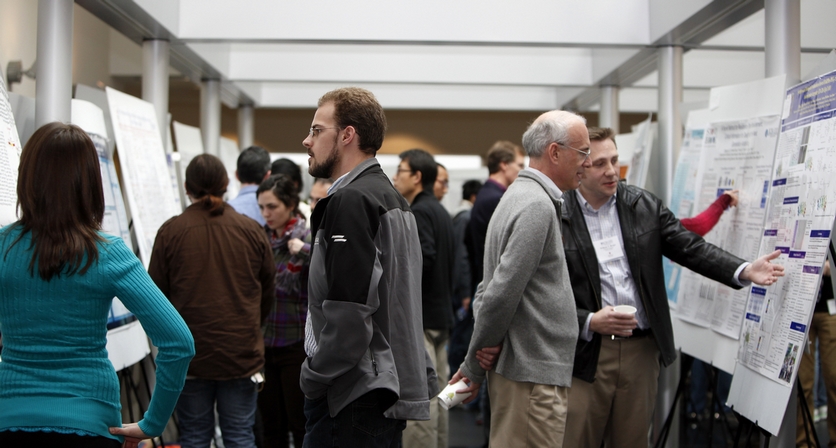
The 6th ICB&DD Symposium culminated with a splendid dinner at the Chapel of the Charles B. Wang Center. Among other attendees were Dr. Nicole Sampson (Chairman, Department of Chemistry), Dr. Michael Frohman (Chairman, Department of Pharmacological Sciences, SOM) and Anil Duhndale (Executive Director of the Long Island High Technology Incubator (LIHTI) and Stony Brook University Business Incubators). They expressed their appreciation for the outstanding lectures presented at the Symposium. Equally, they acknowledged the high level of importance of ICB&DD collaborative efforts among academia and industry. They all congratulated Professor Ojima for his numerous contributions and successful leadership of the ICB&DD. The symposium was cosponsored by the Office of the Vice President for Research, Office of the Provost, School of Medicine Office of Scientific Affairs, Department of Chemistry, Forest Laboratories Inc. and Chem-Master International, Inc.

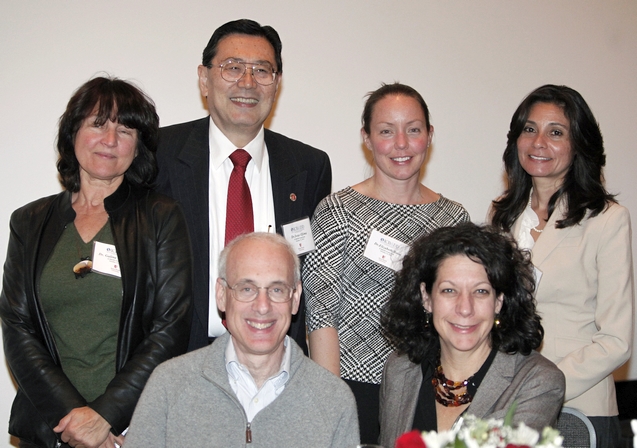
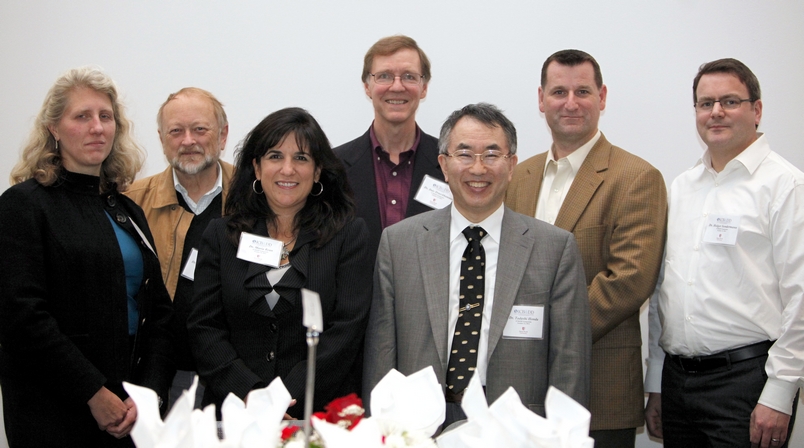
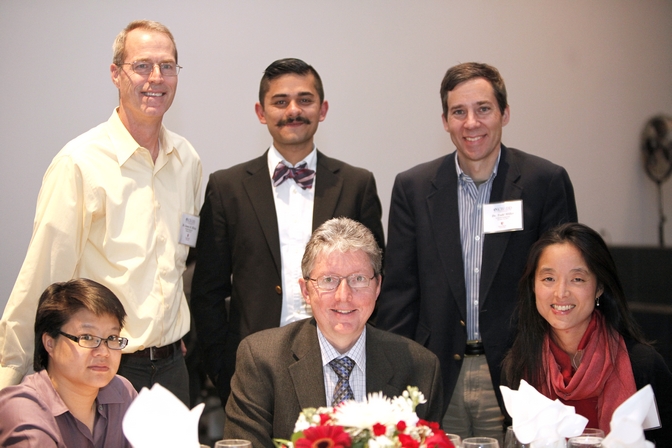
ICB&DD Fifth Annual Symposium (2011)
(from left to right) Drs. Peter Tonge, John Gerlt, Celia Schiffer, Carlos Simmerling, Russell Petter, Stephen Frye and Iwao Ojima
On Friday, October 14, 2011, The ICB&DD hosted its fifth ICB&DD Annual Symposium,
“Frontiers in Chemical Biology and Drug Discovery” at the CharlesB.WangCenterat StonyBrookUniversity.
The symposium featured seven Plenary Lecturers. Three of them were from StonyBrookUniversity.
The event was very well attended by a wide range of audience from faculty, research
staff and students on campus as well as Brookhaven National Laboratory, universities
and industries in the greater NY metropolitan area. The Poster Session equally attracted a large participation of students fromStony
Brook University, New York University,YaleUniversity, OSI Pharmaceuticals and Brookhaven
National Laboratory among others. There were a record number of 85 scientific papers
presented at the Poster Session.
Dr. Peter Tonge, Professor and Chair of the Symposium Organizing Committee, opened
the Symposium and introduced Dr. Wadie Bahou, Professor of Medicine and Vice Dean
for Scientific Affairs, Stony Brook University School of Medicine. Dr. Bahou gave
praising remarks about the accomplishments and advances of ICB&DD, made through arduous
collaborating efforts among scientists and clinicians. Dr. Tonge introduced Dr. Iwao Ojima, Distinguished Professor and Director of ICB&DD. Dr. Ojima
briefly summarized the accomplishments, current and future goals of the ICB&DD.
Dr.Maria Ryan, Professor of Oral Biology and Pathology introduced the first Plenary
Lecturer, Dr. Kenneth Kaushansky, Dean of theSchool of Medicine and Senior Vice-President of Health Sciences, Stony
Brook University. Dr. Kaushansky gave a lecture entitled “Thrombopoietin: From Cloning
to Clinic”. His talk focused on the clinical needs for an agent to stimulate blood
platelet production. He presented a clear overview of his research and how to bridge
the gap between the laboratory and clinical arena, translating research discoveries
into technologies for treatments, prevention and management of disease. Dr. Jian Cao,
Associate Professor of Medicine introduced the second Plenary Lecturer, Dr. Johanna
Fowler, Director of Biological Imaging, Medical Department, Brookhaven National Laboratory.
Dr. Fowler gave a lecture entitled “Imaging Drug Action in the Human Brain”. In her
presentation she highlighted applications of selective radiotracers investigate the
pharmacokinetics and phamracodynamics of drugs to
diagnose the status and consequences of drug abuse in the human brain. Nicole Sampson,Professor
of Chemistry, introduced the third Plenary Lecturer, Dr. John Gerlt, Gutgsell Chair,
Center for Biophysics and Computational Biology, Departments of Biochemistry and Chemistry,
University of Illinois at Urbana-Champaign. Dr. Gerlt gave a very stimulating lecture
entitled “Discovering and Predicting New Functions in the Enolase Superfamily”. Dr.
Gerlt presented the focus of his research on the structural basis of evolution and
function in functionally diverse enzymes, including enolase and enoyl CoA hydratase
and how he is using probes to identify possible biological roles of enolase using
different mechanisms.Dr. Miguel Garcia- Diaz, Assistant Professor of Pharmacological
Sicences, introduced the fourth Plenary Lecturer, Dr. Stephen Frye, Director, Center for Integrative
Chemical Biology and Drug Discovery, University of North Carolina). Dr. Frye gave a lecture entitled “The Role of Academic Drug Discovery and Chemical Biology of Chromatin Regulation”.
In his presentation, Dr. Frye briefly reviewed data from a survey of Academic Drug
Discovery Centers in the U. S., showing the emerging role of academia in the US biomedical
research. He is the inventor of Avodart, GlaxoSmithKline’s blockbuster drug approved
for treatment of benign prostate disease. Dr. Isaac Carrico, Assistant Professor of
Chemistry, introduced the fifth Plenary Lecturer, Dr. Russell Petter, Vice-President for Drug Discovery, Avila Therapeutics. Dr. Petter’s lecture was entitled
“The Resurgence of Covalent Drugs”. His lecture started with the history and significance
of covalent drugs and described the successes and challenges in the design of targeted
covalent inhibitors. Dr. Jessica Seeliger, Assistant Professor of
Pharmacological Sciences, introduced the sixth Plenary Lecturer, Dr. Celia Schiffer,
Co-Director, Institute of Drug Resistance, Department of Biochemistry and Molecular
Pharmacology, University of Massachusetts Medical School. Dr. Schiffer gave a lecture
entitled “Combating Drug Resistance: Lessons from the Viral Proteases of HIV and HCV”.
She described her studies on the molecular basis for drug resistance in HIV and diabetes,
and how she developed a new model for avoiding drug resistance. Dr. Robert Rizzo introduced
the last Plenary Lecturer, Dr. Carlos Simmerling, Professor of Chemistry and Associate
Director, Laufer Center for Physical and Quantitative Biology, Stony Brook University.
Dr. Simmerling presented a lecture entitled “Using Computer Simulations to Investigate
Dynamic Aspects of Inhibitor Binding and Potency”. His very informative lecture provided
a comprehensive view of the development of simulation models that are used to study
HIV-PR and its validity against crystallographic and solution EPR data. Dr. Tonge
gave the closing remarks, thanking the Plenary Lecturers for their outstanding presentations
as well as the Organizing Committee members for the successful planning and execution
of the 5th Annual ICB&DD Symposium.
 There were 85 scientific papers at the Poster Session. The best two posters were
selected for the Poster Awards. The award-winning posters this year were one by Suzanne
T. Thomasfrom the laboratory of Dr. Nicole Sampson, Department of Chemistry, StonyBrookUniversityand
the other one by Eric C. Lai from
There were 85 scientific papers at the Poster Session. The best two posters were
selected for the Poster Awards. The award-winning posters this year were one by Suzanne
T. Thomasfrom the laboratory of Dr. Nicole Sampson, Department of Chemistry, StonyBrookUniversityand
the other one by Eric C. Lai from the laboratory of Dr. Carlos Simmerling, Department of Chemistry, Stony Brook University. The 5th ICB&DD Symposium culminated with a splendid dinner at the Chapel of the Charles B.
Wang Center. Among other attendees were Dr. Kenneth Shroyer (Chairman, Department
of Pathology, SOM), Dr. Michael Frohman (Chairman, Department of Pharmacological Sciences,
SOM), Dr. Kenneth Dill (Director, Laufer Center for Physical and Quantitative Biology)
and Dr. John Haley (Senior Research Director, OSI Pharmaceuticals).
They expressed their appreciation for the outstanding lectures presented at the Symposium
and also acknowledged the importance of ICB&DD’s collaborative efforts among academia
and industry. They all congratulated Professor Ojima for his numerous contributions
and successful leadership of the ICB&DD. Lastly, Dr. Peter Tonge expressed his appreciation
for the success of five consecutive symposia at its 5th year anniversary and congratulated Professor Ojima with a beautiful custom-made crystal
model of Dr. Ojima’s omega-3-fatty acid–taxoid conjugate under development. The symposium
was cosponsored by the Office of the Vice President for Research, Office of the Provost,
School of Medicine Office of Scientific Affairs, Department of Chemistry,AvilaTherapeutics,ForestLaboratories
Inc. and Chem-Master International, Inc.
ICB&DD Fourth Annual Symposium (2010)
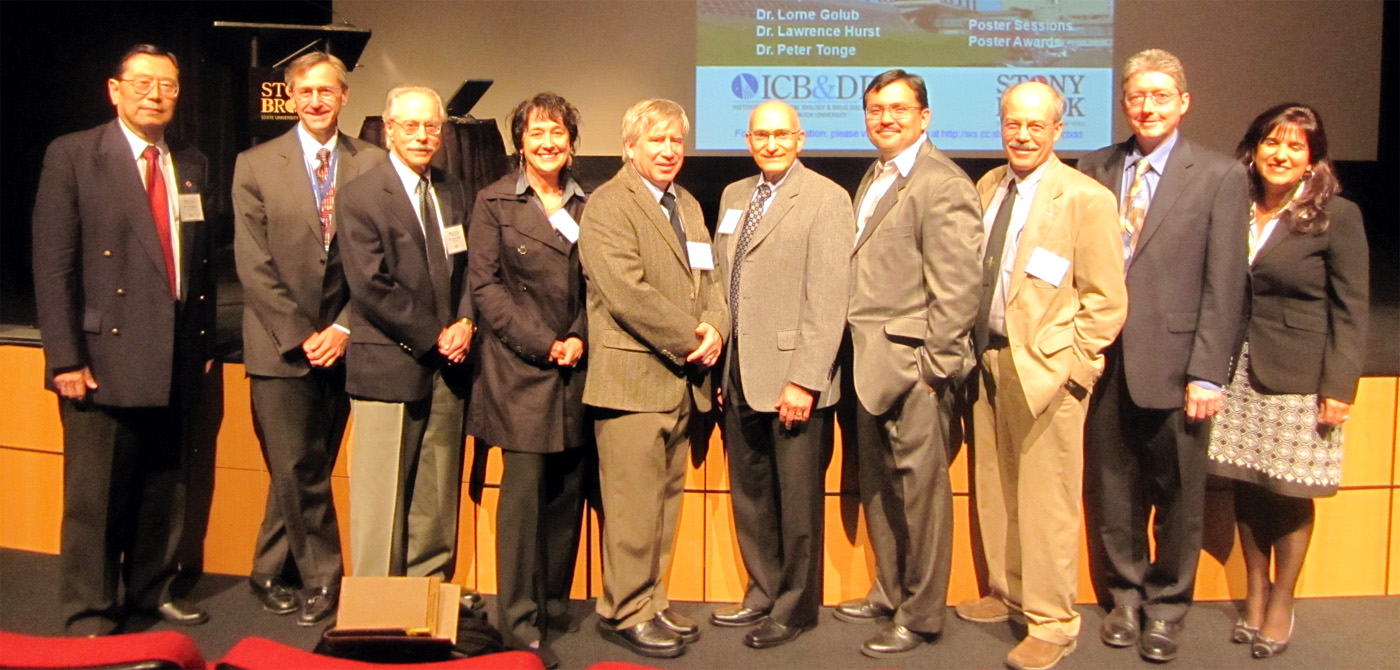 On Thursday, October 14, 2010, The ICB&DD hosted its fourth ICB&DD Annual Symposium,
“Drugs, Biologics, Devices, and the FDA” at the Charles B. Wang Center at Stony Brook
University. The symposium featured five distinguished Plenary Lecturers and three
Invited Speakers from Stony Brook University. The event was very well attended by
a wide range of audience from faculty, research staff and students on campus as well
as Brookhaven National Laboratory, universities and industries in the greater NY metropolitan
area. The Poster Session equally attracted a broad participation of students from
Stony Brook University, New York University, OSI Pharmaceuticals and Brookhaven National
Laboratory among others. There were 69 papers presented at the Poster Session.
On Thursday, October 14, 2010, The ICB&DD hosted its fourth ICB&DD Annual Symposium,
“Drugs, Biologics, Devices, and the FDA” at the Charles B. Wang Center at Stony Brook
University. The symposium featured five distinguished Plenary Lecturers and three
Invited Speakers from Stony Brook University. The event was very well attended by
a wide range of audience from faculty, research staff and students on campus as well
as Brookhaven National Laboratory, universities and industries in the greater NY metropolitan
area. The Poster Session equally attracted a broad participation of students from
Stony Brook University, New York University, OSI Pharmaceuticals and Brookhaven National
Laboratory among others. There were 69 papers presented at the Poster Session.
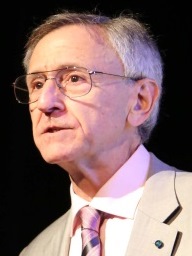 Dr. Maria Ryan, Professor and Chair of the Symposium Organizing Committee, opened
the Symposium and introduced Dr. Kenneth Kaushansky, Senior Vice President of the
Health Sciences and Dean, School of Medicine, Stony Brook University. Dean Kaushansky
gave very visionary remarks about the accomplishments and advances of the Stony Brook
School of Medicine, Hospital and its affiliates. He emphasized that the active participation
and collaboration of all clinicians and scientists is vital to make innovative medical
breakthrough possible. Dr. Ryan introduced Dr. Iwao Ojima, Distinguished Professor
and Director of ICB&DD. Dr. Ojima briefly summarized the accomplishments, current
and future goals of the ICB&DD. Dr. Francis Johnson, Professor of Chemistry introduced
the first Plenary Lecturer, Dr. Glenn Prestwich, Presidential Professor and Director,
Center for Therapeutic Biomaterials and Department of Chemistry, University of Utah.
He is a former Stony Brook colleague in chemistry, but also was the Director of the
Center for Biotechnology. Dr. Prestwich gave a lecture entitled “From Organic Chemistry
to Regenerative Medicine: Realizing the Promise of Translational Research”. He presented
how he implemented policies at the University of Utah encouraging faculty and student
entrepreneurial activities by describing two case studies for commercialization of
university technologies in the areas of regenerative medicine and inflammation modulation.
Dr. Richard Lin, Professor of Medicine, introduced the second Plenary Lecturer, Dr.
Jeffrey Pessin, the Judy R. and Alfred A. Rosenberg Professorial Chair in Diabetes
Research and Director of Diabetes Research Center, Albert Einstein College of Medicine.
He is the ex-chair of the Department of Pharmacological Sciences at Stony Brook University.
Dr. Pessin g
Dr. Maria Ryan, Professor and Chair of the Symposium Organizing Committee, opened
the Symposium and introduced Dr. Kenneth Kaushansky, Senior Vice President of the
Health Sciences and Dean, School of Medicine, Stony Brook University. Dean Kaushansky
gave very visionary remarks about the accomplishments and advances of the Stony Brook
School of Medicine, Hospital and its affiliates. He emphasized that the active participation
and collaboration of all clinicians and scientists is vital to make innovative medical
breakthrough possible. Dr. Ryan introduced Dr. Iwao Ojima, Distinguished Professor
and Director of ICB&DD. Dr. Ojima briefly summarized the accomplishments, current
and future goals of the ICB&DD. Dr. Francis Johnson, Professor of Chemistry introduced
the first Plenary Lecturer, Dr. Glenn Prestwich, Presidential Professor and Director,
Center for Therapeutic Biomaterials and Department of Chemistry, University of Utah.
He is a former Stony Brook colleague in chemistry, but also was the Director of the
Center for Biotechnology. Dr. Prestwich gave a lecture entitled “From Organic Chemistry
to Regenerative Medicine: Realizing the Promise of Translational Research”. He presented
how he implemented policies at the University of Utah encouraging faculty and student
entrepreneurial activities by describing two case studies for commercialization of
university technologies in the areas of regenerative medicine and inflammation modulation.
Dr. Richard Lin, Professor of Medicine, introduced the second Plenary Lecturer, Dr.
Jeffrey Pessin, the Judy R. and Alfred A. Rosenberg Professorial Chair in Diabetes
Research and Director of Diabetes Research Center, Albert Einstein College of Medicine.
He is the ex-chair of the Department of Pharmacological Sciences at Stony Brook University.
Dr. Pessin gave a very stimulating lecture entitled “Fyn-LKB1 Interaction as a Target for the
Treatment of Insulin Resistance and Obesity”, describing how a novel pathway linking
the tyrosine kinase Fyn to LKB1 function controls the activity of AMP-activated protein
kinase (AMPK). He also highlighted the advantages of targeting the Fyn/LKB1/AMPK pathway
for the treatment of metabolic diseases. Dr. Stanley Zucker, Professor of Medicine,
introduced the first Invited Speaker, Dr. Lorne Golub, Distinguished Professor, Department
of Oral Biology and Pathology, School of Dental Medicine, Stony Brook University.
Dr. Golub gave a lecture entitled “From Bench Top to Bedside: The Development of the
First FDA-Approved Matrix Metalloproteinase Inhibitor”. He summarized his research
on the application of tetracyclines (TCs) into new therapeutic formulations to reduce
pathologically excessive connective tissue breakdown, including bone resorption. He
is the inventor of Periostat® for the treatment of chronic periodontitis, as well
as Oracea® for the treatment of rosacea, a chronic inflammatory skin disease. Dr.
Isaac Carrico, Assistant Professor of Chemistry introduced the third Plenary Lecturer,
Dr. Barbara Imperiali, Professor, Department of Chemistry, and Massachusetts Institute
of Technology. Dr. Imperiali’s lecture was entitled “Fluorescent Tools for Chemical
Biology”. She presented her fascinating research on co-translational protein glycosylation
and the design and implementation of new chemical probes for the study of complex
biological systems. Dr. Stephen Walker, Associate Professor of Oral Biology and Pathology
introduced the second Invited Speaker, Dr. Peter Tonge, Professor, Department of Chemistry,
Stony Brook University. Dr. Tonge gave a lecture entitled “Slow Onset Inhibitors of
Bacterial Fatty Acid Biosynthesis: Drug-Target Residence Time, In Vivo Activity and
In Vivo Imaging”. He described his innovative research program on the design, synthesis,
and characterization of novel antibacterial agents for treating disease caused by
drug resistant bacterial pathogens such as methicillin-resistant Staphylococcus aureus
and multidrug-resistant Mycobacterium tuberculosis. Dr. Anil Dhundale, Executive Director,
Long Island High Technology Incubator, introduced the fourth Plenary Lecturer, Dr.
Harvey Arbit, President, Arbit Consulting, LLC and Adjunct Associate Professor, OVPR
Research Integrity and Oversight Programs, Department of Pharmaceutical Care, College
of Pharmacy, University of Minnesota. Dr. Arbit presented a lecture entitled “Investigator-Initiated
Clinical Trials: Where Do I Start?” His very informative lecture provided a comprehensive
view about the IND process and the obligations of an IND sponsor-investigator, with examples of how
things can go wrong and the consequences of non-compliance. Dr. Jian Cao, Associate
Professor of Medicine, introduced the third Invited Speaker, Dr. Lawrence Hurst, Professor
and Chair, Department of Orthopaedics, School of Medicine, Stony Brook University.
Dr. Hurst gave a lecture entitled “Development of Xiaflex for Dupuytren’s Disease”.
He presented a comprehensive and informative lecture, describing his innovative research
on the safe and efficacious use of collagenase treatment in Dupuytren’s disease. He
discussed the initial proof of concept and preliminary investigations, leading to
the development of injectable clostridial collagenase, which obtained FDA approval
recently for the treatment of Dupuytren’s disease. Dr. David Green, Assistant Professor
of Applied Mathematics and Statistics, introduced the fifth Plenary Lecturer, Dr.
Francisco Villarreal, Professor of Medicine and Co-Director of the San Diego Institutional
Research and Academic Care Development Award, Professor for the Future, University
of California at San Diego. Dr. Villarreal gave a lecture entitled “Navigating Academia
and Technology Transfer Office: The Seeding of a New Biotech Start-up”. He presented
his research on the beneficial effects of cocoa flavanols and cardioprotective effects
of tetracyclines, which in the past few years led him to file several patents. He
described how, as a result of these research efforts, he co-founded Therapeutics Inc.
and Cardero Consumer Health Care Inc.
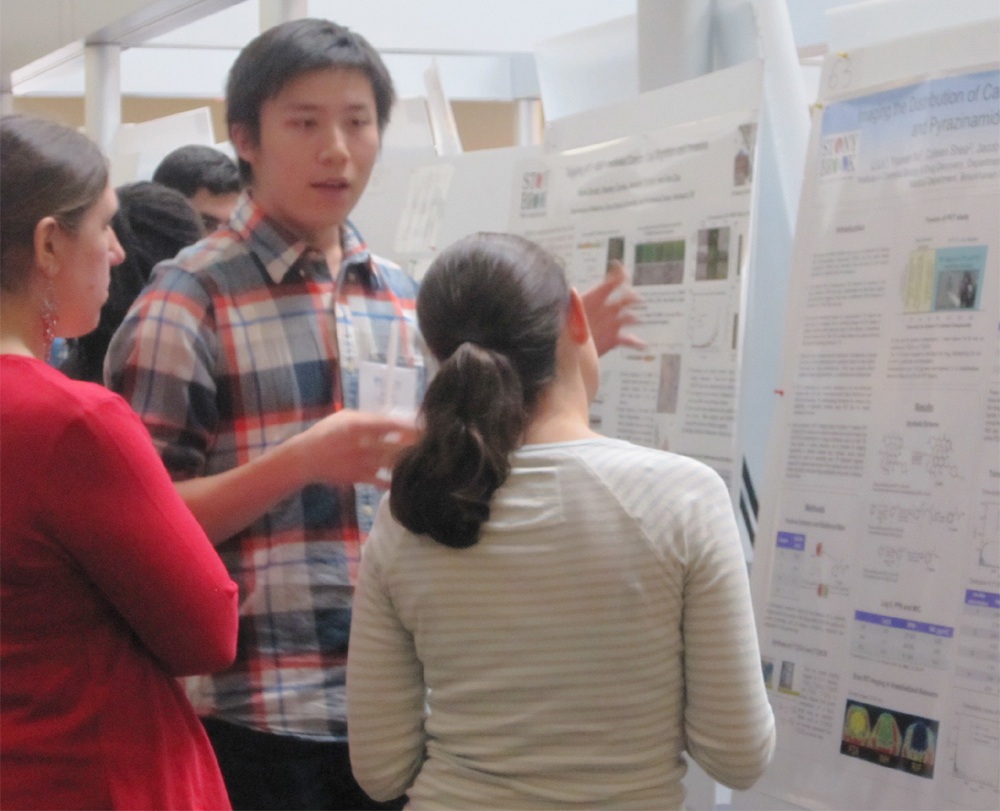
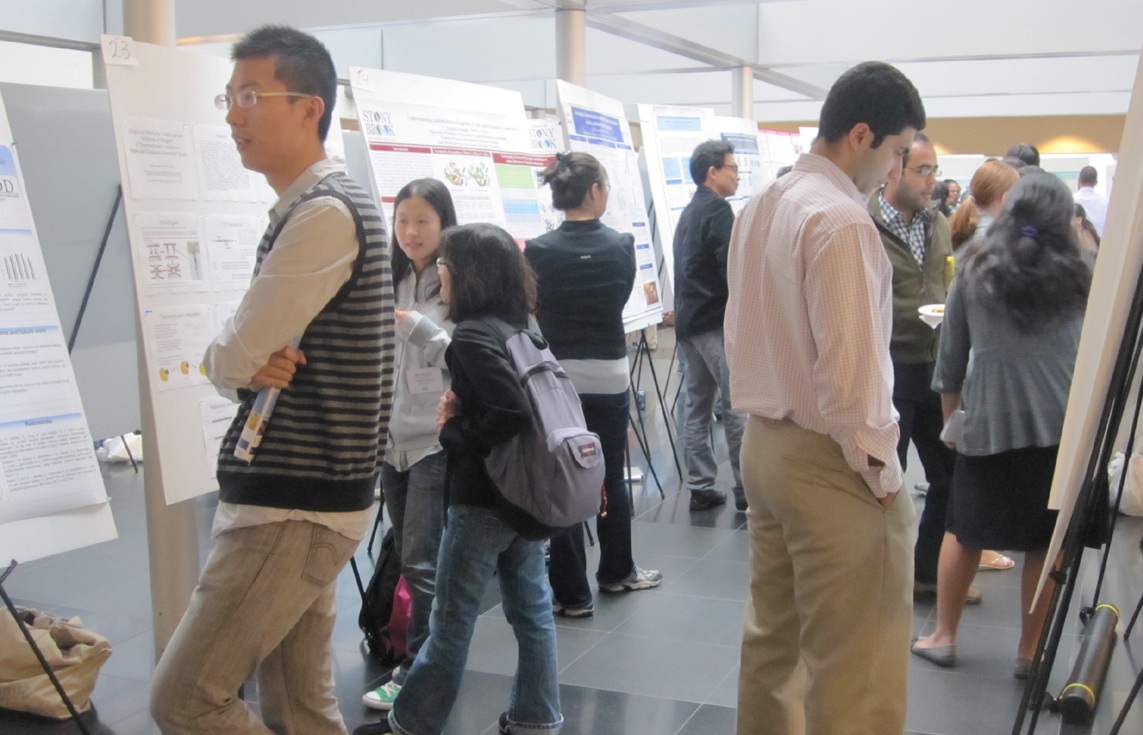
Dr. Ryan gave the closing remarks, thanking the Plenary Lecturers and Invited Speakers for their outstanding presentations as well as the Organizing Committee members for the successful planning and execution of the 4th Annual ICB&DD Symposium.
There were 69 papers presented at the Poster Session. The best two posters were selected
for the Poster Awards. The award-winning posters this year were by Kanishk Kapilashrami
from the laboratory of Dr. Tonge, Department of Chemistry, Stony Brook University
and by Mia Huang from Department of Chemistry, New York University.
The 4th ICB&DD Symposium culminated with a splendid dinner at the Chapel of the Charles B. Wang Center. Among other attendees were Dr. Eric Kaler (Provost), Dr. John Marburger (Vice President for Research), Dr. Kenneth Kaushansky (Dean, School of Medicine) and Dr. Benjamin Hsiao (Chair, Chemistry Department), who expressed their appreciation for the outstanding lectures presented at the Symposium. They all congratulated Professor Ojima for his numerous contributions and successful leadership of the ICB&DD.


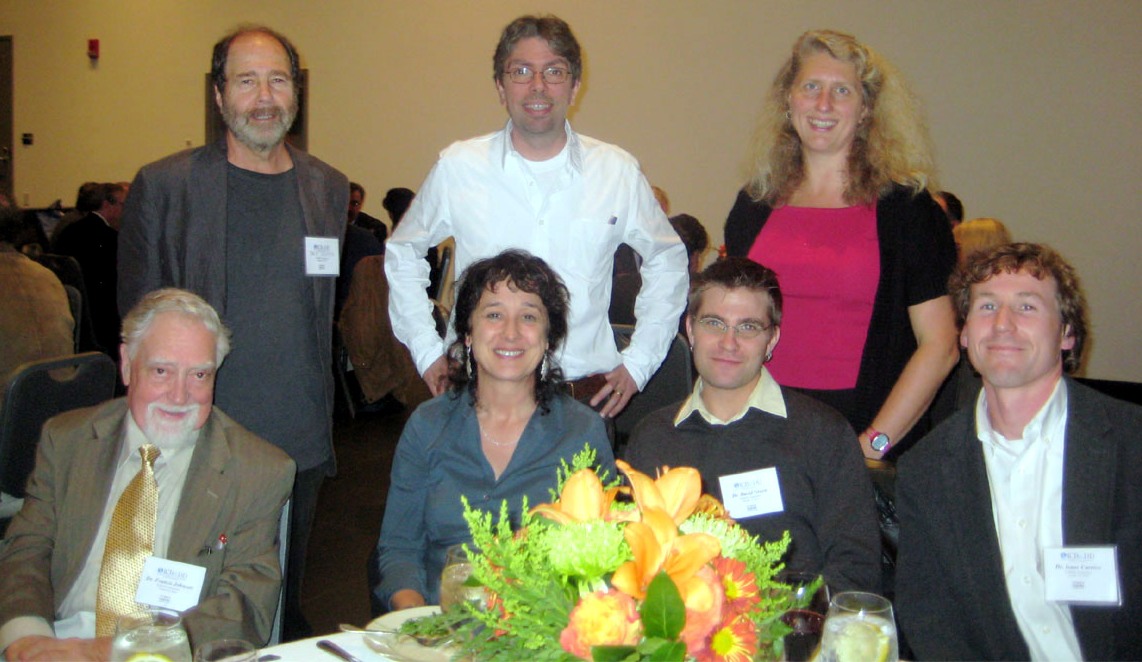
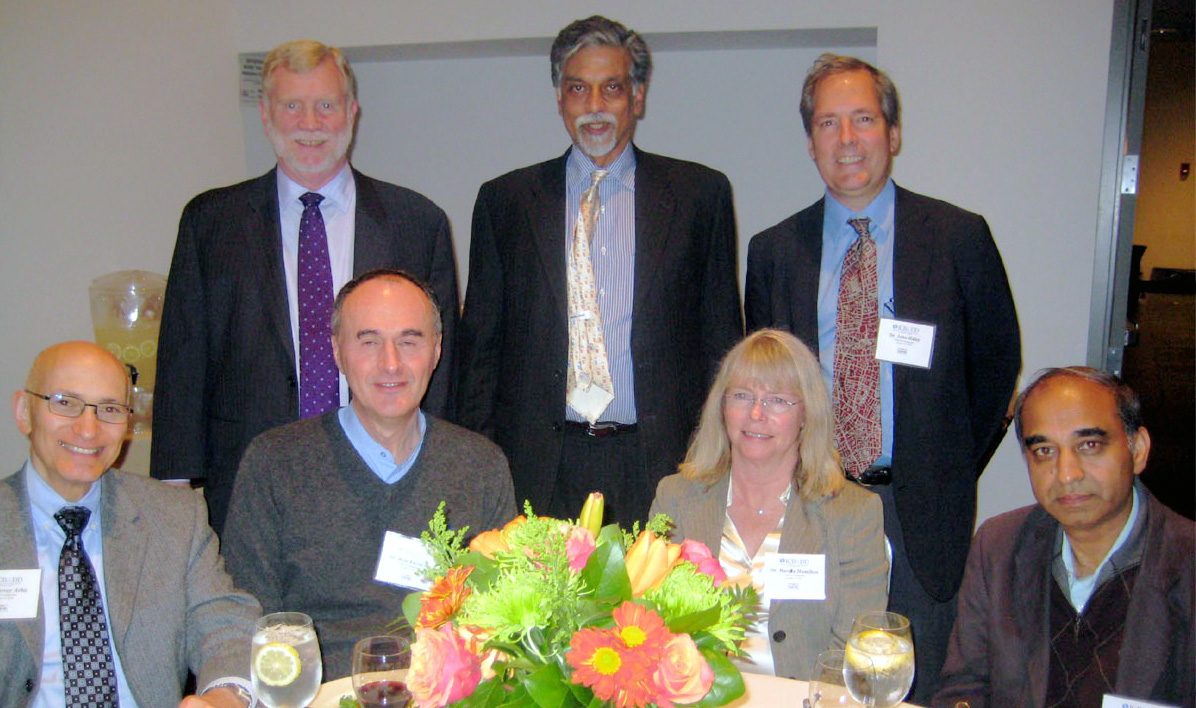
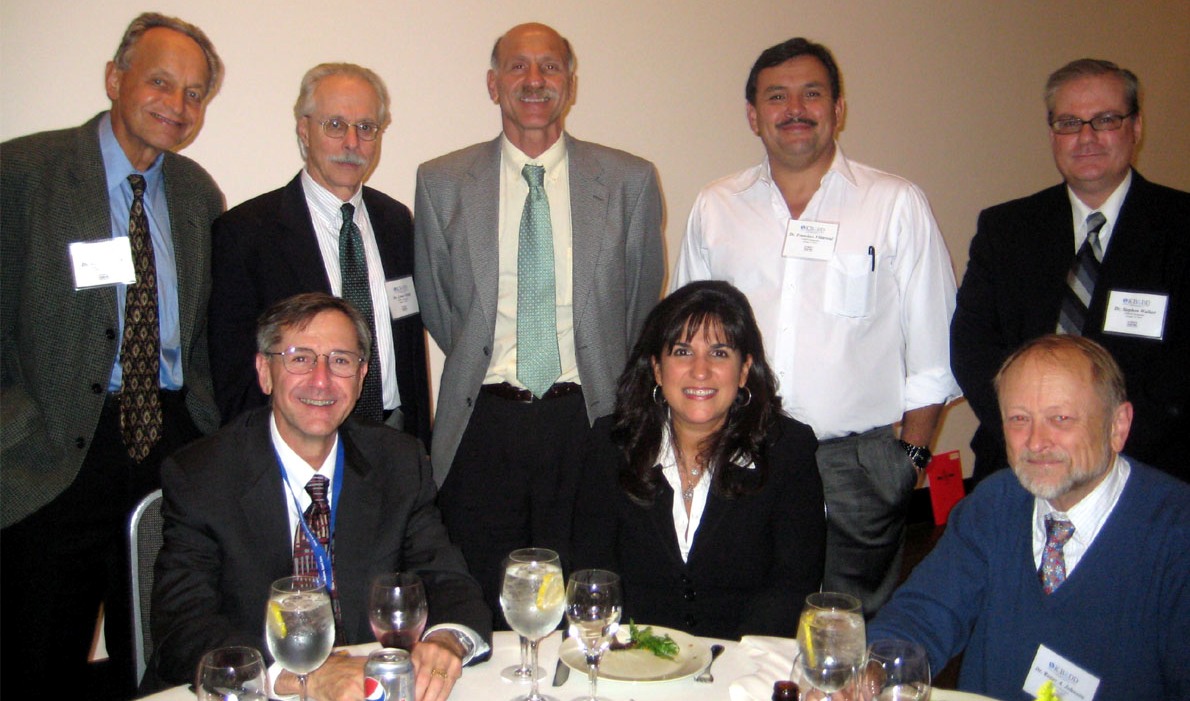
The symposium was cosponsored by the Office of the Vice President for Research, Office of the Provost, School of Medicine Office of Scientific Affairs, Department of Chemistry, OSI Pharmaceuticals, Inc., Forest Laboratories Inc. and Chem-Master International, Inc.
ICB&DD Third Annual Symposium (2009)
(From left to right: Drs. Iwao Ojima, John Koh, William Greenlee, Robert Haltiwanger, Charles Serhan, Daniel Raleigh, Stewart Fisher, Philip Low and Nicole Sampson)
On Tuesday, October 6, 2009, The ICB&DD hosted its third ICB&DD Annual Symposium,
“Frontiers in Chemical Biology and Drug Discovery” at the Charles B. Wang Center at
Stony Brook University. The symposium featured five distinguished Plenary Lecturers
and three Invited Speakers from Stony Brook University. The event was very well attended
by a wide range of audience from faculty, research staff and students on campus as
well as Brookhaven National Laboratory, universities and industries in the greater
NY metropolitan area. The Poster Session equally attracted a broad participation of
students from Stony Brook University, Yale University, Rockefeller University, OSI
Pharmaceuticals among others. There were 80 papers presented at the Poster Session.
Dr. Nicole Sampson, Professor and Chair of the Symposium Organizing Committee, opened
the Symposium and introduced Dr. Iwao Ojima, Distinguish
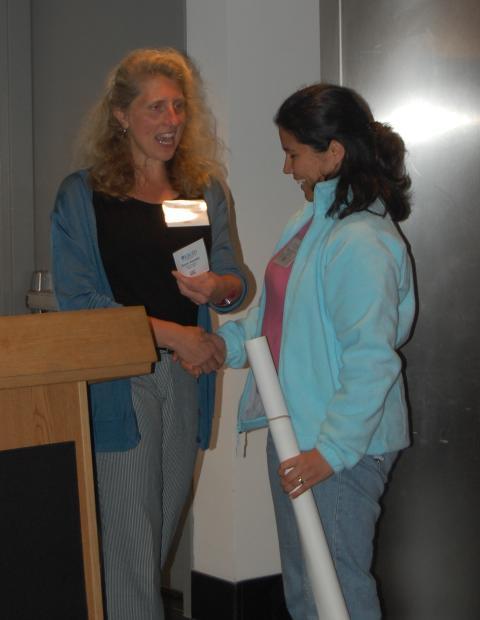
Dr. Sampson gave the closing remarks thanking the Plenary Lecturers and Invited Speakers for their outstanding presentations as well as enthusiastic participants for the success of the 3rd Annual ICB&DD Symposium. There were 80 papers presented at the Poster Session. The best two posters were selected for the Poster Awards. The award-winning posters this year were by Nadia A. Rana from the laboratories of Dr. Robert Haltiwanger (Biohemistry) and by Humeyra Taskent from Dr. Daniel Raleigh (Chemistry). The 3rd ICB&DD Symposium culminated with a splendid dinner at the Chapel of the Charles B. Wang Center. Among other attendees were Drs. Gail Habicht (Vice President for Research), Wadie Bahou (Vice-Dean for Scientific Affairs, School of Medicine) and Benjamin Hsiao (Chair, Chemistry Department), who expressed their appreciation for the outstanding lectures presented at the Symposium. They all congratulated Professor Ojima for his numerous contributions and successful leadership of the ICB&DD. The symposium was cosponsored by the Office of the Vice President for Research, Office of the Provost, School of Medicine Office of Scientific Affairs, Department of Chemistry, OSI Pharmaceuticals, Inc., and Chem-Master International, Inc.
ICB&DD Second Annual Symposium (2008)
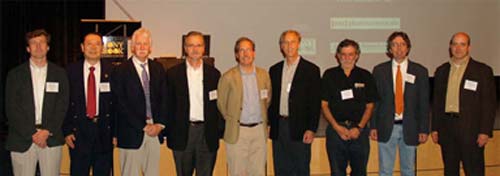 (from left to right) Drs. Isaac Carrico, Iwao Ojima, William Jorgensen, Yves Pommier,
John Haley, William DeGrado, Brian Chait, Robert Rizzo and Orlando Schärer.
(from left to right) Drs. Isaac Carrico, Iwao Ojima, William Jorgensen, Yves Pommier,
John Haley, William DeGrado, Brian Chait, Robert Rizzo and Orlando Schärer.
The ICB&DD presented its second ICB&DD Annual Symposium, “Frontiers in Chemical Biology
and Drug Discovery”, at the Charles B. Wang Center at Stony Brook University on October
10, 2008. The symposium featured five distinguished plenary lecturers and three invited
speakers. The symposium attracted a wide rage of audience from faculty, research staff,
and students on campus as well as Brookhaven National Laboratory and industries in
the greater NY metropolitan area. Dr. Orlando Schärer, Associate Professor of Chemistry
and Pharmacology and Co-Chair of the Symposium Organizing Committee introduced Dr.
Ojima, Distinguished Professor and Director of ICB&DD, who briefly summarized the
successful establishment, accomplishments and current goals of the ICB&DD. Dr. Stanley
Zucker, Professor Department of Medicine, introduced the first plenary lecturer, Dr.
John Haley, Senior Research Director of Translational Research at OSI Pharmaceuticals.
Dr. Haley presented his lecture on “ Rational Anti-Cancer Drug  Combinations and Tyrosine Kinase Inhibitors Resistance”, providing a comprehensive
view of his research centered on drug target pathway identification and biomarker
discovery through understanding of epithelial-mesenchymal transition and cancer recurrence.
Dr. Robert Rizzo, Assistant Professor of Statistics and Applied Mathematics, introduced
the second plenary speaker and his former Ph.D. mentor, Dr. William Jorgensen, Professor
of Chemistry at Yale University. Dr. Jorgensen’s presentation on “Computer-Aided Drug
Lead Generation and Optimization” was a very inspirational talk that highlighted his
research accomplishments as a pioneer in the field. Dr. Carlos Simmerling, Associate
Professor of Chemistry, introduced Dr. Robert Rizzo as SBU’s first invited speaker.
Dr. Rizzo presented “Origins of Drug Resistance using Computational Methods”, describing
how his research laboratory, utilizing “computational structural biology” strategies,
is identifying small molecules that can be used as anti-cancer agents or as antiviral
inhibitors for HIV and influenza. Dr. Orlando Schärer introduced the third plenary
lecturer, Dr. Yves Pommier, Chief, Laboratory of Molecular Pharmacology of the National
Cancer Institute. Dr. Pommier’s lecture was on “Topoisomerase I: Campothecins and
Beyond”. Dr. Pommier is internationally recognized for his work on the elucidation
of the function of topoisomerases as targets for anticancer drugs. The second SBU
invited speaker, Dr. Galina Botchkina, Associate Professor, Department of Surgery,
was introduced by Dr. Nicole Sampson, Professor of Chemisty. Dr. Botchkina gave a
lecture on “Novel Target for Anti-Cancer Drug Development: Cancer Stem Cells”, describing
how her research group seeks to study the development of specific assays for early
noninvasive molecular detection of cancer and the development of cancer stem cell-targeted
therapies. Dr. Elizabeth Boon, Assistant Professor of Chemistry, introduced the fourth
plenary lecturer, Dr. William DeGrado, Professor of Biochemistry and Biophysics at
University of Pennsylvania and Member of the National Academy of Sciences. He gave
a comprehensive and enthusiastic lecture on “Analysis and Design of Membrane Proteins”.
Dr. DeGrado enlightened the audience by presenting how his research group studies
molecular design as an approach to understanding macromolecule structure and function.
His interest in de novo design of proteins has proven to be a useful approach for
understanding the characteristics in a protein sequence that causes them to fold into
their unique three-dimensional structures. Dr. Roger Johnson, Professor of Biophysics
and Physiology, introduced the third
Combinations and Tyrosine Kinase Inhibitors Resistance”, providing a comprehensive
view of his research centered on drug target pathway identification and biomarker
discovery through understanding of epithelial-mesenchymal transition and cancer recurrence.
Dr. Robert Rizzo, Assistant Professor of Statistics and Applied Mathematics, introduced
the second plenary speaker and his former Ph.D. mentor, Dr. William Jorgensen, Professor
of Chemistry at Yale University. Dr. Jorgensen’s presentation on “Computer-Aided Drug
Lead Generation and Optimization” was a very inspirational talk that highlighted his
research accomplishments as a pioneer in the field. Dr. Carlos Simmerling, Associate
Professor of Chemistry, introduced Dr. Robert Rizzo as SBU’s first invited speaker.
Dr. Rizzo presented “Origins of Drug Resistance using Computational Methods”, describing
how his research laboratory, utilizing “computational structural biology” strategies,
is identifying small molecules that can be used as anti-cancer agents or as antiviral
inhibitors for HIV and influenza. Dr. Orlando Schärer introduced the third plenary
lecturer, Dr. Yves Pommier, Chief, Laboratory of Molecular Pharmacology of the National
Cancer Institute. Dr. Pommier’s lecture was on “Topoisomerase I: Campothecins and
Beyond”. Dr. Pommier is internationally recognized for his work on the elucidation
of the function of topoisomerases as targets for anticancer drugs. The second SBU
invited speaker, Dr. Galina Botchkina, Associate Professor, Department of Surgery,
was introduced by Dr. Nicole Sampson, Professor of Chemisty. Dr. Botchkina gave a
lecture on “Novel Target for Anti-Cancer Drug Development: Cancer Stem Cells”, describing
how her research group seeks to study the development of specific assays for early
noninvasive molecular detection of cancer and the development of cancer stem cell-targeted
therapies. Dr. Elizabeth Boon, Assistant Professor of Chemistry, introduced the fourth
plenary lecturer, Dr. William DeGrado, Professor of Biochemistry and Biophysics at
University of Pennsylvania and Member of the National Academy of Sciences. He gave
a comprehensive and enthusiastic lecture on “Analysis and Design of Membrane Proteins”.
Dr. DeGrado enlightened the audience by presenting how his research group studies
molecular design as an approach to understanding macromolecule structure and function.
His interest in de novo design of proteins has proven to be a useful approach for
understanding the characteristics in a protein sequence that causes them to fold into
their unique three-dimensional structures. Dr. Roger Johnson, Professor of Biophysics
and Physiology, introduced the third  SBU invited speaker, Dr. Isaac Carrico, Assistant Professor of Chemistry. Dr. Carrico’s
presentation on “A Chemical Approach to Virus Engineering” described how his research
group utilizes chemical tools to study fundamental physiological processes and develop
novel therapeutics. Finally, Dr. Robert Haltingwager, Professor and Chair of Department
of Biochemistry, introduced the fifth plenary lecturer, Dr. Brian Chait, Professor
and Director of the Mass Spectrometric Biotechnology Research Resource at the Rockefeller
University. Dr. Chait gave an informative and stimulating lecture on “Protein Interactions
as a Window into Cellular Function”, outlining his research on the development of
biochemical tools, especially mass spectrometry-based tools, for studying protein
interactions and its applications to the functional definition of cellular protein
assemblies. Dr. Orlando Schärer gave the closing remarks thanking the plenary and
invited speakers for their outstanding presentations and Professor Ojima for the success
of the 2nd Annual ICB&DD Symposium.
SBU invited speaker, Dr. Isaac Carrico, Assistant Professor of Chemistry. Dr. Carrico’s
presentation on “A Chemical Approach to Virus Engineering” described how his research
group utilizes chemical tools to study fundamental physiological processes and develop
novel therapeutics. Finally, Dr. Robert Haltingwager, Professor and Chair of Department
of Biochemistry, introduced the fifth plenary lecturer, Dr. Brian Chait, Professor
and Director of the Mass Spectrometric Biotechnology Research Resource at the Rockefeller
University. Dr. Chait gave an informative and stimulating lecture on “Protein Interactions
as a Window into Cellular Function”, outlining his research on the development of
biochemical tools, especially mass spectrometry-based tools, for studying protein
interactions and its applications to the functional definition of cellular protein
assemblies. Dr. Orlando Schärer gave the closing remarks thanking the plenary and
invited speakers for their outstanding presentations and Professor Ojima for the success
of the 2nd Annual ICB&DD Symposium.
There were 59 papers presented in the Poster Sessions and two posters were selected for the first and second place prizes. The award-winning posters this year were from the research laboratories of Drs. Peter Tonge (Chemistry) and Carlos Simmerling (Chemistry).
The Symposium Dinner at the Chapel of the Charles B. Wang Center culminated the evening of the successful event. Dr. James Staros, Dean, College of Arts and Sciences, briefly enlightened the dinner invitees with the historic accomplishments of Stony Brook University from its very beginnings as SUCOLI (Stony Brook University College of Long Island) to what Stony Brook University is now. Dr. Staros congratulated Professor Ojima for his leadership and the successful establishment of the ICB&DD.
The ICB&DD acknowledges the financial support from the Office of the Vice President for Research, School of Medicine Office of Scientific Affairs, Department of Chemistry, OSI Pharmaceuticals, Inc., and Forest Research Laboratories, Inc.





ICB&DD Inaugural Annual Symposium (2007)

 On October 12, 2007, the ICB&DD hosted its inaugural ICB&DD Annual Symposium, entitled
“Frontiers in Chemical
On October 12, 2007, the ICB&DD hosted its inaugural ICB&DD Annual Symposium, entitled
“Frontiers in Chemical
Biology and Drug Discovery”, which was held at the Charles B. Wang Center at Stony
Brook University. The event was extremely well attended by faculty, staff and students
on campus as well as researchers from Brookhaven National Laboratory (BNL). Dr. Ojima,
Distinguished Professor and Director of ICB&DD introduced the first speaker, Dr. B.
Horwits, Distinguished Professor, Albert Einstein College of Medicine and a Member
of the National Academy of Sciences, who presented her lecture on “Taxol, Tubulin
and Tumors: Challenges in the New Era of Cancer Therapeutics”. This informative and
inspiring talk recounted Dr. Horwits’ pivotal and pioneering research on taxols that
in the 1980’s, led to the development of paclitaxel, one of the most important anticancer
agents ever developed. Peter Tonge, Professor of Chemistry, introduced the second
speaker, Professor, Vern Schramm, Albert Einstein College of Medicine and a Member
of the National Academy of Sciences. Dr. Schramm’s presentation, “Drug Design from
Enzymatic Transition States”, was a stimulating lecture on his detailed methodology
of elucidating exact transition-state structures of enzyme-catalyzed reactions, which
led to the development of powerful and selective inhibitors as potential drugs.
 Todd Miller, Professor of Physiology and Biophysics, introduced the third speaker,
Professor Philip Cole, Johns Hopkins University, who gave a comprehensive and enthusiastic
lecture on “Chemical Approaches to sorting out Histone Modifications”. Dr. Cole outlined
his research accomplishments on chemical and biochemical approaches in the study of
signal transduction and gene regulation. Finally, Dr. Maria Ryan, Professor of Oral
Biology and Pathology, was proud to introduce Dr. Barry Coller, Vice-President for
Medical Affairs and Physician-in-Chief, The Rockefeller University. Dr. Coller, who
was a familiar face to Stony Brook as he had previously been a faculty member at Stony
Brook University School of Medicine, was delighted to give a lecture to all his former
colleagues and students on“Application of High Throughput Screening and Molecular
Docking to Identify Novel Inhibitors of Integrin allbβ3”. Dr. Coller’s current research
focuses on multiple areas of platelet physiology. Dr. Coller was the inventor of the
very first drug FDA approved developed at Stony Brook University, Reopro (angina medication),
and his lecture was a splendid culmination of the ICB&DD symposium.
Todd Miller, Professor of Physiology and Biophysics, introduced the third speaker,
Professor Philip Cole, Johns Hopkins University, who gave a comprehensive and enthusiastic
lecture on “Chemical Approaches to sorting out Histone Modifications”. Dr. Cole outlined
his research accomplishments on chemical and biochemical approaches in the study of
signal transduction and gene regulation. Finally, Dr. Maria Ryan, Professor of Oral
Biology and Pathology, was proud to introduce Dr. Barry Coller, Vice-President for
Medical Affairs and Physician-in-Chief, The Rockefeller University. Dr. Coller, who
was a familiar face to Stony Brook as he had previously been a faculty member at Stony
Brook University School of Medicine, was delighted to give a lecture to all his former
colleagues and students on“Application of High Throughput Screening and Molecular
Docking to Identify Novel Inhibitors of Integrin allbβ3”. Dr. Coller’s current research
focuses on multiple areas of platelet physiology. Dr. Coller was the inventor of the
very first drug FDA approved developed at Stony Brook University, Reopro (angina medication),
and his lecture was a splendid culmination of the ICB&DD symposium.

 Dr. Richard Fine, Dean of the School of Medicine, was on hand to congratulate the
students and faculty for the outstanding work presented in the poster sessions. From
the 43 posters, two were selected for the first and second place prizes. The award-winning
posters described research from the laboratories of Drs. Peter Tonge (Chemistry) and
Isaac Carrico Chemistry).
Dr. Richard Fine, Dean of the School of Medicine, was on hand to congratulate the
students and faculty for the outstanding work presented in the poster sessions. From
the 43 posters, two were selected for the first and second place prizes. The award-winning
posters described research from the laboratories of Drs. Peter Tonge (Chemistry) and
Isaac Carrico Chemistry).



The evening concluded with a wonderful banquet at the Zodiac Gallery in the Wang Center.
Among other invitees
were Drs. Gail Habicht (Vice President for Research ), Richard Fine (Dean, School
of Medicine), Carl Anderson (Chair,
Biology BNL) and Ben Hsaio (Chair, Chemistry Department), who all congratulated the
successful establishment of
ICB&DD and praised Professor Ojima for his leadership and vision, which brought together
truly interdisciplinary and
productive collaborations between East, West and South campuses as well as BNL.





The symposium was cosponsored by the Office of the Vice President for Research, School of Medicine Office of Scientific Affairs, Department of Chemistry, Schering-Plough Pharmaceutical Research Institute, OSI Pharmaceuticals, Inc., and Forest Laboratories, Inc.

